Zomonoga
The End of the Known World
Zomonoga (Walieeve and Xihi'vanhi: Xomo-NOGAH), also known as the Zomonogan Samaraate, is a nation primarily located in continental Western Illica, an empire that stretches from the outer isles of Maritime Illica to the great whipping winds of the Zomonogan Jungle. The name “Zomonoga” comes from the name of the great north-flowing river known as the Zomonog, which in turn comes from the Classical Xihi'vanhi word xomoṅog which means “great tide” or “great force.” Bounded by the great Satin Ocean to the north and surrounded by the Bay of Qualio to the east, it sits abut to the realms of the Qyn Metropolitan Republic and Quarthmos to the northeast, surrounded also by Lgzar, and southwest of it is the Satin Isles. The nation's capital is Xi’an, which is also the largest city in population, holding a population of about one million people, according to a yearly census taken in 2997. From here sits the Zomonogan seat of government known as the Samaraate, as well as the Samaraat, an honorary Xi'hivanhi title for the constitutional and theocratic monarch of Zomonoga. The word "samaraat" comes from the Old Xi'vanhi root word sama which means to serve and raat, which means to lead, denoting a position higher than a king and more equivalent to an emperor. According to widely held legend, during Zomonoga's Pre-Classical Era (circa 15,000 - 9600 BU), Central Zomonoga was dominated by a God-Kingdom lead by a series of God-Kings, the first being Kiyarvarim I. According to Callhai tradition, these “God-Men” or “God-Kings” lived for hundreds of years and some even thousands of years, ruling with an iron fist for centuries and millennia. This was so until the last king belonging to the line of God-Kings, Kiyarvarim XVII, was overthrown by Javaybagata the Great, who crowned himself the first Samaraat, or monarch of Zomonoga. He is credited with establishing what is known as the First Samaraate, or the first Zomonogan government/era that he founded. Since then, various Samaraates have come and gone in Zomonoga the first being the First Samaraate also known as the Javaybagtan Samaraate, the Second Samaraate defined by the temporary schism of north and south Zomonoga as both had chosen different Samaraats, and the last two defined by the unification of Zomonogan into a single, holy polity. It is often monikered "The Beginning and End of All Known Civilization" as it is on the edge of the world that is known, it is here that striders[1] end their ventures, as man knows not what lies west of Zomonoga. Considered by some to be one of the most memorable and potent civilizations of the modern world, its wealth is only to be contested by the maritime republic of Quarthmos and the Golden Empire of Lyn. Its main rival, the Northern Oceanic Empire sits northeast of it, its endonym being the Olosian Empire. Currently, it has hold of the archipelago known as the Jin Isles, compromising the isles of Jin Qin, Jin Buin, and Jin Gwain, those belonging to the emperor and conqueror Jin the Conqueror (387 BU — 342 BU) as well as several penal colonies and minor exile territories overseas. To the west of Zomonoga is Sorgaë, the ancient power that often engages with trade with the Illicans. Its capital, Xi’an, contains a rich history of spirituality, religion, architecture, and culture, known for its distinctive architecture of magnificent exquisitely carved prangs and stupas. Zomonoga's most notable and essential exports include saffron, cardamom, myrrh, incense, curry, delivered upon great ornate ships known as redliners (informally) upon the sea and exported to realms across the Satin Ocean, the Sunset Sea, and the Midlandic Ocean, to realm and kingdoms that for millennia would have been unfathomed by them. It is ruled by a legendary Samaraat, a grand oceanic emperor who sits from his palace consisting of several great prangs (towers) which he calls, the Sons of the Samaraah.
| Contents |
|---|
1 Geography
|
Geography
When the Zomonog's trail runs low and this river begins to perish, so shall ZOMONOGA8. By the time these words have come to past, not one iota of this sentence will have been remembred9." [The Phai´- gryan Scriptures, Burge 5:8-9] —— GREAT PHAIGRYA, 9543 BU, at the GREAT PROPAGATION, at the God-King palace of KIYARVARIM I.ZOMONOGA IS BORDERED BY THE CITY-STATE OF QUARTHMOS TO THE EAST, Nathenii, and shares an independent city-state of Qyn. It is located in the respective Western and Southern Hemisphere of Duxur approximately 470° S' and 600° W', 500 kilometers south of the equator (193.051 sq. mi) and 300 miles away from the Southern Polar Cap. Due to its immensity, Zomonoga holds a vast array of diverse lands and climates, a land of grand, awe-inspiring vistas. Its topography has excellent variation, some of which include white deserts subject to whipping winds, highlands, sun-kissed plateaus, endless plains, jungles full of white tigers, and painted mountains. At the center of the great landmass there a river that holds credit for bringing one of the most potent and cultured nations on the face of Duxur: Zomonoga. Her name is the Zomonog, a name as ancient as Zomonoga itself, the namesake and mother of Zomonoga. Its course runs through the nation, the birthplace of the Zomonogeen people. The great prophet and teacher known as the Great Phaigrya once prophecied, "When is trail runs low and the river begins to perish, so shall Zomonoga." The river's course runs at approximately 2.388K mi. lg. and 2.4 km. wide, and its drainage basin covers about seven states under the Zomonogan Samaraate: Taeileye, Samaraveen, Gurukram, Dhakar, Lu’nah’diah, and Southern Banji. Its headwater originates from the southern half of Xi'an designated as the Zomonog's Mother, a relatively small lake whose sediment empties at the Phaigryan Delta, into the shallow beginnings of the Nai'nk and 90 miles north of the mouth of the Zomonog's origin. What has generally been considered the end of the Zomonog River is the Phaigryan Delta, which the delta where the Zomonog empties its sediment into the Nai’nk, the second large body of water that dictates much of Northern Zomonogan life and culture. The Zomonog has about twenty-eight tributaries, of which there are seven major tributaries, three of which surround the city of Xi'an, and the major tributaries consist of the tributaries Xia Mo, Xia To, The Fovaiyaii, the Jin Tributaries of Rucatta Jin, Herru, Puderpam, and Kaihore. Its offshoots provide fresh, drinkable water, and through an intricate system of aqueducts provides water for the provinces of Southern Zomonoga, mainly covering Gurukram, Taeileye, and much of Central Zomonoga. as well as transportation upon canoes, where crocodiles, river halleh ju’marthyas1, and rhinos can be hunted. The Zomonog is considered the most essential source of water for the nation for agriculture, commerce, and travel, the lifeblood of much interstate commerce as well as a means of transportation that striders and other foreign merchants use frequently. Goods from the Satin, Sunset, and Midlandic Oceans are hawked across the river, such as grain provided for by the Lynese Empire. Those that cross the river often do so by leviathan to avoid the unnatural dangers that traverse the Zomonog, such as violent animals or tides so violent they destroy ships. It moves parallel to the Nai'ink, the main form of transportation for Northern Zomonogans as well as the namesake for the city of Ni'an. at times even convergences with the great river. Such aquatic junctions do not happen often because they keep distance, though they are not as rare as native Ni'ano or Xi'ano might have you believe. The Zomonog is divided into two main regions, the Major Zomonog, and the Minor Zomonog. The Major Zomonog is home to many ancient sites and washed-up artifacts dating back as early as the Zomonogan Wetland Civilization (c. 15,000 BU), approximately 18,000 years ago. The Major Zomonog covers most of the area protected by the Zomonogan Samaraate, holding the sacred, the ancient, and ravaged ruins of God-King palaces. The Minor Zomonog courses the mostly unprotected place rarely navigated for fear of the wildlife. Notable ruins across the Major Zomonog include the alleged ruins of the mythical God-Queen's Palace, belonging to the God-Queens named the Dawn of the Purple Sun and the Bride of the Evernoon Sunset, the palace of the Fallen Star, and the original home of the first Samaraat Javayabagata, a pilgrimage site for the holy, the enlightened, and those on a quest to Perfect Enlightenment[2]. Amongst these ruins and great and weathered edifices of a forgone civilization can be found vast temples, winding steps into unending catacombs, unending grottoes, ruins of hundreds of Callhai shrines and prangs, ruins that are more lavish, and a lost city unfathomed by the likes of even those who dwell near the place. The Major Zomonog begins at the main two tributaries of the Mother, the tributaries Xia3 Mo, and Xia To, as well as many smaller cataracts the largest one being the Fovaiyaii, the one that flows into the bridge known as the Elephant's Burden. the Lun'nah'dian border where the river diverges into the harsh marshland of the province, the palace where the Minor Zomonog starts and ends abruptly in the Phaigryan Delta, flowing into the shallowest reaches of the Nai'nk. It then ends abruptly, not reaching the Twin Cities of Ni'an and Natrapali. There are three main Zomonog flood banks utilized by the Zomonogans for food growing, the Samaraat's Patch, the Callhai Seedling, and the Tarashuim Plains6. The Zomonog passes through each southern province from the Imperial Province of Samaraaveen that holds Xi'an, Mahnhit Tengalia, and Tax Moshi, the main source of food for the Zomonogan people since the early Zomonogans.
- halleh ju’marthyas1 the name of a large land animal in the Northern Zomonogan ecosystem.
- Perfect Enlightenment2. In Zomonogan culture, Perfect Enlightenment refers to a doctrine teaching of the goal of awakened intellect or enlightenment by following the ways of the Ninefold Tenets laid out by the prophet known as the Great Phaigrya.
- Xia3 Xia (945 — 963 AU) was a 10th-century nun who has been elevated to sainthood, known in Zomonogan culture as becoming a Verthukni, a pantheon of heroes venerated in Zomonogan culture. (More on the Verthukni later. See Capital 3.1 Architecture and City Layout, Verthukni. )
- The Samaraat's Patch4 The Samaraat's Patch is a large piece of land the Samaraat uses to cultivate large stocks of food for the needy and the disadvantaged, as philanthropy is an important part of the Samaraat's role.
- Callhai Seedling5
- Tarashuim Plains6
Administrative Divisions
Zomonoga is divided into eleven administrative provinces called sainowat (twelve if you count the Kumbawae province bought from the Quarthmoshi), with many minor colonies upon the western Illican Coast, each hosting a unique climate from the rest of Zomonoga. The official names of the states of Zomonoga are: Samaraaveen, comprising the cities of Xi'an Tax Moshi and Mahnhit Tengalia, Taeileye, Morio, Mandajula, Ghaugur, Fi'fifeeve, Amedosh, Dhakar, and Banji. Northern Zomonoga has a distinctly colder climate than the rest of Zommonoga, consisting of the provinces of Lu'nah'diah and Fif'fieeve, continuing up to the end of the Great Marshfold on the border of Central Zomonoga. Fif'fieeve has a generally warmer climate than the rest of its northern counterparts, located on the far western fold of Lu'nah'diah. It is barely inhabited besides small villages as well as small fishing towns such as Goahkajid, due to the monsoon season and the fear of having villages ravaged by floods from the nearby corner of the Satin Ocean, as well as rains brought from southeast from the Zomonog. Fif'fieeve is the beginning of the rocky terrain of West Zomonoga, known by Zomonogans as Jishwa Ishwoikagalya, meaning land of the rock, and covers about 723 miles, and can be traversed in about half a month by horseback if done with few to little breaks. This area mainly covers three rocky provinces, Morio, founded by the Moroan tribes ethnically distinct from those amongst West Zomonoga, the sandstone province, home to the longest architectural tradition in the world, of rock-cut architecture, and Ghagur, having rock landforms slowly progress into the Zomonogan jungle. Southern Zomonoga is the hottest region of Zomonoga, with Tax Moshi being the aridest of the Samaraaveen Trio made up of three cities, Xi'an, Tax Moshi, and Mahnhit Tengalia. Bordering Samaraaveen to the eastwards are the fertile valleys home to the holy provinces, Gurukram and Dhakar. They are divided by the stilt villages of Guru Patamai upon the border, fertile and well-watered with underground spring, unique to an Illican region, which is usually watered by nearby rains. Xi'an is distinct for its blazing summer spells and mildly windy winters, while its sister cities of Tax Moshi and Mahnhit Tengalia are known for mostly balmy weather throughout the year.List of Cities in Zomonoga
(Major Cities are in Bold)
Samaraveen
- Xi'an
- Tax Moshi
- Mahnhit Tengalia
Mandajula
- Karikalgalga
- Juidiv Mo
- Noritharukk
- The Mandaj
Morio
- Hutayukai
- Gunara
- Madharvan
Taeileye
- Mahnhit Gudivcar
Puru Gurukram
District of Guru Patamai
- Chune
- Roihigai Dosme
- Telahorea
- Hainipura To
District of Guru Modislavitta
- Roshavitta
- Bodik
- Monastery of Guru Amapuram
- Monastery of Guru Kwarrikkam
- Monastery of Guru Thanopal
Dhakar
- Kohore
- Thanj
Ghaugur
Note: Ghaugur is the only province without cities, populated by nomadic tribes and cultures and is rather divided by tribe than the city.
- Ruins of Calkata
- Jahore Tribe
- Gauh Tribe
Kumbawae
- Sunuaputha
- Kimbiyore
- Kantaorē
Lu’nah’diah
- Ni’an
- Natrapali
Fi’fifieeve
- Fi
Banji
- Cihinou
- Tamposh
Biodiversity
It has a large expanse of jungle called the Jungle of Zomonoga, twelve miles long and sixteen miles wide. It is below the headland that projects into the Swaben Strait, and to the peninsula's right is the Bay of the Quarilo, the name of a strange fish species that can lift entire waves above their head. Found in the Zomonogan Jungle are red jaguars with vicious tempers, tigers, pink cougars, as barrels of all sorts of primates swing between the vines, hanging from trees of polychrome leaves. Elephants (zwalla) can also be found here and are tamed, the Zomonogan's primary means of transportation, though they ride another kind of mount, a twaiileve, a large and rideable auroch species notably tame compared to other aurochs. Elephants can be found in Banji, near the western Zomonogan Jungle between the White Desert. Trampling the jungle are rhinoceroses, water buffaloes, and saltwater with crocodiles lurking in them. Tigers can be found in Lyal Lim, which is interpreted as "Sea of Tigers", and they are a reoccurring character in the Lyali tradition.Geographic Distribution
Originally a creature from the Lyali Rainforest and Wetland, the twi-sheeth thesomi is a brown-furred, tentacled creature now native to the Quarry Pits of Lyal and Sdomeg, a halfway between a camel and a centipede and occasionally used as a mount when traveling. Fifteen feet long, thirty feet wide, and five feet high, they have become of great use to the quarries of Lyal and Sdgomeg at the far edge of the empire. Twi-sheeth have an average lifespan of 25 years (in twi-theeth years Their necks are far longer than the rest of their bodies, and their faces are reminiscent of camels. They usually have camel-brown fur though those in the Lyali desert shed their skin more often, having a naturally scaled orange and black complexion. Twi-sheeth in the rainforest are naturally green and blue, and unlike desert twi-sheeth thesomi they have orns, convenient from cutting their ways through the forest though they can easily get stuck on the shrub areas of the Lyal rainforest. Due to the occupation of the terrain of the many valleys and rivers twi-sheeth called home, twi-sheeth gradually migrated from the valley and towards the Lyali desert, slowly adapted and changing towards their new environments, and developed a camel brown hue.| Name | Habitat | Length | Width | Height | Diet | Classification | Anatomy |
|---|---|---|---|---|---|---|---|
| Twi-sheeth thesomi | Lyali Rainforest, Desert | 15 ft. lg. | 30 ft. wd. | 5 ft. hi. | Droaik seeds twartwar eggs | Mammal | 3 brains, 2 hearts |
| halleh ju’marthya | Northern Zomonogan ecosystem | 12 ft. lg. | 12 ft. wd. | 7 ft. hi. | Halle preyplants | Amphibian | 1 brain,s 4 ears |
| twartwar | Lyali Desert | 7 ft. lg. | 3 ft. wd. | 12 in. hi. | Prudentongue leaves + sand | Lizard | 8 brains, eight hearts |
| vaakvavi | Mandaj Mount. | 66 ft lg. | 2 ft. wd. | 3 in. | rock, cacti, seeds, | Scanvenger lizard | 2 brains, eight webbed fingers |
| White monkey | Zomonogan Jungle |
Geo-economics
Zomonoga is nicknamed "The great player of the spice game", referring to its important role in the vast spice trade of the Satin, Midlandic, and Sunset Oceans, specifically for its role in its distribution of fresh spices of the spice trade, better known as the Spice Game1] The Spice Game refers to the trade, distribution, and competition of counties in the Western and Southern Hemisphere to be the highest in spice commerce across the Great Oceans [2]. Countries of the Eastern Hemisphere play a lesser role notably those of Yene Venanotian and Los Omar, who became lesser participants of the Spice Game, lesser because of their vast distance from the primary oceans of the spice trade. Such vast interconnected networks are possible only due to the domestication of leviathans for maritime trade and basilisks for mainland trade used for transportation and importation/exportation of goods across Duxur. Zomonoga is the leading Illican representative of the spice trade, ousting its neighbor nation of Quarthmos under the rule of Samaraat Gustmil Zai, the grandsuccessor1 of Marv Zai, the current Samaraat of Zomonoga. There are three main monsoons of Zomonogan travel, the most active being the Zomonogan Western Moonsoon, probably the most reliable monsoon when planing international trade. The ideal season to use the Western Moonsoon is in Spring, at Nahavij 17 - Tihariveenis 23, believed to be the most efficient monsoon for bringing large ships and leviathans towards the east, through the complex maze of northern Illican islands towards the eastern routes.Nutritional Geography
A great concentration of spice, Zomonoga and the islands it has dominion over have spread their spices across the world, growing a spice culture that spans across several oceans from the Midlandic Ocean to the Satin Ocean. Saffron is perhaps the most prized gift on the Satin Route second to the only satin, amongst many other spices each grown and packaged in a separate province. Saffron was one of the original crops grown on the Zomonog, used initially to disguise the rot of fish caught from the Zomonog. Its distribution stems from the Samaraaven province specifically the cities of Xi'an and Tax Moshi, while Mahnhit Tengalia's specialty is mainly cumin. Its origin is unknown, though it is commonly thought the plant was first grown by Southern Zomonogans, along with black pepper, around the 100th century BU, 300 years before the crowning of Samaraat Javayabagata (97th century BU) . Cinnamon, though lesser in quantity though with a greater sweetness, is better known by those on the coast of the Midlandic and Sunset Oceans, most notably Lyn, the Shaiyi, and Telopia. Cumin trade is an important business of Southern Zomonoga, as Zomonogans believe in the power of smell, for its therapeutic and even meditative effects on the body and used cumin based fumes for religious worship, grown mostly in the provinces of Dhakar and Gurukram and transported from there to Xi'an, to Tax Moshi and then to Mahnhit Tengalia. The greatest spice and most valued spice amongst the Zomonogans is cardamom, the essential ingredient for tea as well as a seasoning for curry. Tumeric originates from the province of Kumbawae and is a common ingredient in curry, first grown by the Quarthmoshi and eventually spread from there throughout the village of Central Zomonoga, and then, the capital city of Xi'an. The province of Ghaugur is a leading producer of tireflower, the name of a spice grown in the desert of Ghaugur and known for its hypnotic, addictive effects, often smoked in elaborate pipe-cigars and tusk cigars called gaulhil. Taeileye is the only province that does produce a spice, but rather sour types of fruit called taelxai, having the cities of the Samaraveen province being its main customer. Cinnamon and copper are traded for gold and salt. Amedosh, a land fruitful with coniferous forests provides the nation a large wood supply, having rich cedars and wood incense sold for religious and everyday use. as Black pepper specifically comes from Xi'an, grown first in the Famine of 2885 AU to disguise the taste of rats and roaches. The greatest contenders to the throne of the Spice Game are Zomonoga and Queng, each mass producers of saffron, grown upon their respective rivers of the Zomonog and the Que. Queng is its main rival when it comes to saffron trade, the main party in its Saffron Wars with Zomonoga. The Spice Race specifically refers to the competition of the two nations of Queng and Zomonoga. Queng has greater control over the Sunset Ocean, while Zomonoga has greater control of the Satin Ocean. The catalyst of globalization as well as worldwide commerce was the Empire of the Black Dragon ruled by Lateria, controlling both larges parts of the Satin and Midlandic Oceans. Before the domestication of leviathans for maritime trade, and basilisks for mainland trade, caravans were primarily used, exploiting camels as useful transport for many goods, particularly spice. Camels were first domesticated in the dunes of Los Omar, first for transportation, and then became great vessels of trade across the importation/exportation of goods across Duxur. Domesticating basilisks was a greater challenge, and it took about 17 years for the first one to be domesticated circa 1433 or 1432 BU, 1,400 years before the domestication of the first leviathan in Yene Venanotian. Despite their dominance in the spice game, others contend for the throne of the spice game, and others are too far to have much influence (Yene Venanotian for example.) The Shaiyi is one of these contenders. An ancient nation as powerful and beguiling as any of its neighboring counterparts, the Shaiyi is rather known for its fumes created from spice rather than seasonings, particularly balm, prudentnose, and most of all, daubtears. Gum is also a common good brought from the Shaiyi colored pink from prudentnose food dyes. The "Fruit Game" is a smaller scale trade based mainly on the maritime region of Northwest Illica, and ever since the Great Agreement of 2835 A.U., Zomonoga pulled many of its forces out of the region, not entirely, but allowed Zomonoga has kept a relatively small but notable presence in the region, exporting goods referred to as exotics, tropical fruit and livestock grown in the three large colonies of Jin1, Jin Buin, Jin Qin, and Jin Gwain. White gourds are a favorite delicacy amongst the elites of the island of Jin Buin, and have alcoholic properties when fermented, and is a mass-produced product across Northwest Maritime Illica. It is known to have an incredibly foul smell, belonging to a sort of fungi species, and is the result of selective breeding to give it its cream color, a cross between fireseed and purple-green mango. Goag eggs or goag seeds are a kind of fruit secreted by the goag creature, a creature half animal, half plant. Originally, goag eggs were covered in a purple rubbery rind, spotted with lemon-green dots, and its insides was protected by a large gas bubble that bursts when cracked open. Modern goag eggs have a fruit cast preferably a color between magenta and vermillion and are spotted with lilac. The demand for goag eggs is relatively small compared to the demand for white gourds and white gourd beer, though it has an exotic appeal because of its beguiling appearance and characteristics.__________________ 1Jin the Conqueror (387 BU — 342 BU) was a North-Illican conqueror, statesman, strider, and philosopher. Founder of the Great Jin Dynasty (355 BU — 93 BU), and nicknamed "Subduer of the Satin Ocean", Jin the Conqueror is widely considered one of the most talented military tacticians of all time, known for excessive punishments (e.g. his execution of 300 prisoners of war from insurrection and treason), his statements regarding war, conquest, and inspiring Jinik philosophy. He founded what is now known as the Jinese Empire, an archipelago of many isles under the jurisdiction of three main isles, His influence spans 33 centuries, an influence as well as inspiration to 1Rajābaan Xhyq I of Yene Venanotian (Xhyq the Conqueror) who expanded the nation of Yene Venanotian and founded the nation of qav-Sajukaiua. His daring but perhaps overambitious attempt to conquer Zomonoga was significantly faltered due mainly to poor environmental conditions, mainly the muddy northern winter of Northern Zomonoga. The Jin Dynasty lasted about 300 years until the last Jin Emperor, Quin Kwatikwar, was overthrown in the Jin Coup and replaced by a somewhat unstable regime known as the Quin-Seeking Autocracy, ruled by an assassin emperor who adhered to the ancient tradition of assassins known as the Rulied Cant2. There were about thirty-four emperors in all, the first half of emperors enjoying relatively peaceful and prosperous reigns, and the second half of emperors seeing tensions slowly build up until the Great Coup, thirty years before the birth of Lateria the Great in 63 BU. She, according to Jinese records interacted with the last living Jin descendants of the day. 1Rajābaan is the tile of the sovereign of Yene Venanotian.
Sparroutaugh - Sparroutaugh refers to a biological kingdom of multicellar eukaryotic organisms that border the line between animal and plant. Sparroutaugh have both animalistic and plant like characteristics, such as being planted but also indpendentlying laying eggs, groaning like an animal, and at times detaches itself from the ground in order to find food but returnsto the soil and acts as if it is a plant again, still as can be. Sparroutaugh is much more popular amongst moist enviroments and can be found mostly amongst Goags are a type of sparroutaugh that can be found mainly in parts of Zomonoga with some alternative forms growing in Yene Venanotian. About 60% of goags gets nourishment from its own waste. It has six erect straight panels that can glow blue or red depending on its spirit, and uses its colors to send telepathic messages through such panels and once recieving this information vicaiously will began toglow to set a message to its goag bretheren its understands. sometimes that plant slurps other creatures and plants around it just for the fun of it. It can be found in parts of Queng, Illica, and parts of the Satin Ocean.
Provinces and States
In the political union of Zomonoga, a province is an administrative division holding a separate governmental jurisdiction under Zomonogan sovereignty. Each Zomonogan province is governed by a governor or titular head known as a sainowatl, a title derived from the ancient Xi'havani word zainovātl meaning "overseer" or "watched." Modern Mainland Zomonoga is divided into twelve states, Morio, Mandajula, Ghaugur, Fi'fifeeve, Amedosh, Samarvareen, Dhakar, Gurukram, Taeileye, Banji, Kumbawae, and Lu'nah'diah. Each with a separate government known as a sainwat, the largest territorial and administrative unit of Zomonoga. Its capital province Samarvareen is comprised of the capital city of Xi'an, governed by the nation's leader and main tenurer known as the Samaraat, and the national congress considered a city-state that rules the nation, Maghnhit Tengalia, ruled by a municipal leader named the Maghn Highrayin, and Tax Moshi, governed by a council of agriculturally based merchants known as the Kaatxx. Morio is located in the large rocky region that is known as in the Zomonogan tongue Walieeve as Jishwa Ishwoikagalya, the of the oldest provinces of Zomonoga, monikered as Cauiheou Zhinaíthe or the Sluggish State, due to its insignifiant role in the many large events in Zomonogan history, and have developed a stereotype of being docile, obedient, and passive. Mandajula was once an independently-ruled kingdom until succumbing to the rule of Javayabagata II, allowing them to keep their then King (Kahlik), Aswat IV Mai-Zai (likely the distant ancestors of the modern Zai clan of Zomonoga) if they subscribed to Callhai Law and Faith. The Mandajulan Reform reflects Mandajula's violent evolution from a monarchy to a semi-autonomous state ruled by a sainowatl, though Mandajulans were not willing to leave the pomp and glorification of a leader, as it had been their tradition for more than a dozen thousand years at that point. For about 500 years after the conquests of Jin the Conqueror, the Jin isles were under suzerainty to the Zomonogan Samaraate, until under the rule of Samaraat Nagabata, the Jin isles became official states under the Zomonogan Samaraate.List of States Under the Zomonogan Samaraate:
| Sanwat | Capital | Sigil | Motto | Founded | Districts | Language |
|---|---|---|---|---|---|---|
| Samaraveen | Xi'an | Elephant | "Hearken and Heed" | 9688 BU |
|
Walieeve |
| Gurukram | Chune | Rhino | Adhere, Accept, Submit, Sacrifice, | 9687 BU | Guru Patamai • Guru Modislavitta | New Xi’havani |
| Taeileye | Mahnhit Gudivcar | Mouflon | An Callha nihim dhan’yada "An Callha is Good." | 9687 BU | Rojridadaaipur • Mahn District | Walieeve |
| Ghaugur | Phiomn Phei | Sand Quagga | No man knows without asking or seeking. | 9837 BU | Jahore Plains • Gauh Tribe | Ghaugur-Walieeve Creole |
| Mandajula | The Mandaj | Camel | Takatta ate ouran dei hun, meaning Take up arm and hoof, for the Sandstone Kingdom. | 9991 BU | Mandaj District • Karuk • Judivmovia | Mandajulan Walieeve |
| Morio | Madharvan | Laughing Owl | You must eat if you want to be able to continue the journey. | 10,000 BU | Madharvan District • Hutakaian League • Naelby | Walieeve |
| Kumbawae | Kimbiyore | Great Thylacine | "The Quarthmos of Zomonoga" | 555 AU | Sunaputha • Kimbiyore | Quarthmosi-Walieeve Creole |
| Fi’fieeve | Fi | Golden Toad | Sinyaritta seriuch raj "You have only nothing to lose here." | 9687 BU | Jishwa Fi | Walieeve |
| Dhakar | ||||||
| Lu’nah’diah | ||||||
| Banji | ||||||
Government
The Land of the God-Kings has now passed its power to a avatar, incarnation of the Great Hallowed Saravahai, the Great Emperor, The King of Kings below An Callha, the King of King of Kings." — Anynomous, written sometime during the Candelibrium Epoch[1], most likely the last God-King Yhaou better known by his reigning name Kiyarvarim XVII, (a.e, circa 10th millenium B.U.)
Samaraat
The nation of Zomonoga is ruled by the Great Samaraat, an honorary Zomonogan title for the constitutional monarch of Zomonoga. He is considered the head of state, governing the nation of Zomonoga and leading his country on a path of higher holiness, mediation, and enlightenment. Legend states that a series of legendary God-Kings ruled Zomonoga, ruling for centuries and even millennia at a time, until the last God-King, Kiyarvarim XVII (Known in Callhai mythology as the Wind Belonging to the Sun), was overthrown by Javayabagata II also known as Javayabagata the Great, thus beginning the rule of the Samaraats. The female equivalent of a Samaraat is the Samaraah, a title also used to address the queen consort of His Holiness. Though it is common among Samaraats to not marry (and for some to even become eunuchs) to be able to fully devote themselves to their duty and faith, it is not a requirement and as it once was.
Blessed with long life and good health, each God-King's reign saw hundreds of generations, establishing the Callhai Faith before the beginning of the Samaraatic tradition and leaving behind a legacy of spiritual metamorphosis, the act of leaving behind one’s human instinct for violence and becoming a disciple of An Callha (The Great Elephant) and the Great Phaigrya (also known as the Great Auroch. But, like the Avatar Candaces that ruled Lyn, they became out-of-touch with common needs, and Zomonogans felt that in order for the nation to grow, centuries under one God-King with the same ideals and economic policies would strain Zomonogan cultural and spiritual growth, craving for a leader with knowledge of both An Callha’s Realm and the Realm of Men.
What were the God-Kings like?
The Samaraat is the High Priest or High Priestess, tenurer, and ruler of Zomonoga, the intermediary between An Callha, the Zomonogan prime deity, and man, and is considered to be the incarnation of a demigod, known as Saravai. The government that the Samaraat governs is known as the Samaraate[1], a parliamentary tricameral cohort, the title used to refer to the Zomonogan government. The Panjgraphya, the Vhutahah, and the Biyasokra are the three arch branches of the Zomonogan government, the Panjgraphya responsible for making laws, the Vhutahah responsible for managing the succession of the Samaraat as well as observing Panjgraphya laws with the Phaigryan Scriptures, and the Biyasokra, responsible for administrating the various colonies and provinces of the Zomonogan Empire, made up of governors called sainowatlik (plural form of sainowatl). Much of the Samaraat's duties lie in the Samaraate, particularly the Panjgraphya for legislative and executive reasons, while for religious and ceremonial reasons his duties lie mostly with the Vhutahah, the body of ruling monks that guide him through his many monastic rites from birth to now, and who he leads in Callhai worship as it is the custom for a High Priest to lead his fellow monks and countrymen to the Path of Callha.
2The term Samaraate is also used to refer to the Zomonogan State as a collective whole and not exclusively the government, referring to a state under the leadership of a Samaraat in Zomonoga. 2.1 The designation "Samaraate" can also be used to refer to administerial epochs regarding states and polities that have arisen in the Zomonogan Subcontinent, following the succession started by Javayabagata II.
Etymology
The Walieeve word "samaraat" comes from the Old Xi'vanhi root word sama which means to serve and raat, which means to lead.
Politics
Zomonoga has seen a long rich history of leadership, its main succession of Samaraats going back farther than the creation of the Greatest-Empire The-World-Has-Ever-Seen1, and its history of leadership has been married with faith, each ruler of Zomonoga believed to have a spiritual inheritance to the throne of the very Samaraat. Having seen the reign of so-called God-Kings, Samaraats, monks, generals, and revolutionaries, Zomonoga has seen each form of rule throughout its history. Though Zomonoga is theocratic in its roots, it has many principles reminiscent of that of the Messalmsi Republic, and over the course of history have augmented their government by trying to limit the amount of power the Samaraat has by introducing many branches of government, making Zomonoga resemble a theocratic constitutional monarchy, and though it has three to four main parties, the one who has the most influence currently is the Marushimim, a conservative party that has kept good relationships with the Vhutahah, or ruling monks, furthering their power. The Samaraat also has the assistance of a prime minister known as a Sahnafgadi, and the origins of having a Sahnafgadi lie back in the late 15th century, during the era of Kushivnavik Zomonoga. In 1676 AU, Samaraat Kushivnav (not to be confused with Samaraat Kushaj) began what is known uncoincidentally as the Kushivnavik Reforms, referring to a series of governmental reforms including limiting the absolute power of the Samaraat and displacing the doctrine of Samaraatic power over every aspect of government and rather gave more power to the Samaraate and the people of Zomonoga. He created what is now known as the Kushivnavik Constitution, an amended version of the Javaybagatan Code and his is a blueprint for the many variants and updated versions of his constitution that would follow over the next thirteen hundred years. Perhaps the most notable of his reforms was the addition of a prime minister know as a sahnafgadi, chosen by both the Vhutahah and the Samaraate as someone who has both understanding of Zomonogan civil law and An Callha’s Law. His modern reforms are considered ahead of their time, centuries before the governmental reforms of the Messalmic Hemisphere in the 21st century AU. The land of Zomonoga, as learned by Javayabagata II, is too vast to be governed by one Samaraat only, who divided the land into administrative provinces/divisions called sainwats (c. 9686 BU), with about nine provinces, Kumbawae being bought later from the Republic of Quarthmos in 555 AU under the Reign of Samaraah Lulihaaviah. (this was before the time of Maritime Zomonoga, the time when Zomonoga had dominance of Northwest Maritime Illica and governed the Jin Colonies). Their original ancient names were Moriim (Morio), Khagwar (Ghaugar) Taeileye, Samaraveen, Puru Gurukram (Gurukram) Jhakar (Dhakar), and Lu'nah'diah. Since then, Zomonoga has gained and lost colonies and provinces, a land having been broken apart, put back together, and then was broken again in what is known in Callhai religion as the Great Cycle, empire after empire, kingdom after kingdom, fiefdom after fiefdom, until the Return of Callha, "when such kingdoms will lose need of their kings and will choose to be ruled by the great An Callha." Mainland Zomonoga is divided into twelve administrative regions known as sainwats, and Maritime Zomonoga is divided into three main islands with jurisdiction over many minor colonies, akin to Yene Venanotian's version of government beginning in 2912 A.U. Each is ruled by a sainowatl (pronounced SANE-no-WATUL, a relatively modern title referring to a governor rather than a potentate governing each region. Sainowatl (governors) are the only representatives elected by the people, otherwise, Samaraate members are subject to absolute electoral systems to join, the voting and electing held exclusively by the Samaraate. Those who are chosen are ideally popular amongst the people or can represent their particular community's problems by a state grievance, a complaint sent to a specific Samaraate member who hails from the region of the complainant.The Evolution of Zomonogan Province Names, as Chosen by Javaybagata the Great. Classical Xihivanhi ↠ Middle Walieeve ↠ Modern Walieeve Peurú Gurukram ↠ Puru-Gurukram ↠ Gurukram Moriim ↠ Morri' ↠ Morio Khagwar ↠ Khaugur ↠ Ghaugur Jhakar ↠ Dhkar ↠ Dhakar
Greatest-Empire The-World-Has-Ever-Seen1 this is in reference to Lateria’s Empire, also known as the Laterian Empire or Empire of the Black Dragon, considered to be the greatest empire in history based on size alone, outsing the Sand Empire of Los Omar thirty-three years after its fall. The nickname was coined by Quarthim-Lynese historian Yattovatomus, responsible for the work the Light of the Lynese, one of the most reliable contemporary sources used by historians when documenting and teaching the history of the Lynese Empires.
The idea of Prashni Hin Samaraate, or Fidelity to the Samaraate, is an important Samaraate concept and policy that all sainowatls must adhere to. Trade domestic to a single sainowat is primarily handled by its sainowattaate saedaahni [SAY-don-EYE] while interstate trade is overseen by the Samaraate, managing trade routes as well as inventing new and quicker means of transportation, such as different routes, traversing rough terrain, or different beasts of burden. Though the Samaraate values the protection of rights, the many liberties that citizens of Zomonoga are rightfully due are primarily to be excited and protected by their sainwat or state, for efficiency as well as being easier to protect from local municipalities and their state capitols rather than from the Samaraate. Even still, education and leisure are things primarily provided by the government, specifically the Samaraat, used as a ploy to win popularity and loyalty from its citizens. Samaraat Marav Zai’s popularity might be better attributed to his love of culture, music, and leisure, and funding large building projects and festivities primarily for the people rather than himself or the notable elites of the Vanisharya caste. Policies of inside-state trade, maintaining trade routes as well as state highroads to make travel easier, protecting people from local threats. Though states have the power to tax, taxing is seen as rather a good for the Samaraate as a whole rather than a good for simply a state. Even though the Panjgraphya is the chief lawmakers and executors of that law, local governments, as well as the sanwat, are seen as the chief executors due to it being much easier to execute than the Samaraate trying to control and manage every facet of Zomonogan life without diving the load evenly.
Duties of the Samaraat
The Samaraat, as established by Samaraate Law, has both executive and ceremonial powers vested to him by the high order of monks, known as the Vhuhatah. The Samaraat is considered Javayabagata's Vicar, his substitute or representative, the temporary incumbent of Javayabagata's Throne. He is the man sitting on the Throne of Javayabagata[1], the name for the throne or office of the Samaraat. The Samaraat's duty is to conduct liturgy and lead his monk family in worship, and ordains monks and nuns of the various sects, due to his position as the High Priest of Zomonoga. He is also meant to maintain diplomatic relations between states and provinces, as well as meet with heads of states, maintaining diplomatic alliances and relationships great and small across the Midlandic, Sunset, and Satin Oceans. Powers and duties of the Samaraat include:Zomonoga is a theocracy, as Callha's Law mostly governs Zomonoga as it has for tens of thousands of years. Zomonogans are egalitarian, and they believe that spirit of Callha is neither male nor female, meaning that there is nothing that makes males greater than female, nor female above male, as they were created by Callha to rule as one. The Samaraat is considered to be holy, an avatar figure, the fourth incarnation of Callha's Hallowed Saravahai, and is considered a god on earth. He is believed to have a special relationship with the dead spirit inside him and it is believed that his actions reflect on what Saravahai believes in. The Samaraat must maintain sha'va, to accomplish peace and harmony and deeper meditation and most importantly, enlightenment. As adhering to Samaraatic tradition, the Samaraat's duty is to spread love and peace throughout the world, to teach, tenure, and to tame the Shao1, a Zomonogan concept describing the natural human tendency for violence according to Callhai religion. The Samaraat is considered a being who is reincarnated continuously all going back to the first Samaraat, tens of thousands of years ago. He often travels across the world, evangelizing the Callha Faith and converting more followers, mostly in places such as Rethro, Sorgaë, East Telopian Coast Islands. The Walieeve word "samaraat" comes from the Xi'vanhi root word sama which means to serve and raat, which means to lead. When he dies, there is a hunt for the next Samaraat, by the Shav'hea, the highest-ranking order in the faith of Callha, as well as the highest-ranking office in the Samaraate. He is often called the "King of Kings" and Callha "The King of King of Kings." He is said to be in touch with Callha, though some suggest that only the true Calliphma can be in touch with Callha. The Samaraat is often worshipped during his lifetime as he is seen as a mediator between Callha and man. His family, the imperial dynasty, are called the Revered, regarded with divine reverence and attention. Oftentimes the next Samaraat is found who happens to be in the same family, and if this keeps continuing, then families can be in power for even decades, making a dynasty. The Samaraat is considered the High Priest of Every Temple and is meant in the morning to lead his court in prayer, worshipping an elephant icon image of the Great Elephant enameled in gold. War can be only determined by the Calliphama, the priests and monks of Callha, meaning that the Calliphama has considerable political power as they can declare war and conquest rather than the Samaraat unless the Samaraat seeks the word of Callha and his second incarnation, the Phaigrya, or his third, the Hallowed. If the Samaraat seeks war and conquest it is considered only to be done for the good of the faith, and only if Callha bids it. He is mainly in charge of seventeen different forms of tax in the empire. He is protected by an elite guard known as the Sainik Elite, and each Zomonogan guard in the elite called a sain, guarded him with their ivory spears, as Zomonogan ivory is considered the strong and thickest in the world.a.) To deny or veto Samaraate legislative that hinders any sort of necessary religious practice, since the Samaraat is believed to be Sravai's incarnation, and hindering his abilities when it comes to ceremonial and religious ones might cause problems for An Callha's ultimate plan for the world, and they believe that the Samaraat is a very important instrument for An Callha. This law was added under Samaraat Gudivja III in the legislation of 1805 A.U., b.) execute and protect the laws created by the Samaraate, c.) convene/adjourn Samaraate conventions. d.) Represent the Callhai Faith for all under the Samaraate e.) Represent the Callhai Faith to foreign countries f.) Veto or sign religious laws made by the Samaraate g.) Chief executive of Zomonogan foreign policy h.) Leader of the legelative branch, the Samaraate i.) Blesses pilgrims that come to the city of Xi’an to worship. He must travel around the nation of Zomonoga to meet each clergyman, layman, and monk.
1Also known as the Elephant Chair of Javayabagata
Official Residence
The Palace Entrance of the Barybitta, a large tower part of the Sons of the Samaraah. Its name comes from a Middle Xi’hivanhi word meaning “Middle Child”, the third constructed building of the Sons of the Samaraah. (Credit:List of Magadha Kings since 4159 BCEThe Sons of the Samaraah
The current incumbent Samaraat is Marav Zai, 2nd ruler of the Zai Dynasty who lives in a palace as large as the rest of the city he lives in, known as the Sons of the Samaraah. It is the official residence of the Samaraat and holds most of the offices belonging to the Samaraate, located in the city of Xi'an. It is comprised of five main buildings and subsidiary towers known as prangs crafted out of grey stone as well as sandstone, and in its center is the central house of government building referred to as the Samaraate, also known as the Second Son. Built as a successor building to the grand extravagant palace known in ancient times as the Samaraah, this year (2998 AU) marks the 653rd anniversary of its completion, two years until the dawn of the Fourth Millenium (3000 AU — 4000 AU). The vast palace was commissioned under the reign of Samaraah Yhaghari (r. 2306 AU — 2331 AU), the queen cohort of Zomonoga and ruling after the Fire of Xi’an (early 2306 AU), a devasting fire lasting from 28 Palafwa1 — c. 2 Abwna, 2306 AU, with sources differing on how long did the fire last from three days or to 4-6 days. Nevertheless, the conflagration swept through the city and reigned havoc upon a third upon the city, a rumbling monster unable to be reckoned with. Budigav began to begin construction on the Samaraah immediately after the Fire of Xi’an and even used gemstones from the treasury in order to pay for it to avoid heavy tax from the people of the Xi'ano capital. In spite of Samaraat Budigav’s progress, Samaraat Budigav died in 2306 AU due to wounds and burns he had sustained during the fire leaving the duty to his then-wife and queen consort, Samaraah Yhaghari, who inherited the duty to rebuild it with pride and great dedication. Samaraah Yhaghari would rule until Samaraat Budigav’s succeeding incarnation would be found, raised, and become of age to rule. Trained in the arts of architecture, sculpture, and avid studier of ancient Zomonogan history, mythology, and architecture, she incorporated all these gifts in her rule to create a worthy successor to the Samaraah. This ushered the capital city in the era known as the “Glorification Period”, (2306 AU — 2421), roughly a century characterized by large grandiose building projects such as that of likes of Samaraat U'aphar and Samaraat Carghtwar, and saw the likes of the greatest sculptors and architects of the age, the most prolific of these being the Retrovan polymath Vexus and Banjian architect Tanjgreshya. The Glorification Era saw the rise of Neo-Laterian colossi as well as Neo-Godking architecture, ushering in both a renaissance of art and culture from both the aforementioned periods as well as establishing the city of Xi’an as a center of not only trade, but tourism (due to its architecture worth sight-seeing). The Glorification Era also saw the rise of the God-King Renaissance, lasting for several centuries, and began the reign of those who are considered the Glorious Samaraats: Samaraah Yhaghari (2306 AU — 2331 AU), Samaraat U’phar (2331 AU — 2385), Samaraah Gurisharya of Ni'an (2385 AU — 2407 AU), and Samaraat Carghtwar (2407 AU — 2421 AU), the peaceful century ending at the start of the Zomonogan-Ghaugur Conflicts of the 2420s. This era was defined by its Laterian-Age mania, memorable for its Laterian-age inspired colossi a notable example being the large collection of statuary known as the Verthukni, art exhibitions, as well as the Sons of the Samaraah, were worth advertisements of the nation’s wealth, power, and glory, etched in the minds of millions of tourists as the greatest city on earth.*Palafwan is the sixth month of the Zomonogan civil calendar.
| The Sons of the Samaraah, Official Residence of the Samaraat |
|---|
| Location: Xi’an, |
| Province: Samaraveen |
| Architectural Style: God-King, Zai architecture, Laterian architecture |
| Commissioned: Sjygarya 15, 2306 AU |
| Construction Started: Tihariveen 2, 2306, |
| Original Client: Samaraah Yhaghari |
| Architects: Samaraah Yhaghari • Kwox Kwanihari • Yhauj dei Telahore • Guru Padanami • Vexus • Aiaat Tanjgreshya |
| Current Tennant: Samaraat Marav Zai |
*See 14.1 Civil Calendar for more detail on the Zomonogan calendar(s). It was built in a style popular amongst those during this time (this was during the God-King Renaissance1) in Neo-GodKing architecture2, designed by the greatest architects of her day: Zomono-Quarthmoshi architect Kwox Kwanihari, Banjin architect Yhauj dei Telahore, and Gurukrami architect Guru Padanami of the Monastery of Guru Amapuram. She also employed the work of then-upcoming prodigies Vexus and his rival, Tanjgreshya. Vexus was much more inspired by Laterian-age art, art brought by the cultural syncretism during the age of Lateria’s conquests over the Southern Hemisphere. Tanjgreshya was inspired by the palaces of old during the days of the God-Kings, as he grew up in Banji, home to many palaces of the God-Kings ravaged by time. Prangs were an ancient form of Zomonogan towers, and during the Glorification Period popularity arose amongst the Prangs of Zomonoga making Yhaghari incorporate prangs as part of her grand palace project, made out of sandstone rather than grey rock, and designing them to soar to the heavens. Under the Zai dynasty (2961 AU - present), the exterior of the Sons was remodeled in the form of Zai architecture, having both influences of the prang of the God-King era (13,300 BU - 9687 BU), Classical Mandajulan era (9600s - 700s AU), and the modern era of Zai architecture drawing on both architectural traditions. Minarets were added to the original design of the Sons as well as a white marble dome on the Second Son known as the Kwaili Mandali, or the “Crown of Heaven”. Samaraah Yhaghari intended the tower known as the Eldest to be the tallest as well as most imposing, in order to show the glory and power of the Samaraat and his Samaraat. Architectural trademarks of Zai architecture include gargantuan bulbous onion domes, lavish use of cobalt, white marble, pink marble, sandstone, elevated dome-shaped pavilions that span several miles, carved out of red sandstone that glisters in the copper sun, which winks back at it in all its copper glory. It holds the first of the Samaraat’s throne rooms, the second throne room located in the Second Son, the place of the Assembly of the Samaraate. The Sons of the Samaraah are located in the imperial district known as Samaraavi Nejikswaav or “District of the Samaraat”, the imperial located on the western half of Xi’an in the Old City, the place of God-Kings ruins as well as many of the building projects of the Samaraats. It is located in the center of the Old City three miles north of the Auroch Gate, and it is the second sight most tourists see when visiting Xi’an, built as a testament to the Samaraat’s enduring strength and power. The Old City is divided into two main subdistricts, the Samaraavi Nejikswaav (Imperial District divided into suburbs Tallahim, Mudai, and Rotabah, and the Greatest City, home to the Temple of Nuwal, the Stepwells Baths, the Elephant’s Burden, and the Prangs of Xi'an, the Xi'ano Bazaar, the Eastern Caravansarai, Pristine Gardens, and the Prang of the Parrots. By entering the passage of the Old City, visitors can behold the Sons of the Samaraah and the Samaraate in all its glory, and if traveling further, can find the sacred passage leading to the Sons of the Samaraah. The street that leads to the Sons of the Samaraah is Mahnhit’s Passage, a passage named after Verthukni Mahnhit, founder of Mahnhit Tengalia. At the main entrance of the Elder is a vast sandstone courtyard known as the Place of Adulation, where the Samaraat will meet with diplomats while both receive their due respects, salutation, and adulation from each other. Pavilions surround every corner of the courtyard, casting fleeting shadows of sandstone columns with auroch-shaped brackets. The tilework here dates back to the 24th century AU, and its kaleidoscopic coloring, intricate textures, mouthwatering designs, and carved calligraphy tell a story of its own. For centuries, many a mathematician tried to decode the meaning of these textures along with hints from the Xi’havanhi calligraphy, the glyphs the basis for Modern Walieeve script. In the midst of such grandeur are the four sepulchers of each of the Great Generals that fought in the Laterian War of Independence during the Zomonoga Struggle, Tessuvata, Maravatamo Mata, Greiham, and Tessehuwae, Tessuvata’s daughter, who is buried right next to Tessuvata. Each sepulcher is built upon a mandala inscribed with calligraphic script in ancient Xi’havanhi, immortalized in Zomonogan history as legends. Each sepulcher has a large pavilion built over it to protect it from weathering, to preserve the legacy of those who are buried underneath the earth and the soil that is blessed by their remains. Auroch and elephant sphinxes made out of crystalline marble and sandstone fill each corner, flaunting Zomonoga’s architectural tradition inherited from their forefathers.
Elevated dome-shaped pavilions, colonnades, and arcades with vaulted arches surrounded the gardens of fourteen, every fourteen gardens dedicated to one of the Fourteen Hallowed in Callhai mythology. Kiosks hover over the sepulchers of various Samaraats and Samaraahs, the only place open 24/7 to the general protest. The Courtyard of Adulation has also become the main place of civil disobedience over the centuries, with many showing up to either the steps of the Samaraate or the Courtyard to complain to either the Samaraat or the Samaraate. Posted here are the Sanik Elite, as well as elephants hardened by war to inspect those who attempt to visit the Samaraat’s Palace or Cadicav’s Library, though both are off limits to the general public unless invited by invitation or booked earlier, and the lower you are in caste, the more difficult it is to arrange a meeting with the Samaraat. Here a tax must be paid to the public officials known as the Samaraata Moskiskvakiah, meaning the Samaraat's Watch, who manages who comes in and out of the palace. After all these transactions are completed, the Sanik Elite will escort you deeper to the Samaraat’s Throneroom, better known as the Javaybagtan Throneroom. Rumors of its magnificence remain, of a throne carved in the shape of a sitting elephant that could be elevated 100 feet into the air, using hydraulic engines to raise it up above the ground. Two elephant statues flank both the entrance and the imperial throne known as the Zwallane Bhayharim, meaning “elephants of fear” or “elephants of “awe”. Throne of Javayabagata, and, by use of a great hidden trumpet carved out of brass inside each statue, a trumpeteer could make the elephant trumpet and rumble like an actual elephant to the fear and awe of visitants. Through the use of puppetry, the elephants that flank the imperial throne and the outside could have their trunks move, making the elephant suddenly appear animated and possessed. Those who see the statues are meant to bow in respect, and not bowing might make the guards force you to bow so low you bite the dust. But if the elephant statue finds favor with you, he will trumpet loud enough for the guards to open the gates to the Elephantine Throneroom, and thus continue the final test, the paying of homage to the Samaraat known as fita. In Zomonogan culture there are two main forms of homage, purhuhamahdaat, homage associate with honorary people, and Callhumahdaatri, homage believed only Callha and other divine beings should receive. Since the Samaraat is believed to be the divine incarnation of Saravai, who was incarnated from Callha’s heart in Callhai mythology, he is believed to be deserved both elements of purhuhamahdaat and Callhumahdaatri. Bowing is the first level of purhuhamahdaat and is considered “the simplest yet most enduring form of honor” as in the words of the great prophet and guru the Verthukni Gadaj. Genufucation is the second level of purhuhamahdaat and is most often used for those of the Vanisharya Caste as well as those belonging to the Samaraate. Genufucation is a higher level of purhuhamahdaat that originally was believed to never be useable for the lowest castes, but, under Samaraat Guthru’s reign, believed that this contradicted the core beliefs of Zomonogan honor according to Guthru, discriminatory and harmful. It is also a common way in Zomonogan warfare for subordinates to honor their superiors, as well as show respect to elders. The third level of Zomonogan homage is a single iteration of all these forms of reverence as well as bowing at about a 90° angle, their forehead touching the ground with their palms, while still kneeling. It is said that his court is carved completely out of hot pink, rouge, and coral marble, dazzlingly beautiful, with colossi on each side embedded into the walls. Surrounding the throne is the Sanik Elite, guard to the Imperial Throne. The Sanik Elite are the descendants of the Sanik Order, an order of warriors who took an oath to never let anyone take away the Throne of Javaybagata. If they did, then they would be cursed with the Shao (human instinct for violence) that would come with losing it. According to urban legend, the throne is built from the ivory belonging to Samaraat Cadicav’s favorite elephant, Java, and due to the blessing of the first Samaraat, has not decayed
An account of the obstacles of pasing through the Gate of the Elders, at the Courtyard of Adulation. I, a respected merchant from Quarthmos had not only taken an arduous journey to the city of Xi’an itself, but to meet the Samaraat and acquire about the labyrinthine wealth his nation had boasted about for centuries, asking him to prove it. I woke up early noon and went outside late noon to the city, determined to find the Palace of the Samaraat, or as his nation refers to it as, the Sons of the Samaraah, referencing that it is a building attempting to capture the grandeur of its previous palace, the Samaraah. According to the Kept Books of the Wise City, (books from a district in my native city of Quarthmos), the Samaraah lasted for more them ten-thousand years, seeing the reign of Samaraats fromJavaybagata(escuse my insolance I should refer to him as His Eternal Holiness me being a foreigner), their first and most highly esteemed Samaraat, to Bugdiv, the last Samaraat to live there. In the Year of the Elephant according to their own created calendar (calendar created by Javaybagata II), a great conflagration consumed a fourth of the city starting in the Zwallane Baths and descending upon the once Callha-blessed palace known as the Samaraah. These great edifices seem to be attempting to capture the glory of their predecessor, but that that comes latter often does not live up to the internal nostalgia or glory of its predecessor. I would hate to bore you with unending description of the palace’s grandeur, but trust me when I say, not only would I feel remiss by not describing its labyrinthine intricates and beauties, I would be doing you a great disservice to not gift you with the knowledge of its unending grandeur. Now think of the most imposing structure you ever seen your and imagine it one hundredfold better, if possible. Sometimes I wish I had never come here because I know everything else will see daub and dull by comparison.each crafted out of sandstone specially imported from the Mandajula, the “Sandstone Kingdom” as it was known then and still is known to this day. Fountains chiseled in the shape of elephants (zwalla) sprinkle little whips of water upon their pristine gardens, each made out of fine white limestone from the Retrovan peninsula. Puppetry, as well as hydraulic underground systemtry, are used to make the elephants animate, blasting and trumpeting and whistling and rumbling like real elephants. Besides the marble elephants there are real elephants here too, mostly small child elephants, each heralding the arrival of a visitor as they also play amongst the fountains. Each elephant is tattooed in Xi’havani calligraphy and each individual elephant has a specific purpose, often sent to the visitant to send a message of whether are not they shall be allowed furthered, each elephant have an individual ready and sent at different times. Amongst the elephantine art and general sense of culture are less friendly aurochs, the Black Aurochs of Dhakar. According to tradition, if one of the elephant finds favor with you and allows you further you shall thus be taken further, viewing the Black Aurochs face-to-face as you contemplate your fate. The test is to see whether or not you have a food offering, and most fail this test.
since.
Samaraat Portraiture
In Samaraatic history, official court portraits have remained a stable of each reign for millennia. Before, Samaraats were depicting using sculptures and statues such as Javaybagata II and various other Samaraats of what is known as the First Samaraate (9600 BU - 8670 BU), as well as other contemporary art and graven images on coins. For the most ancient of Samaraats, it was not the exact likeness of depictions that mattered but rather carrying the very essence of the subject. During the reign of the Zai dynasty, the current dynasty, Mandujan art rose in price and popularity because of Samaraat Marav’s promotion of Mandujulan culture. Mandajula has a long history of miniatures portraits though most Mandujulan art is focused on nature and is thematic in nature rather than based on realism.The Samaraats of Zomonoga and their portraits:
* Samaraat Javayabagta the Prudent, First Samaraat of Zomonoga. Though during his era portraits were not produced, his likeness is believed to have been captured at least 16 times during his lifetime in surviving sculptures and statues from the era and after the era based entirely on descriptions and his death mask. Portraits of this Samaraat were created after his lifetime in the millennia that followed as well as artistic depictions of the many events in his life such as his crowning. Here is a list of the most famous depictions and portraits of the Great Samaraat. The Prudent, started in 9437 B.U approximately 300 years after his death to commentate his birthday on Kiakrad 12. The artist Gamarav was commissioned by the Preservative, a national body and institution dedicated to preserving artifacts and art of every era. It took about 8th months to complete in its entirety. Unlike Mandujulan depictions of him decades after Javaybagata’s death, Gamarav decided to go for accuracy and consulted what are believed to be the most accurate busts and statues of the Samaraat based on Javaybagta’s life and death masks to keep his likeness alive. It was unveiled at Samaraat Javayabagata’s 300th birthday and was critically acclaimed by most people during the era at a breathtaking undertaking to keep the image of our dear Samraat alive. Some critics during the era criticized Gamarav’s work and despised the unique humanness of the portrait versus prior depictions of Javayabagata that are keener on capturing his holiness. This portrait has five separate copies most transported to different museums around the country and globe, the original being housed in the Samaraatic Throneroom hung above the Samaraat’s Throne. It is a massive life-sized portrait, its dimensions measuring at 100 in × 60 in). Special care must be taken to this one, a lovely portrait indeed. The second and third most famous depiction of Samaraat Javayabagata is the Verthunki colossal statue of him and the Marvian Busts. The Verthunki statue of Samaraat Javayabagata known as The First and the Great was built during the Xi'ano Exhibition, an elaborate architectural project part of an exhibition/fair the city of Xi'an, showcasing raw Zomonogan artistic talent. ThEast of the Elder is a vast plot of land known as Rutai, named after Samaraat Kunaj’s wife due to her love of animals and nature. Kept here are all animals in possession of the Samaraate, including the Samaraat’s Elephant Stable, and the grand menagerie known as the Raouj. The Samaraat also owns an entire stable made out of marble known as the Elephant Stable, where his hundreds of war elephants find rest, though they have been of little use due to the Zomonogan non-violent way of life. The current Samaraat, Marav Zai, owns a grand menagerie known as the Raouj, and besides their magnificent elephants, beasts from all the earth can be seen here, spotted lemurs, monkeys, zorses, zonkeys, and llamas, saber-toothed bears, white rhinoceros, Quarthmoshi ostriches, giant turtles, Zomonogeen tigers, and silver zebras as well as peacocks, representative of the government as well as beauty. Various kinds of Zomonogan creatures part of the Menagerie include:
Allies of the ZOMONOGAN SAMARAATE and the SAMARAAT, some of which shall be listed down below,
- GOLEM VUSTACHI, Potentate of the PURPLING ARCHPHEGIO,
- VELANIA, Latress of LYN,
- KILSAK SATATERACK, Nyiikk of QUARTHMOS,
- NI’AN NO, King of SYNU of the BARR CINSU,
- BOU DORATHO, Queen of SABË of the LYNESE EMPIRE,
MERCHANT QUEENS of THE TETERARCHY OF TËSERA,
Coronation
In Regards To Succession of the Samaraat
According to Javaybagatan tradition, sravaik is the process by which the mind is transmigrated to a different body or form after the expiration of the mind's body, otherwise known as death. This process, known as rebirth or reincarnation, is a central tenet of Phaigryan teaching and doctrine, a truth that is central to the Faith of An Callha. This process is not by random chance or selection, specifically intended by Callha according to the Callhai belief. According to Callhai mythology, Sravai, the first Hallowed to the first to reincarnate, as his celestrial body took damage after the Battle of Gudiavpattava, he felt it necessary to reincarnate himself in a human body, to serve Callha on earth while leading the people in the Light of An Callha. Callha allowed him to go on with the idea, and Sravai first incarnated himself into the child Javaybagata knowing that he would make himself a great leader of men, willing to sacrifice life in Callha’s Realm in order to help the humans on a path of light. When each Samaraat or incarnation is deceased, the monasteries must identify his reincarnation, and this process can take months, if not years, to find the child that is Sravai’s reincarnation. To be reborn, one must adhere to the Ninefold Tenets laid out by the Great Phraigrya, be trained in the tantric disciplines of yoga, learned in the way of the mantra, adhering to the Ninefold Tenets laid by the Great Phaigrya, and complete balance between the spiritual elements of themselves, and the physical elements. Emancipation from the anguish of confusion and no enlightenment is a goal set to be reached, and according to Phraigryan teaching, can only be reached by obeying the Ninefold Tenets during their lifetime. In reincarnation, the mind goes through three stages fear of death and dread, temporary discomfort, and suddenly the raw glee that comes with being reborn. The Shav'hea use relics known as the Shailive Ma, the relics used to deduce and identify whether the child is the incarnation of the deceased Samaraat. A general rule of thumb is that if the child demonstrates familiarity with the toys that the previous Samaraat played with, and which toys he chooses to play with that belonged to the last Samaraat, reveals ownership of such relics in past lives, that he is in fact, the Samaraat. To enhance the speed at which the Samaraat is found, several tricks are used, one of them being surrounding the possible Samaraat with relics belonging to previous Samaraats, such as taking the possible Samaraat to the old Samaraat’s home, letting them greet members of the old Samaraat’s family, and feeding it what the old Samaraat used to enjoy. The monks say that An Callha might give them clues on where to look for the Samaraat such as specific monasteries or villages. As agreed upon by most Callhai clergy that adheres to early Callhai tradition, these relics were the original toys belonging to Javaybagata when he was a child, and have since been passed down from each generation through the spiritual lineage of the Samaraat. For centuries, these relics have been questioned by many regarding whether these are authentic or is it a simple forgery, with many oral historians lifting their voices in song, telling us of various heroes (referred to as Verthukni) about how these relics were used by Samaraats and Verthukni and performing great works as well as protected them. But whether these are mere legends arising from local superstitions or the works of An Callha himself can only be the thoughts of speculation and likely will never be known for sure. When the reincarnation is found, he is raised and groomed to be the next Samaraat by the Shav'hea and is taught in the arts of meditation, inner worship, and visions, giving the endorsement of Callha to take the rule as Samaraat. It is primarily the responsibility of the Shav’hea to identify the incarnation and raise him to be the Samaraat of Zomonoga, during which Zomonoga is governed by either the Samaraate, During this time, Zomonoga would be ruled by the Samaraate and the Samar Regents until the Samaraat can rule without help. When he is of age, he is allowed to rule the kingdom independently. the Samaraat’s mother or queen regent, or the previous Samaraat’s wife. This hunt for the new Samaraat is called the Hunt of the Samars, as oracles and wine teachers take part in this great hunt. The Shav'hea consults with the Saravit Oracles of the Sarav Shrine, examing shrines and holy villages across the country to discover the Samaraat. It is important to remember that the Samaraat is rather found than chosen. Core Concepts of Rebirth- Shaoman in Callhai teaching is the human instinct for violence and destruction primarily associated with physical violence, and this involves war, pillaging, and domestic violence. In Callhai doctrine, all men are born into the Shao Vahv, meaning that they are born into a violent state of being but through meditation, prayer, and most importantly, following the Ninefold Tenets, such violent instinct can be broken off, in favor of higher enlightenment. Even though the Samaraat is considered the reincarnate of Saravahai, because he is reincarnated in a temple of human flesh, he is still prone to Shaoman. Rejecting the Shao is rejecting the instinctual savage form of all individuals, to break the power of the Shao and submit to the teachings of non-violence.
- Zhaotama is the urge to be violent and harm, the disease of falsehood. The Shao Vahv is believed to cause internal and external suffering for all of mankind, and violence is simply futile. Shaoman is physical harm, Zhaotama is internal thoughts and conception of harm.
Regalia Paraphernalia, and Associated Pomp
The Samaraat sits on the Throne of Javayabagata with insignia known as the Shailive Ma, the relics presented to the previous Samaraat, only one of them belonging to the first Samaraat. He holds the one that belonged to the previous Samaraat to his heart, the one that he chose when he was presented all the relics, and chose that relic, proving that he was the reincarnation and the new Samaraat. Elephant insignia as well as The Gadhatama The Gadhatama is the main crown worn by the Samaraat, an ivory tusk horn worn as a crown, and lavished with the pomp and glory that belongs only to the Samaraat. Such tusks are larger than the elephant tusks of other regions and wide enough to fit on the head, worn as regalia and a designator of power and royalty, though the bare ivory is used to symbolize humility rather than glory. The ivory dates back to the time of Samaraat Cadicav II, as early as the 8th-century BU. The Samaraat’s Mantle is a large cope or cloak worn by the Samaraat to signify Callha’s providence and protection, fastened by an elephant-shaped clasp known as a morse. It is made out of dark, orange brocade and is embroidered with wildly ornate silver and black elephants from top to bottom, as well as calligraphy telling us of the Samaraat's duty, and purpose. The mantum has small pieces of elephant bone embroidered into the fabric, clasped to the Samaraat’s robe’s wrists by an elephant brooch, making each movement of the Samaraat’s heavy and weighed down a notable amount. The mantle had wide, heavy sleeves, that extend outward and downward, arcing at the bottom of the sleeve. The Horn of Javaybagata symbolizes the Samaraat’s control of the Zwalla Kwargraeputta, or the Elephant Calvary, as Javaybagata famously blew an elephant horn to command his Callhai armies. The second crown worn by the Samaraat wears is the Samaraata Margabeta, an ivory tusk enameled in liquid gold, seemingly making the stars look dull in comparison. This crown was refurbished from previous eras with gold dating back to the Fourth Samaraate, and legend has it that it contains jewels dating back to the time of the Great Phaigrya. The Samaraata Margabeta is worn with a veil with fifteen linen tassels made out of flax grown in Maghnhit Tengalia, and has fifteen golden palettes each depicting one of the Fifteen Spokes of the First Cycle (this refers to a mythological story on how the world and universe were made). The crown is equipped with gemstones from Queng and satin from Maritime Illica complete with brocade and pearl hangings, gold pendelia, pearl susupensas, silken whips, connected by a fur pelt, and golden chains. The ivory horn dates back several hundred centuries to the time of Samaraat Bahdamutotta, taken from His Eternal Holiness' elephant pet, Rahamdoe. This is worn when the Samaraat goes on diplomatic missions as well as court sessions, and it is worn to project wealth as well as regal power to allow people to recognize not only the trappings of wealth present with the Samaraat, but the vast riches as well as the glory of the Samaraate. According to Javaybagatan tradition, the Shailive Ma were the original toys belonging to Javaybagata when he was a baby and toddler, and have since been passed down from each generation through the spiritual lineage of the Samaraat. While the Shailive Ma draw large numbers of pilgrims to visit their respective reliquaries, many For centuries, these relics have been questioned by many regarding whether these are authentic or is it a simple forgery, each being the subject of songs telling us of various heroes (referred to in the Callhai Faith as Verthukni) about how these relics were used by Samaraats and Verthukni, performing great works as well as protecting them.
- Verthukni Kahagar of Mahntipittaha (1907 AU — 1942 AU)
- Verthukni Budiwatta (2453 AU — 2489)
- Higher the Mighty (942 BU ? — 912 BU)
- Samaraah Zamara
- Samaraat Javaybagata VIII
| Name | Made | Material | Worth | Description | Status |
|---|---|---|---|---|---|
| Zwallane Relic | 97th century BU | Clay | 60,000 kleopennas | The Zwallane Relic is the supposed first toy used by Javaybagata, a three-dimensional sculpture that would have been carved by an artisan living nearby Javaybagata’s monastery. It is older than the establishment of Zomonoga itself, kept inside a reliquary in an observatory in the Sons of the Samaraah, | In Use |
Graemorvayra
The Graemorvayra (Watchmen Cohorts) called are a garrison stationed in each city, most of them hailing from Xi'an. They are meant to maintain public order in Zomonoga, policing each town and city, and are also in charge of taxation. They are mostly responsible for maintaining public order in urban communities, though they often visit the rural country to enforce Zomonogan law as well as collect taxes from the rural Zomonogans. The Graemovayra wear small light ivory horns as helmets, though they are mostly dull and are no match for the sheer magnitude of the Samaraat's ivory horn, as well as its immense magnificence. Law in Zomonogan culture does not often involve violence but mostly the threat of prison, exile, or abandonment.The Samaraate
The SAAAMRAATE, holding court in the Panjgraphya. (Credit:http://www.artofvfx.com/baahubali-2-the-conclusion-vfx-reel-by-makuta-vfx/The Samaraate is a tricameral legislature of the Zomonogan Government, a parliament (or dare you to say congress) made up of mostly noblemen, though the term Samaraate can be used to also encompass all of the Zomonogan Government including the Samaraat and various theocratic institutions. This section on the Panjgraphya will be mostly focusing on the parliament of the nation. It is made out of three separate branches, the Panjgraphya, the Vhutahah, and the Biyasokra, those who administrate the various colonies and provinces of the Zomonogan Empire. The term Samaraate can be used to describe the government meeting building, also known by the same name.
The Panjgraphya
The Panjgraphya, roughly translating to "The Wise Ones," is made up of 600 pukrut or members of a late assembly. It is separated into two halves: the Jujakni, the young leaders who have much to learn and yet much to offer, and the Pupakli, denoting the wise elders with much experience, often some who have guided previous Samaraats, such as those who were there at the rule Samaraat Marav's predecessor, a man of the Zai house, Samaraat Yatavi. They are the ones that deal with the judiciary and legal issues and create laws for the Zomonogans to live by and are the ones who send out decrees. There are three requirements to become a pukrut in the Panjgraphya, one, you must have an education and must have taken a course at Xi'an Grand House of Knowledge and Wisdom, and have studied legal matters at a university, preferably the University of Xi'an. The second requirement to become a pukrut is that you must be 21 years or older to be allowed to join, and the third requirement is that you must have been born in Zomonoga. To be able to join, one must have to be accepted in the Ghurax quk Tessuit, a title of Quarthmoshi etymological origin, meaning "Party of Postulants", a concept adopted into Zomonogan culture during its Rebuilding. If you are seen fit to join the Party of Postulants by the Panjgraphya lei Su, (a branch of Panjgraphya that is responsible for dismembering a pukrut from the rest of the Panjgraphya), you will rise up in the hierarchy of the Samaraat and then serve as a novice for a year, then officially entering the Samaraate once the entire Panjgraphya has voted to let them officially become pukruts. Not everyone is allowed to speak each day, for some days certain pukruts are allowed to speak while others can not, and then on other days the ones who were not permitted to speak are then allowed to speak. The ones who are not able to speak are called "kuzmara" and are supposed to backbench the entire hour. Even still, the more prominent and charismatic pukruts are above this rule and are allowed to speak whenever they please. Days, when laws are made, are referred to as khoniks, which come after long days of tedious debates from both sides whether the law should be passed or not. There are four major political parties in the Samaraate, the conservative Callhists who cling strong to tradition and Callhai scriptures known as the Marushimim, represented by the Rhino, a noble animal in Zomonogan culture who represents tradition, holiness, and goodwill, also used by the Callhai monks as a symbol of their holiness. (Unlike Lyn, rhinos in Mainland Zomonoga are as peaceful as their elephants, and do not attack those it sees at first sight.) The second prominent political party of the Samaraate is those heavily inspired by Ismali Guruk, often holding radical new ideas that are often disassociated with religion and traditional values, though their version of Gurukism (Modern Callhai Philosophy) is a much more extreme version that even some modern Gurukist monks have rejected them as not true followers of Ismali and disowned them. This party also elevates the Great Phaigrya as a revolutionary thinker and Callha's greatest incarnation who brought about the greatest enlightenment in the history of the world. They are known as the Gurukai, and their symbol is the wild auroch (the Great Phaigrya's spirit animal). The third major political party consists of mainly wealthy Vanisharya merchants and landowners who adhere to the traditional values presented in Traditional Callhism. The fourth major political party is the Zomonogan nationalists, a group that believes Zomonoga has the right to conquer every land on Duxur, even to the detriment of many nations. They are known as the Batahuk, a sometimes even violent group, oftentimes plastering propaganda through graffiti to put down those that oppose them.The Samaraat's Lumanaries
The Samaraat's Luminaries are an institution of artists, philosophers, scholars, aiaats, and teachers whom the Samaraat appoints to guide the nation and unify it. Various skills that the luminaries possess include visual arts, singing, literary arts, shadow theatre, architecture, painting, sculpting, culinary arts, textile arts, as well as rock-cut architecture. They are the ones who lift the Samaraat's Court through their tantric vocals, Callhai chants, and lavish instrumentation during court proceedingsCapital
The Northern Palace of the Samaraat. (Credit:https://m.huffingtonpost.in/soumik-biswas/baahubali-fan-fiction-wha_b_7969630.html)When the kings of the earth have lost their thrones, men have lost their kingdoms, and when men has fallen back in its ditch of savagery that it sought so much to escape, only Xi'an will remain. And when the last generation perishes, they shall . . . gather at Callha's House, regaining civilization AND WISDOM IN CALLA'S NEW XI'AN." —— various possible authors, some consider it to be likely Quarthmoshi convert to the Callhai Faith Thaihaimys Reinus Momo-Callha, Father of the Philosophy of Momo-Callhism, though recently some Xi'ano scholars have argued that Callha would not allow a foreigner to write his holy scriptures, though many reject the idea that Callha would not work through non-Zomonogans to do his will and work. It should be mentioned that this does not appear in early versions of the manuscript, and most believe that this was added in later by later Callha heretics under the guise of various authors such as Terav mei doe Salav, due to the stylometric study of the manuscript, as well as this section being inconsistent with many parts of the manuscript. . .ITS CAPITAL, XI'AN, BARES LEGEND THAT IT WAS RULED BY A SERIES OF GOD-KINGS, and perhaps that can even be said today, as the Samaraat might be considered a deified monarch. The name "Xi'an" means City of the God-Kings, as the word "an" can be used to describe divine power as well as a monarch, ad Xi means city in ancient Xi'vanhi. "An Callha" is Callha's full name as he is a divine figure, and the Xi'vanhi word "an" is usually used to describe the divinity of An Callha. According to the Zomonogan legendarium and mythology, the God-Kings included the Fallen Sun, the Fallen Moon, and the Scourge of the Stars, mystical beings that ruled the City of Xi'an until the First Callhai Reform by Saravai's avatar named Javayabagta, where a Samaraat became the primary ruler of the city. It is one of the greatest hubs of culture, language, art and architecture, fashion, cuisine, religion, theology, political and social philosophies, tourism, education, literature, music, and the various humanities of visual, literary, audio, and performing arts, leisure, and lifestyle, and mythology. Xi'ano people refer to their city as the birthplace of civilization, though this honor has been applied to tens of thousands of cities across world history. It is a multicultural metropolis, the birthplace of many cultural and artistic movements, and is an international leader in various humanities such as high fashion and architecture, drawing more tourists each day and influencing culture, fashion, and architecture across the world. Many Zomongan styles of music such as Verala, Mindi, and Tengrel street music all originated from Xi'an, as well as various art forms, in particular, oratory is said to have first begun in Zomonoga. It is estimated that approximately 1,700 forms of communication are brought here to Xi'an by tourists, whether it be oral or visual forms of language, though many are so abstract they can be only understood by a small portion of people. In the monastic district where the Xi'ano House of Wisdom of Knowledge sits, a growing Quarthmoshi enclave lives there, as Quarthmoshi love to share their knowledge (mostly medical) with their surrounding nations. Xi'an is one of the greatest hubs of tourism in the world of Duxur, as great sights such as the Auroch Gate, the Stepwells Baths, and the Prangs of Xi'an, attracting hundreds of tourists that have heard of its glory. Other large tourist attractions include the Small Stupas, the Prangs of Xi'an, the Elephant's Burden, the name of a bridge held up by two elephant-shaped pillars carved out of stone, the Xi'ano Bazaar which is one of the largest markets in the world, the Eastern Caravansarai which is one of the most elaborate and luxurious lodging places for merchants in the world, the Pristine Gardens, the Watch of Phaigrya which is a colossus to watch the city of Xi'an, the Prang of the Parrots, an educational and spiritual destination that holds Zomonoga's oldest mantras and tantric sayings. Xi'an is also an attraction because of entertainment, such as dwarf elephant racing bred specifically to sprint, opera shows based in Callhai mythology, and shadow plays. It is often called the Mother of Oratory, a self-given title, claiming to be where the first poems in the world were born. Dance, as well as many colorful festivals in honor of An Callha and religious pilgrimage keep visitants pouring through its glorious gates. Exotic sights such as Samese fire dancing shows and raffles to win Sabën tigers keep visitors enthralled, and a hundred thousand different products traded ranging from Venai tarseque blood cake to souvenirs in the Xi'ano Bazaar all keep hundreds of tourists arriving at Xi'an each day.
Architecture and City Layout
Xi'an is known for its beautiful yet distinctive architectural style, many of their edifices engraved with priestly calligraphy of Xi'vanhi, the dead mode now spoken only by the priests. The city is one full of exquisitely carved prangs and two-head moai, the prangs considered one of the great marvels of the world of Duxur. They appear across the entire city built over tens of thousands of years, from north to south, east to west, used as temples as well as palaces, made out of dark grey and orange rock that ranges from 100 to 1000 feet tall. Much massive prang temple edifices and cave shrines can be found all across the city, and in the jungle can be found ruins of such magnificent and are often visited and respected by Callha. The Prangs of Zomonoga. (Credit:https://www.pinterest.com/pin/815996026227687260/Its outside walls are 1200 feet carved directly out of dark pink marble laced with white marble veins, and by the shade of the walls, a native Xi'ano can tell what time of the day it is, red in the morning, purplish pinks and fuchsia in the afternoon, and hot rose and mahogany in the evening. They consist of fifteen gates, each decorated with magnificent high relief friezes each depicting one of the Fifteen Spokes (or fifteen events) of the First Cycle in Callhai mythology (more on that later). Yet even each of these does not surpass the Auroch Gate, a grand gate with an open promenade spanning 800 feet width, and two walls on each side of the gate. There are fountains chiseled in the likeness of elephants, their marble trunks spurting sweetwater that tastes like candy, and auroch-carved spitters in large tiered sandstone fountains.
The Verthukni
Flanked towards the left stands a large statuary collection of about fifty colossi of ancient heroes known as the Verthukni, made in the honor of ancient and modern heroes in the Callhai Religion. Each individual colossus is about 420 ft. tall (not counting their 246 ft. pedestals),. Some are depicted mounted on horse, some mounted on elephant, some mounted on auroch, yet the majority of them standing lone upon great plinths approximately twenty meters tall. Each plinth has a bas-relief depicting an episode of Zomonogan history involving the Verthukni, and under it has an inscription giving a brief summary of the person's achievements, earned accolades, and why they deserve to be up there. These inscriptions are written in Classical and High Xi'havani, Modern Walieeve, Shaiyii, Quengese, Xohinarim, and Midlandic. Verthukni are people recognized in the Callhai Faith as having a unique aura similar to that of the Hallowed2 (some Verthukni include incarnations of the Hallowed), worthy of veneration3, intercession, emulation, and apotheosis as well as public cult and admiration. In Callhai belief, a Verthukni is a person who possesses some sort of heroic, mediative, or enlightened virtue, and those who are venerated as Verthukni are seen as enlightened figures who abided in the ways of the Ninefold Tenets, abandoning the ways of Shaoman and Zhaoman to become enlightened, seated in Callha's Realm. The first Verthknni statues were built on the behest of Samaraat U'aphar to Retrovan convert to the faith Vexus (b. 2305 A.U.) for the Xi'ano Exhibition, an elaborate architectural project part of an international exhibition/fair glorifying the city of Xi'an, showcasing raw Zomonogan talent and artistry. Vexus was inspired by Classical Zomonogan architecture as well as a polymath in numerous arts specifically sculpting, mathematics, and architecture. Vexus oversaw the construction of this during His Eternal Holiness Third Building Project (2346 AU - 2360 AU) and the project was continued by his succeeding incarnation Samaraah Gurisharya of Ni'an from 2385 AU to 2401 AU. The unveiling of the first six Verthunki happened on the 1st day of the fair, Sjygarya 16, 2352 A.U., an event that about 10,000 visitants bore witness to. It is important to remember that the colossi have been through several restorations over the years, some Verthukni statues having needed to have certain parts of their structure replaced due to internal crumbling. There used to be fifty-sixty Verthunki, yet the six were destroyed in the Third Siege of Xi'an After the Unity, destroyed by a domino collapse the first to slant Samaraat Jeanmi, eventually crashing into Samaaat Kushaj's colossus which crashed into General Bungai's colossus which crashed into Samaraat Guravnisha, finally crashing into Samaraat Yoihai's colossus. ____________________________________________________________ 1As the current living Samaraat is referred to as His Holiness, a prior deceased Samaraat can be referred to as His Eternal Holiness. 2a pantheon of angelic beings that in Callhai mythology were created by An Callha to help the human race. 3Veneration in the Callhai Faith is the act of recognizing people as Verthukni posthumously, worthy of veneration, intercession, and apotheosis as well as public cult and admiration. Verthukni are people who usually people who possess some sort of heroic, meditative, or enlightened virtue, in the beginning of the veneration history consisted of only monks and gurus but under the reign of Samaraat Yudiapampa people of other professions could be added. Only the deceased are permitted to undergo the process of veneration, and it is officially recognized by decree of the Samaraat first, the Vhuhtuh, and then put into the official canon of the Callhai Faith. If the descendent of the potential Verthukni is alive, they must get their consent to allow them to become officially Verthukni. Samaraats are meant to consult with An Callha in the Temple before he can declare there to be a new Verthukni, and is practiced outwardly by respectfully bowing or making the sign of the cross before a Verthukni’s colossi or symbol, icon, relics, or statue, or by going on pilgrimage to sites associated with the Verthukni. Though such strong adulation for figures is mostly held for Verthukni, it is not exclusive to only adore Verthukni, as intercession for gurus and monks who have not necessarily gone through the process of veneration is not only honorable, such figures still receive pilgrimages to their graves and even liturgical chants in honor of them. ____________________________________________________________ These colossi are made in honor of adventurers and aiaats, striders, ancient luminaries in science and culture, warriors and great warlords who led their nation in times of war, as well as the God-Kings and numerous Samaraats in history, and some whose inspiring heroism are possibly more legend then they are history. The warriors are carved from heavy iron, the striders are carved from sandstone, the ancient luminaries, philosophers, and academicians carved from pink marble, and the Samaraats carved from transparent rubies, crystals, and most notably, gold. Depending on the material type the Samaraat might have been better known for his religious, political, or social reforms. The poses of the warrior Verthukni were each carefully designed to enthrall, inspire, and astound, each statue seeming to outshine all the others depending on perspective. If the warrior is mounted on auroch, it represents their nature to strongly cling on to the Phaigryan tradition, carrying Phaigryan ettiquitte[2] even in battle. If the warrior is mounted on a horse, it is to represent that these were conquerors, as the horse is Zomonogan culture represents nobility, exploration, and conquest, and equestrian statuary is used to represent their liking for adventure, as well as domination. A general rule of thumb for the equestrian statuary of the Verthukni is that if the horse is veering on its front legs the aerial-like position of the horse represents their love of An Callha, and that they were soon greeted in Callha's Realm (because they died due to battle-related but not necessarily in battle). If the horse is veering on its back last into then a general rule of thumb is that A good example of this would be Samaraat Rustahavah's colossus, better known as The Rustahvuyai portraying him as a fighting warrior, the hind legs of his mighty steed veering into the hair as Rustahavah clings on for dear life. Nevertheless, in the sculpture Rustahvah does not look afraid. He chooses to look up the hope that only the Great Elephant can grant, giving him victory over his fellow man. Outreaching his right arm and his index finger he is here displaying a common trope of Laterian art[3], a potent symbol of the triumphant and commanding nature of a conqueror, and the dignity of a great orator. was On the left leg, a peasant seems to be trying to stop Rustahavah from his conquest, only to be soon trampled, representing Rustahavah's philosophy of the strong over the weak. The iron-carved masterpiece was commissioned by Samaraat Carghtwar in 2465 A.U. to Banjian architect Tanjgreshya, and has become a generational classic. If the warrior is positioned sitting on an elephant, it indicates that he was a true Callhai Samaraat, devoted to the teachings of An Callha the Great Elephant, and is better remembered for their spiritual and religious endeavors in the Callhai Faith rather than their political or military ones. Samaraat Cadicav's colossus is a good example of this, and the raw glee and jubilation that is present with the elephant show his good relationship with An Callha, the one that every Samaraat is meant to maintain. Samaraat Javayabagta's colossus originally titled Bughal Rhai Mustaah'tugrawli, or Behold, He is the First. Javayabagata's sculpture seems not to be trying to convey grandeur but the humility that later the Great Phaigrya would teach us, as he does not strike a noble oratory pose but rather a less heightened, humble, and simple pose. The elephant that Javayabagta is mounting seems nobler than him, his trunk ascending to the heavens, representing Callha's assistance in making Javayabagata the First Samaraat of Zomonoga (c. 9687 B.U.). This seems to be Vexus' original intent, to give glory to Callha rather than Hallowed Saravai incarnation, Javayabagata. ____________________________________________________________ Phaigryan ettiquitte[2] is etiquette based on the teachings of the Great Phaigrya, who taught the Callhai philosophy of Way of the Unshaken, which teaches how to break the power of the Untamed and his hold on human actions through liberation. They harm not anything nor anyone, even sweeping their floors often to not attract bugs that they will not step upon a single bug. They believe war and violence are unacceptable unless commanded directly by Callha, and such has not been commanded in the last one hundred years. If any blood is shed, it can leave dire effects on the ability of reincarnation in the last days. Warriors throughout Zomonogan history have still followed this etiquette though it can be seen as paradoxical, believing that An Callha himself was commanding them to make war against their Callhai brethren. Laterian art[3] is an art that came from the conquests of Lateria of Lyn in her creation of the Empire of the Black Dragon, 2998 years ago. Laterian art combines art tropes from all sorts of places, from the Callhai masterpieces of the ancient days to the grand white marble of the Retrovan Pennisula. After the death of Lateria the Great in 20 AU, after she ended her conquests and sat down to govern her empire, (which had become a vast monster of her own making), the combining and syncretism of many different cultures ushered in a new age of culture, exploration, a renaissance of the arts, exploration, literature, theatre, architecture, music, mathematics, science, and philosophy, known as the Laterian Age, an age notable for being the age in which people began to pray to Lateria, founder of the Laterian Religion, as well as including gods once part of the Religion of the Candaces.The Courtyard of the Eastern Caravansarai. (Credit:http://indiafacts.org/bahubalis-mahishmati-glimpse-magnificent-architecture-ancient-indian-cities/
- Samaraat Javayabagta the Prudent [Years of Reign: 9687 BU - 9642 BU)], (b. 9737 B.U) the first holy Zomonogan Samaraat [crowning] himself as such after the War of the First Callhai Reform, at the age of 50. Using what was then unprecedented means of warfare as well as utilizing the lack of mail infrastructure to deceive the enemy by spreading rumors about his tactics. He created the Zomonoga months and formed a new calendar as well as the Zomonogan zodiac, linking history with the chronology given in the Callhai scriptures. He was monikered "The Builder" as a secondary epithet . . . during his 45-year-long he rebuilt many of the towns and buildings destroyed in the war, and can also be credited for the preservation of much Callhai literature preceding the Great Auroch (also known as the Great Phaigrya) as well as founding the 12,686-year-long succession of numerous Samaraats that continues to this day. (Translation is written by the chief don of Samaraat history, Master Tahgashar of Ni'an, archivist of the most ancient and delicate of manuscripts.)
- Samaraah Yukastavri Aybouhrya nicknamed Callha's Fist [Years of Reign: 9552 BU - 9547 BU], the first female incarnation of Saravai, considered to be one of the greatest Zomonogan generals of all time, and her military tactics were observed for centuries after her death until such tactics became obsolete to advancing warfare. General Aybouhrya led her ships into mostly naval war against the ancient Illican republic Gujthu known as the Fist's War.
- The Great Six, notable figures that have in the History of the Xi'an's House of Knowledge and Wisdom, have arisen in Zomonogan life. Each figure has a separate monument at the Great House's entrance, six scholars who have arisen to shape the course of Zomonogan history, luminaries in science, religion, and culture. (To avoid redundancy, the explicit details of each luminary will be saved and written in the latter section of the article. See Grand House section of High Culture)
- Tessuvata, a general of the Laterian Wars of Independence (20 DU - 40 DU), a revolutionary wave of provinces in rebellion against the Empire of the Black Dragon, also known as the Laterian Empire or the Laterian Regime and specifically the Zomonogan Struggle Against the Lateria Regime (16 BU - 30 DU), a tumultuous period during which Zomonoga was ruled by the Regime of the Black Dragon. She is held in the highest esteem in Zomonogan culture as her courage is what enabled Zomonoga to become what it once was, an empire. She is respected so much so, that when people are afraid they say to themselves "May the spirit of Tessuvata be with me."
- Yohistavmatam Hotliy, a Venai-Zomonogan zoologist, botanist, leviathan tamer, and inventor. A prominent luminary in the domestication of leviathans, Yohistavmatam is credited with speeding up the advancement and modernization of Zomonoga by aiding itn the first Zomonogan leviathan transportation, during the twilight years of the Black Dragon Regime. Notable inventions of his was the include the levai-shaft, the first compass, the prototype for the first codic bifocals, and innovation in the first cryptogamic study in Zomonoga. He founded the Institute of Hotliy attempt at understanding biology first by studying how leviathan were born, grow to their immense size, and their cryptogamic embryos.
- Kuhisov, a Zomonogan strider during the early age of exploration during and after the fall of the Laterian Empire, comissioned and authorised by Samaraat Budic Juhinavakaum, circumnavigating and mapping the islands of North Zomonoga specifically the islands of Jin Buin, Jin Qin, and Jin Gwain, those ruled by the ancient conquror Jin the Great.
The Eastern Caravansarai (Walieeve: Sadouim Souq) is home to dozens of magnificent mini caravansaries along the Zomonog River. Alternate titles include Rahfadeed's Caravansarai, Souq Illuj, and Souq Erossai. Merchants will pass through the Arch of Tormuline and will meet with moneychangers to trade out their currency for Zomonogan currency most likely the kleopenra coin, then will meet at the Graemovarya tax collectors in the Caravansarai Courtyard to be charged a fee. It is said that these caravansaries are magnificent, translators offering their service and speaking in tongues from Midlandic to Quengese to Omareli, and these rooms are cavernous and richly decorated, with latticed recesses in their caravansaries and fountain spitters carved into the shapes of elephants, manticores dangling from sandstone carved cages, and Mute Men offering their service for the duration of those who stay here. Some offer their services as a bodyguard (usually for those who intend to go to the baths and want a guard for their clothing) and others as a cook, or a protector of property, such as when foreigners travel to the Stepwell Baths to bathe. The views from the Eastern Caravansaries are magnificent, of vast courtyards and cloisters, Callhai temples, prangs, stupas, many buildings displaying classical rock-cut architecture of the God-King era, brothels, simple hostelries, taverns, tanneries, potteries, granaries, large intricately-carved stone manses with various carved reliefs and art, grain mills and weaving homes, and the various stilt houses upon the Zomonog and elephant stables. Beware of pickpockets, and though Samaraat Marav intends to place more Graemovayra squadrons at the Arch of Tormuline, as of now caution must be taken to not have your money stolen and not being able to rest as the Eastern Caravansarai. The Pristine Gardens. (Credit: https://www.pinterest.com/pin/815996026226929218/
The Auroch Gate
Across the horizon of Xi'an can be seen the Pristine Gardens at the Auroch Gate, tiered stepped structures carved superlatively flowing with carved canals and stepwells punctuating the sky, as well as gardened, elevated, dome-shaped pavilions, and gardened arcades. Elephant colossi overlook the marble arcades fashioned in white limestone, ranging from 540-600 feet tall. Legend has it that the gate's lintel or arch was fashioned out of the legendary sword Greypearl, an ivory tusk sword used by Samaraat Cadicav the Magnificent. It is considered a magnificent feat of horticulture, engineering, and architecture. Through a complex work of machinery, water flows through the Pristine Gardens and sprinkles them. The Gate is intertwined with an endless array of vines and plumes, fruits so sweet they can make one cry, and magnificent flora, with two great colossi of sphinxes called Dhagute. A dhagute sphinx is simply a sculpture of an auroch with a Samaraat's face, one of the many notable elements of architecture from the First Samaraate Era. On each side of the Auroch Gate are two pillars known as the Auroch Watch, a fortress from where the city watch can watch from higher floors in each of the blocks. Atop each one is a dhagute sphinx, two grand waterfalls spew out of each of them and into the great Zomonog River, in an uninterrupted drop of 1,000 feet. The Statue of Phaigrya hovers above the river of the Zomonog, upon a plinth 89 meters tall. The statue is 200 meters tall, made out of pure stone enameled in pink. It was dubbed the Wet Furnace for its pure, boiling heat and healing water. Its official name, is Callha's Tears, as the Lord himself wept at the sight of the great image, the work of his very own creation. These are each 800 meters long, 300 leagues wide, and 1200 feet tall.The Stepwells
Water also flows into the vast baptismal stepwells that visitors bathe into either prepare themselves to entire the pristine city or for religious hours when they must be bathed in the stepwells to be cleansed for Callha's Advent. They are emblazoned with ebon and jet lions, lapis tigers, purple aurochs, and friezes of orange and silver elephants decorate the top. These stepwells are only made possible by the complex and sophisticated drainage system to take filthy water as well as human waste out of the city. The Grand Stepwells located in the city are used for bathing, sporting, and socializing. Foreigners are required to bathe in the Grand Stepwells as they believe that bathing is considering spiritually cleansing, despite the varying religions that foreigners bring here. Stepwells over the centuries have become one of the places of socializing in Zomonogeen society. Large facilities are built nearby the Stepwell Baths and are spa destinations, and here cosmetics can be bought. There are indoor stepwell baths as well used during rain and such, but many prefer swimming outdoors instead of indoors. Outside and indoor facilities part of the Baths include hot baths, spa destinations for massages as well as cosmetic makeovers, steamed baths to get yourself into a sweat and then shivering cold baths satisfyingly freezing enough with ice cubes and is used as a place of meditation used to relieve stress in the Zomonogan meditation practice of Swakgravindaa. Sports such as trunk wrestling (neck wrestling) are practiced in the Varynarathai, the cooling chamber. These facilities appear cost-free, though they are provided by the Samaraate through tax. Zomonogeen bathhouses are very elaborate and never fail to impress the weariest of travelers, as Samaraat Marav Zai says, "Even travelers shall be privy to the glory of Zomonoga." Architectural elements of such bathhouses include sandstone pavilions and gardened arcades, which are made to be very aesthetically pleasing. These display intricate rock-cut architecture of which the Zomonogans are known for, and always feature exquisite high reliefs carved out of white stone, fountains carved in the shapes of elephants their stone trunks spitting water into foaming sandstone pools. Three-dimensional rock reliefs are usually characters of Zomonogeen mythology and history, as well as much religious iconography of elephants and aurochs. Colossal marble sprinklers made to resemble the Great Phaigrya spew water into the baths. Samaraat Marav Zai intends for such baths to be as ostentatious as possible so that even foreigners can get a taste of the glory that is Zomonoga. Visitors not native to the city are required to bath at the Stepwell Baths before carrying on throughout the city, or else are regarded as unclean according to religion. These Stepwell Baths are separate from the main public stepwell baths used by the Zomonogan people, as to not cause overcrowdedness. Baths are co-ed, meaning that there is little to no division amongst class or gender in Xi’an when it comes to bathing, though higher-class bathers might bring a servant to guard their clothes and undergarments, and feed and clean them while they bathe, while tired merchants often hire courtesans (often from Quarthmos and Sabë) from the nearest brothels to accompany them during their baths, to help bathe or feed them. Socializing is a big part of the public bath, with men and women often socializing together, gossiping, laughing, and snacking in the baths. Musicians often accompany the wealthy here to serenade the event, only adding to the cacophony of noise. Wealthier Samaraate members do not use the baths so much as they have their own private baths, but occasionally lower class Samaraate jujakani will come bringing retinues of body attendants, guards, and entertainers. Many will relax inside and out the baths being fanned by servants on the steps of the Stepwells, usually, the Samaraat’s Luminaries will have a servant to clean them and feed them. The most expensive baths will have libraries and brothels as well. Samaraat Marav intends to put an end to mixed bathing, though the rest of the Samaraate might or might not agree to this. The Gate of one of the Zomonogan baths, displaying the rock-cut architecture Zomonoga is known for, each carving about 100' to 115' tall. Visitors when entering will be greeted by a colossal statue 40 meters tall, carved in the shape of a creature of Zomonogan mythology. (Credit: https://fineartamerica.com/featured/mandir--12-allen-beatty.htmlUpon the walls of the Auroch Gate are calligraphy detailing many of the great mantras, epics, wars, and histories of the Zomonogan people, as well as high marble reliefs, everything upon its walls carved of marble. The Auroch Gate's width is wide enough for four elephants to stand atop abreast. The Auroch Gate It features much auroch art and some elephantine art There are columns carved precisely in the likenesses of elephants, as well as elephant statues standing from the terrace. On each side of the Auroch Gate, there is a massive colossus of the Great Phraigrya or wise one of the Zomonogan people. In the right hand of each Phraigrya, there is a tome codice, representing his divine wisdom and intelligence. In the left hand, there is a spear/scepter called the Sivetuiguant, to represent his authority and right to rule as the Second Incarnation of Callha. The statue is fashioned out of purpling pink marble. This can be used in times of triumph as well, as the Samaraat might ride through the city through the gates of the colossal beasts. Further afield upon the Northern Tributary of the Zomonog is the bridge of the Elephant's Burden, a water bridge held by large elephants carved out of stone. The Elephant's Burden, built across the great river of the Zomonog. These architectural/engineering marvels are based on a myth from the Bhurge Phajagrva, its title, "The Submission of the Elephants,". In this tale, Callha had created sentient, colossal elephant spirits in the image of his spiritual manifestation, the elephant. The two, Shidkara and Mindti, were both responsible to care for the oceans of Xi'an. Callha allegedly caught them plotting against him to become the sole rulers of All-That-Is-Known and overthrow Callha rather than simply rule the oceans, and because of such treachery, Callha struck them down and forced them to carry the bridge of Xi'an, and stonified them. Though modern Zomonogans regard it as pure myth, it is seen as a story meant to be taught to children about obedience, loyalty, and the price of pride. It is the main place of concourse for merchants and visitors, as merchant strider ships can be seen common from the north and onto the Zomonog stream. Particular ships upon the Zomonog include Venai whalers driven by leviathans, magnificent galleasses from Texteca, Teseran merchant ships driven by water sheathe turtles, and specific Messalmsi galleons such as the Narkan's Fast and the Sorrows of the Slave. Barges and gondolas that travel across the Zomonog are studded with supplies that are distributed through Xi'an as well as the rest of Zomonoga, packaged on the edge of the Elephant's Burden, and is also a place for money-hungry merchants to orchestrate trade rendezvous between the arriving ships and leviathans on the Zomonog and the Xi'ano good-studded ships. Stevedores unload the cargo of merchant ships and such cargo is transported to the Xi'ano Bazaar by various types of weight beasts. It is also a place for passing pilgrims during the festival Maraha Shimanti (The Grand Liberation), where each wealthy family is required to set free one elephant at the least. At the Elephant’s Burden, fisheries and little fish markets settle across the Zomonog, as gondolas and market barges stretch as far as the eye can see. Art credit: Elephant Bridge by Mohammad Yousefi)
Overlooking the city are the rock edifices carefully guarded as the ancestral spiritual homes of the Zomonogeen people. These rock edifices have glazed tiles, richly decorated, miniature paintings, and mantras written in calligraphy upon its richly carved ceilings. The prang edifices consisted of a multi-tiered structure as it ascended, with receding sides the higher it goes. Richly carved, they are often carved out of slim, great stone, consisting of tiers each carved with a relief of a deity, or a former Samaraat. The city of Xi'an is full of these many prangs, out of grey and sandstone each chiseled out of solid rock, over the tens of thousands of years Xi'an has stayed there. Zomonoga architecture is also known for its stupas, its massive megalith rock temples, beautiful temples fashioned out of a single rock, its exquisitely carved cave temples, stepwell temples, and its beautiful, all still people. The Small Stupas of Zomonoga, boasting that even the smallest Zomongeen structure is taller than a King's Palace. (Credit: https://www.deviantart.com/baahubali/art/Palace-Entrance-517487834)
Zi'al Temple
The people of Xi'an go to the Zi'al Temple on the sixth day of each week called Igumalay, where the people often gather to have Nuwal, a religious ceremony for an hour held by the entire city. Zomongans pray seven times a day, as the Holy Gong called the Shonait rings to tell the people when to pray and meditate, repeating the tantric traditions of their fathers and forefathers. A priest called a crallrudim is required to make sure those of Xi'an wake up, often by singing the traditional ululation and then the chant. An Callha! An Callha! An teraziiex teraveve haro zai cauiheou teiah Callha! (Callha is holy! Callha is holy! My holy witness is a testimony to the All-Unfathomed.) Entering the temple is an important ritual, first, if possible, the worshipper must lay prostrate between the Elephant Arch and the temple's entrance. Those that come must give an offering perhaps an auroch on a temple car, a red bull, or fruit and wine, laying it on the altars carved into colossal niches in the arcade, with colossi upon sixty-foot plinths every 150 feet, in tiers that overshadowed those that enter. At the Zi'al Temple there will bathe in a bath known as the Sinner's Cleansing, washing the filth of the Shao more on that later) of their body, in stepwells separated by gender, the Calliphama (priests) anointing each person with oils made from the sweat of their elephants, as they believe it to be sacred. They ritually immerse themselves in elephant milk, believing it to have healing properties, and freezing milk especially helps meditation. They walk in long, single-file queues across the steps of the stepwell baths, stepped wells with steps made out of white marble, that slowly become smaller as they descend, each with several pyramidal steps made out of ebony, stripped only in a loincloth for a baptismal washing. Once at the bottom of the stepwell, they will drink the vial of the zwalla, containing their sweat, meant to empower whoever drinks it. They are draped in a white sheathe of cotton called a hijwai. As soon as they dip themselves into the stepwell, a rahahsihma, or sacred cow is slain, as well as a bull, splattering the repentant in blood, purifying them from their Shao. After this, a callipham will enter bringing an elephant tusk and pouring several different fumes upon their heads, such as spikenard from Lyn and honey nectar. Calliphams that meditate in the water are called ormomas and repeat the Seven Mantras of Callha that guide them as they pour water from a simple bowl, then begin a baptismal act called the fiagarya, they are dipped into the water for several seconds or the Zomonogan unit of time, the alamaana, which is three or four seconds long. They emerge, turn their head to the colossal statues of Callha and his elephants north, and the cycle repeats.Appearance, Fashion, and Hair
ZOMONOGAN PEOPLE ARE MOSTLY A DARK SHADE OF COPPER, while some are more sallow-skinned, with dark eyes and silky black hair that can vary from straight to extremely curly and voluminous, draping themselves in shape-shifting silks, draped upon the shoulder. The average mainland Zomonogan man is 5'8 inches while the average mainland Zomonogan woman is 5'5 inches and in the Zomonogan colonies of the Satin Isles, men and women tend to be around the same average height, 5'2-5'4. Xi'ano, Ni'ano, and Ghargepuri Sahdari people tattoo their hands with a popular religious iconography known as the Zwallane, the symbol for all elephantine life, the various incarnations of An Callha. Traditionally Zomonogan Vanisharya castemen drape themselves from head to toe in filigree chains, some donning plumed crowns, while others don golden mask and gold face veils with medallions as well as coins, exceptionally more jeweled with a lip piercing, nose piercings, brow piercings, as well as mouth veils, women donning zaejeves (wrap dresses), draping them across the left shoulder. Xi'anos are much more known are known for their peacocking, as everyone here attempts to out peacock the other, that even everyday wear is ostentatious. During heated days, they put hippopotamus high and elephant fat upon their head, that by the evening it melts upon their head. The most devout citizens dye calligraphic mantras upon their skin called kalifimra (henna-like dyes upon the body)], a form of body art originating in Gurukram, specifically on the banks of the Zomonog. Kalifimra is a dye that comes from the plant kalif, a plant species similar to the one responsible for spice nectar. It is used to create decorative geometric motifs upon the skin that if stared upon can hypnotize, though such designs fade off over time and have to be redone again and again. Kalifimra patterns upon the skin are done for weddings, traditional ceremonies, festivals, boisterous occasions, and for adornment. Some smoke a type of tobacco called gaulhilmayra, from intricately-carved tusk horns in tiering shapes, known to have a pleasing fragrance. Northern Zomonogans oftentimes those from the cities of Ni'an and Natrapali are ofttimes draped in dark blue wool, as the most common flower that grows in the north and the Satin Ocean is gargaigui, a blue plant used for its colored blue nectar to make dyes that are traded with for pink and purple dyes of the Shaiyii and the Zealans. Clothing in northern Zomonoga cities is long and loose-forming, oftentimes made from wool and Twi-sheeth thesomi fur, while the clothing of southern cities such as Xi'an, Sadar Pidar, and Ghargepur Sahdar tend to be shorter and slightly less sparse, though in Gurukuram clothing tends to be the most stringent and strict in observing the ritual practices as commanded by Callha and the Great Phaigrya in his holy scriptures, scriptures to guide people in a far less strictly religious age. Ni'ano women wear a long-sleeved kaftan called a guthatha, scratching the floor and often exquisitely jeweled. Gurukrami women wear the jeekuhud veil, a face veil worn out of modestly, obscuring the face of many Gurukrami women. The pomuj is a large drape worn by Northern Zomonogans across the right shoulder and it flows down to the feet, tasseled with bronze and gold brocade tassels, often accompanied by a long shapeless sheet worn as a shawl let down and flowing to the ground. Dastar turbans are most commonly worn in the Daughter Cities (Ni'an and Natrapali) and elsewhere in Northern Zomonoga, while Southern Zomonogans wear ivory tusks as hats more often. Clothing varies from caste to caste, though amongst the Kashayraadrim, clothing is far more sparse, oftentimes due to the hard work their profession requires and wanting to be easily mobile. Kashayraadrim men often wear sampot skirts called klains with gemstone beads as well as elephant-shaped jewelry. They also might don short vests made out of monkey fur and cut with a tiered monkey's tail, as well as small jackets made out of the wicker-like hair of elephants. They are mostly clean-shaven though due to the influence of the Quengese, men have begun to prefer growing a black tuft oiled to a point, dyed in colors of green, purple, but most commonly red, thin, and as sharp as needles. Kashayraadrim women wear muslin sarongs called a kautsaya with a sash called a takasoidean, worn on the left shoulder and tied at the waist, leaning diagonally across the chest. Aristocrats of Zomonoga. (Credit: Panteón Hinduismo/)
Vanisharya elder aristocrats and men of the Samaraate will wear a long kaftan called a vhinar, a long-sleeved unisex tunic worn by the very elite, though it is acceptable for Zomonogan elites in court to where only a kain without a shirt. Elite Zomonogans, specifically the Vanisharya wear ivory horns as hats, ivory tusks of their elephants called zwalla larger than the elephant tusks of other regions and wide enough to fit on their head, the military wearing grey tusks, the elites wearing white dangling with gems, and the Samaraat's dipped in gold, refurbished from previous eras, and decorated. There is another type of headdresses worn mostly by women, modified elephant ivory tusks mostly dipped in gold, often featuring in a high pointed spire on the top, called Phaigrya’s Spear, though it originally represented Mount Mihjara, Phaigrya making it the spear after his ascension to power. When not wearing a tusk, they wear turbans draped in gold coins as well as a shawl draped across the head. Hair is worn in buns worn to the side of the head held by an obsidian clasp, covered by a pearlescent net of pearls that glisters like a lightning bolt, and servants will wear a plait of hair on the right side of the head. Tengalian women wear mastiff-bearing blouses called a umptha, along with a pleated ground-scratching skirt and a long headshawl, and are often woven with precious gems and crystals. Aristocratic women will often wear their hair down the front braided with large gold cuffs and carved in ornate shapes, an ornate circlet its center carved in the likeness of a gold serpent intertwining an elephant's tusk, hanging by a gold jewel headpiece, a drape of dangling coins that most aristocratic women wear as coin wigs. The mark of an unmarried woman is a tasseled linen sarong that sweeps the floor called a sh'ahiveev, made of two linen sheets that made an open slit/skirt split on each side of the sarong that exposed each leg's side, held by a bronze belt with water dancing motifs and tasseled with lapis and onyx beads. Last, of all, they wear a cropped article of raiment called a hathip, two singular lone leaning straps of linen arching in a triangle above the belly around the arms held by a belt made of copper, as well as a long drape made of medallions, batik or linen with linen silk capes sown upon the backs of the hathip. Their central brow is pierced with a pearl jewel upon the brow, a simple pearl rhombus that all Zomonogeen women wear. Sable mink fur pelts are worn as capes, and broad collars are worn under the neck carved of polychrome gemstones rimmed with gold, carved into several rectangular prisms. The Samaraat's Luminaries are draped in silk and satin acquired from the Satin Ocean, with a three-yard piece of fabric wrapped around the body and worn as a toga or a himation, the Samaraat's Luminaries are the most often with. They wear intricately-carved fan-shaped headpieces and magnificent circular headpieces, larger head ornaments. Lower classed don woolen long shawls woven partially from goat hair, ornate ebony charms laid upon the chest and simple fleece, mostly indeed. Both genders wear throng sandals the elite and richer don golden throng sandals and both genders wear beaded whips upon their fingernails that jingle as they move. The Samaraat's Luminaries marching through the streets of Xi'an. (Art Credit:https://kotaku.com/more-beautiful-art-from-horizon-zero-dawn-1794514661 )
Calliphama (monks and priests) don a traditional mouth veil as well as a gold ribbon upon the left hand because of its impurity, hair is drawn to a point on the chin, purple six-fold robes with large sleeves and both genders are traditionally bald save for two braids, one to represent the Great Elephant, the other the Phraigrya. They wear strikingly-carved headdresses of gold called kalifimraqs, their opulent beauty often quoted as "all- inspiring" and regal in its beauty, an elaborately carved crown, carved with nine diadem plaques. They are carved with all manner of pearls and gems and are surmounted with a mandalulape, an elephant motif upon the top of each kalifimraq. They wear pearlescent shaiv, the term for several different bracelets, and amulets worn on the wrists as an identification piece. They wear a linen sash called a jaikain, worn around the body across the chest diagonally and coming over the left shoulder. Ivory is worn by the Samaraat with a throne carved directly out of ivory as well as occasionally donning an elephant ivory tusk as a crown, often dipped in gold and decorated with brocade and pearl hangings, pearl susupensas, silken whips, connected by a fur pelt and golden chains. The Samaraat wears an ornate ribbon as a belt that encircles his raiment, the bottom tassels of his robes trimmed with fur pelts and gemstones from the uttermost corners of the earth.
Streetlife and Commerce
A Panjgraphya member riding his zwalla, the term for the Zomonogan elephant. Those that bear witness to such magnificence are required to bow down, not out of worship, but out of honor.
I am impressed with the sophistication of the Zomonogan people when referring to their transportation, for it is as fascinating as it is impressive. Their streets are full of life and color, and most importantly, elephants. When we meet again back in Illica and eventually Xi'an, trust me, dear love, you shall not be disappointed. — Letter from a Retrovan strider to his paramour, likely between 2998 — 2999 A.U.
Regarding How the Samaraat Travels
THE SAMARAAT OFTEN DRIVES IN A GRAND GOLDEN CHARIOT called the Zharabaad, hauled by a long coffle of forty-six zwalla, magnificent elephant mounts, while the richest ride on elephants in grand seats called evei , ornate howdahs upon the backs of elephants. Upon these howdahs are canopies and parasols and from the howdah, from where the elephant is driven by a raahabat, the name for a Zomongeen mahout. His Holiness' elephants are dressed in jewelry from a hundred different nations, kingdoms, and tribes, and nearly every man in his procession are on chariots, horses, and elephants clad for war, and those that are allowed in his procession include his archers, his mistresses, luminaries, guards, scribes, artisans, servants in golden vests and muslin skirts from Los Omar, his esteemed courtiers and advisers acquiring wisdom from the words of Callha, his many children who he each knows by name, and his heralds, planting word in the hearts of many that their beloved Samaraat draws near. His main military contingent and escort, the Sanik Elite, march in a synchronized formation next to his Zomonogan elephants, who are better dressed than the wealthy of the day. Samaraat Marav Zai's SANIK ELITE, his grand coffle of zwalla standing north of HIS HOLINESS.National Transportation and Streetlife of Xi'an
Elephants are the main form of Zomonogan transportation, and it is said you will never see as many elephants in one place as you do in Xi'an, each dressed as well as the nobility. Zomonogeen elephants are usually richly dressed in glass barding and beaded veils, painted in intricate geometric and floral motifs, caparisoned in golden plates from Lyn, jeweled embroidered rugs from Mahnhit Tengalia, and are lavishly bedecked in regalia and draped in huge rugs of brocade, satin, Quengese silk, with piercings such as silver tusk rings and ear danglers. Their heads are garnished with heavy jewelry and in vibrant colors, most often pink, and sprinkle a rainbow of powders upon the elephants that make that smell like spikenard. They wear anklets of silver and white jade, carved glass trinkets, glass bells upon their forehead, painting their eyelids with a thousand different hues, garnishing their tusks in hues of topaz, lime, sardine, white hall, and ever-prest, as well as embellishing them with jewelry carved in the shapes of aurochs, elephants, tigers, and seals. It is important to note that zwalla tusks are significantly larger than regular elephant tusks and are wide enough to fit on someone's head. They are washed day and night and groomed to perfection, scented with daubtears from Lyn. A triumphant entrance of a high Vanisharya serving in the Samaraate. (Credithttp://www.artistabel.com/gallery.html)A raahabat serves as a coachman usually to an upper casteman, a Vanisharya, and two other mahouts accompany a single elephant, riding in the back seat of the howdah. During crossing the streets and times of chaotic traffic, each mahout will drum upon large ivory drums on the side of the elephant to indicate whether they want to let the other one pass, banging it two times if they want to let the other zwalla pass. If they want to pass themselves, they bang it six times and blow a tusk horn to make it known. At night, footmen with long rods of fire called kwaiifs lead the way for the zwalla to travel. Elephant-riding gentrymen are always accompanied by elaborate retinues imitating that of the Samaraat, with hired mercenary infantrymen mimicking the Samaraat's Sanik Elite. Traffic on most streets is a nightmare, and caravansarais are often far from such streets so merchants aren't kept up at night all by the noise, especially the trumpeting, rumbling, and roaring of elephants. Traffic in Xi’an is on the right side, while in Southern Samaraveen cities and villages such as Mahnhit Tengalia or Tax Moshi traffic is left-sided. Hallowed by the spirits and considered the most sacred, elephants are neither whipped nor abused, as the Great Phaigryan teaches that they are the last remnants of the ancient spirits of Callha, an elephantesque spirit that was reincarnated at the beginning of the world. Cattle are well-revered as the kin of the Great Auroch though are not considered as sacred as the Auroch, the very spirit of the Great Phaigrya himself. Because of the Great Phaigrya's Sacrifice1 to teach his last lesson, the Zomonogans sacrifice the finest of their aurochs to commemorate the Great Phaigrya. The streets are 75 meters wide carrying two-way traffic, large enough to have 17 elephants walk abreast. ________________________________________________________________________________ Great Phaigrya's Sacrifice1 this is in reference to the Day of Laments, the day when the bodily incarnation of the Great Phaigrya died to reincarnate into his original form in the Realm of Callha. Phaigrya's most prominent disciple, Shaihai of Mandajula, gives probably the most accurate account of Phaigrya's Death, without all of the elaborate dramatics and fanciful embellishments to heighten the story. In his famous account of Phaigrya's life, known simply as The Phaigyram, Shaihai detailed a moment in history that he bore witness to, the death of the great teacher. He wrote, "His student disciples gathered around the Phaigrya, with eyes both eager and sorrowful, soon to be bequeathed by the departure of their teacher, yet unbeknownst to them of course, soon they would be joyous." Charged with blasphemy and treason against the state for his revolutionary teachings that challenge traditional Callhai beliefs, Phaigrya was sentenced to die by means of drinking the Black Steed, the name of a Dhakarim posion, _______________________________________________________________________________ Lower casted citizens specifically the Kashayraadrim lived closer to Callha's Absence, where the streets are likely to narrow and are without pavement. Amidst the bustle of laundresses and spinsters washing clothes in large pools of water and beating them with washing paddles, loomers twisting threads under long clotheslines danging with skeins, dyer dying clothes in colorful dye pits, women clenching their suckling babies to their chests, stray elephants trample the streets, though they rarely survive, feasting on garbage. Those at the spice markets are covered in colored dust, though in recent years the district has been granted more sanitary conditions due to the Samaraat's Compassion. Pedestrians pull on painted wooden rickshaws when going from place to place, often carrying entire workshops that can easily be hauled from place to place. In the alleyways of the district of Callha's Absence, large accumulations of powder and colored water gather due to the constant elephant powder in the air, and oftentimes children and even sometimes adults will throw colored water and colored powder at each other, dancing in it. Entire streets turn yellow, red, orange, and a polychrome variety as entire dance mobs fling color at each other. During festivals, large dance mobs gather, their triumphant feet flinging colored dust and water into the air. Beware of the spice-filled alleyways, where vast accumulations of spice gather in vast clouds, and when it hits your eyes, it stings. The queen consort, Samaraah Hadjari rei-Tahoke will do a cleanup of such streets on the fourth day of the month of Xihav Gohavmanj, clearly the spice clouds and making such streets sanitary living conditions. Zomonogans swing color at one another. (Credit: https://unsplash.com/photos/hoaVeN2XZak)
Elephants are often seen in the Xi'ano Bazaar, an open-air bazaar full of three hundred thousand different products, holding caravansaries to tiger-riding Sabën, merchants mounted on a camel-like species with two heads and three hearts. It is indeed a place of hundreds of thousands of bartenders, who serve spicy and sweet wine at their wine taverns and caravansaries. It takes two hours to walk from one end of the Xi'ano Bazaar to the other end. Everything from plume-clad Agútani to Textecan merchants surmounted on gem-studded white llamas can be found here, as people from all facets of life, all cultures, all traditions, all religions, and all tongues of the world of Duxur come here to gather at the Place Where the Map Stop. Quezzmerráne often comes here as well, for a pilgrimage for their prophets, the Only and the Other, to burn an offering at the Only's Shrine in the Chilaed Hauut, a sanctum in the Temple of Demise. Different architectural styles from different ages, the white marble and sandstone of Zai architecture, the intricate rock-cut prangs of Classical Zomonog Architecture, and various kinds of architecture brought by different dynasties. The city of Xi'an faces the reverberations that come with the blast of elephant's trunks, the whinnies of horses, and the trampling of thousands upon thousands of civilians, tourists, merchant striders, and pilgrims. Shrills, ululation, and thousands of conversations bounce to and fro in public, muttered whispers and large shouts, as well as the ambiance of children and the sound of tired wheels, is deafening.
A Note To Merchants: Month: Palafwan Day of the Month: 29 Year: 2998 A.U. Greetings, Weary Merchant, I beg you, merchants, to book a stay in the Eastern Caravansarai, please, do yourself the favor. You deserve a good rest after a chaotic journey If you enjoy solace, you would be foolish to rest amongst the place of the aristocrats, for their banqueting and debauchery will hold your eyes open. The Xi'ano Bazaar will keep up even the most sleepy of travelers, that I can assure you. I hope that Samaraat Marav puts more regulations on when businessmen can go two and fro, for what kind of man would sacrifice sleep to hear the ruckus of the town? At the Eastern Caravansarai early in the morning at the ninth hour Tei Upahdurham, roughly translating to "Before Noon" in Walieeve, slave auctions for Mute Men can be found. You, a foreign merchant, might not know what a Mute Man is. The Mute Men are a cult of voluntary slaves, indentured servants, and workers, worshippers of the Serving God of Mhygria, offering their services to people all over the world. They cut out their tongues, believing it to be only sources of sin, though not all Mute Men do this practice, as men who can be scribes, healers, and messengers would be of very little service not being able to speak. "Goiup dei hurnav-ka na-kei hoyp" is an ancient phrase said by the Mute Men, translating to "I am your humble servant." If you want to easily get around Xi'an fast to avoid traffic, then you're in luck. They offer their service by use of public transportation employed in each city called sauik, a type of taxicab of large wheelhouses pulled by a selection of dozens of kallicrim, an Elephantidae species that can ride 76 miles per hour and is even faster on wheels. These services charge passengers nothing. Passengers can be transported from all across the nation, through the road system that Samaraat Marav has employed. Through an organized system of arrival, sauiks arrive at a wait station, arriving at a time on the organized schedule. These animals are modified with gold wheels upon its toes and their feet, and these animals are trained by mahouts to balance on these for six-seven months, and to ski or skate upon rails rapidly on four legs as well as other concepts, through a process of breeding to make rapidly-moving animals. The Sauik Travel System uses a vast rail system that spans the nation, the beast's foot thrust into one end of the track, and the other foot on the other end of the track and skates forward, a phenomenon that strider Kattico of Luntrovae dubbed "breathtakingly intoxicating". Unlike what the average Zomonogan will tell you, they regard themselves as servants, not slaves, as slavery is forbidden. Yours Truly,Xi'an is notable for how incredibly diverse it is, with populations from the Satin Ocean, every kingdom of the Lynese Empire, the Shaiyi, the Sunset, Messalmis, Sorgae, Ores U'nduli, the Tartic and Menchic Oceans, a great melting pot of culture, from men who are as pale as ivory to skin that is dark as obsidian. Samese fire dancers are found among the bustling streets twirling rods of fire, the best ones juggling sixty fire torches while pirouetting with their feet and putting out fires with their tounges, whistling upon the belching flames that spew many different embers, spawns of the Eternal Flame that the Samese worship. Jugglers arrive in large acts from the Satin Ocean and the Sunset, juggling swords and balancing large rocks on their shoulders. A Quarthmoshi caravan is called a grikgrakgroke train, large lavish caravans made up of a series of domesticated grikgrakgrokes carrying Quarthmoshi arrive each day at the Xi’ano Bazaar, carriages perched in the middle of grikgrakgrok tusks large enough to hold the carriage and balance it. Quarthmoshi caravans are extremely extravagant, and it is said “Everywhere a Quarthmoshi merchant walks, he leaves two gold coins behind.” Quarthmoshi merchant caravans include entourages of tens of thousands of heralds with gold trumpets, guards, slaves, and merchants clad in Quengese brocade and Illyrese tearsilk, flaunting gold whips and gold coins, donned in scrollwork robes with featherwork, their five-feet miter headdresses embellished with Quenori filigree. Numerous grikgrakgrokes are ridden in such vast caravans, stretching as far as the eye can see, laden with merchandise. Tall, slim, and as dark as polished jet, the handsome merchants are admired by the people of Zomonoga and are welcomed in Zomonogan life and society. They can be easily spotted due to their average height ranging from 6'7 to 7'7 feet tall. Lynese merchants are even more notorious for their use of gold, giving freely to the poor and building hundreds of caravansaries through their trek through the Illican Continent. Caravans of Halleh ju’marthyas arrives from the city of Ni'an, making the ground tremble as they crawl on their backs. Passengers ride on these beasts, dry stuck-out tounges balancing on them, and those that look up at such great creatures are fearful, praising Callha for creating these magnificent beasts of the earth. Music illuminates the Xi'ano Bazaar, as singing buskers stoke upon a plucked string instrument known as the gottyapura, an instrument often used in Jojovāla music, a genre of Zomonogan street music that began half a century ago, from a poor aiaat that eventually began to combine poetry with the gottyapura and started a great brand of Zomonogan music that originated first in the city of Mahnhiṭ Tengalina. Buskers are often aiaats, citing poetry as well as singing and playing the gottyapura. Different tunes mingle and compete to be the one that is heard amongst the cacophony of noise, but it tends to be the bawdiest of songs that pick up the attention of customers, buskers filling their pockets with coin from such incredibly bawdy ballads. Quengese merchants are the ones who most commonly use nine-tiered parasols hawking their main export: silk, the main export on the Satin Way. Zomonogeen pedestrians might use ornate parasols often tasseled with coins. Headcarrying women pass here, oftentimes balancing large baskets and jars brimming with fruit and vegetables, hawking it to the market to be sold. Quarthmoshi servants wear plates on their heads tied to harnesses, enabling them to be able to carry much at a time, masters of balance. Vendors tugging on rickshaws and cycle rickshaws pass here. Large exotic mammals are seen here, such as the land mammals including furry mouks from Telopia and the sheatheturtle, a large kind of giant tortoise brought by many Tëserans, with vendors purveying large supplies. Sheatheturtles can also swim, oftentimes driving Tëseran ships, tied to Tëseran ships and ink-clad Shaiyii men riding on ostrichesque shinxes sell prudentnose and daubtears, leaving a trail of pink feathers behind them. Litter-bearers hoist Sabën merchants and stewards upon large sedan chairs and ornate palanquins with latticework, though it is important to remember that as a litter-bearer, it is a struggle to navigate the vehicular and pedestrian traffic, and palanquins can jolt violently. Tëserans, on the other hand, traverse the streets on giant elephant-sized tortoises painted gold as well as bronze carriages and chariots pulled by gold-painted tortoises and long camel trains. They are recognizable for their lithium turbans, bronze robes, and large foot-long latticed crosses that jingle wherever they come around. Other pedestrians and shop pedalers can be seen here as vendors vie for room to set up their stalls and stands with hanging drapes across the Xi'ano Bazaar. A caravan of Tëseran merchants traveling from Ni'an and Natrapali to go on to the great cities of Xi'an, Mahnhiṭ Tengalina, and Tax Moshi. (Credit: The Bible Collection: Solomon 1997)Niaf,
from the city of Mahnhit Tenghalia.
Meandering the streets are men from places as far as Yene Venanotian mounted upon tarseques bred for sea travel, Xohinarim retailers in their tiered umbrella hats and brocade deels, riding upon great white horses, encamped outside the city in little tents called yurts. Quarthmoshi men traverse the streets on grikgrakgrokes, an exotic means of transport brought by the Quarthmoshi, carriages perched in the two outward curved tusks of the grikgrakgroke that are strong enough to hold carriages, while wains pulled by aurochs and domesticated baby elephants are a common sight. Coffles of accompanying slaves shackled together travel at an urgent, obedient gait, wearing plates on their heads tied to harnesses, enabling them to be able to carry much at a time. They walk hastily, lest to face another crack of the large whip their tall and thin Quarthmoshi masters grasp, a bite that once felt, can never be forgotten. Child flair bartenders tend to be extremely efficient, especially when it comes to making desserts and beverages, often entertaining shoppers by their juggling and fantastic showman while making food. Popular wet markets include the Fingu Market in the Fingu ethnic enclave of Quarthmoshi-Quengese people, and Siolch, a residing place for pilgrims who also seek to set up businesses. Signature Zomonogan street food is the stir-fried alakrekveve noodles, fried grikgrakgroke dumplings, spicy omelets filled with goag flakes, twiyokewai, a leavened bun filled with minced beef and tardari meat. Other popular food includes talcutta, a green pancake stuffed with sweet noodles, fritter meat, fried Twi-sheeth thesomi tentacles, and tusks full of sweet chicken, sweetened with tireflower. It is not uncommon to see Quengese dishes such as fried rice or fried duck tongue, fried duckball, and dumplings of fogue meat. The Xi'ano Bazaar is lively and bustling, with men from each nation across the entire world of Duxur come to the End-of-All-Known-Civilization, the Place Where the Maps Stop, the Ends of the World. Clouds of saffron move along the streets as red as burgundy, as well as clouds of colored powder that fall from the backs of their zwalla. Entering this part of Xi'an is like trying to find your way through a colored fog, and the banners of red and yellow dust appear like floating flames at the entrance of a furnace. The humidity is strong, stenches arising from the sweat and soil of pedestrians, as well as the stench of elephant dung and other large beasts, as well as sniffs of spice and tastes of samples that await visitors. Pedestrians should watch their steps lest trampling on the little mounds of spice, salt, seeds, and nuts. During times of festivals as well as the slum district, Callha's Absence, Samaraat Marav, and his predecessors did before him, donate large quantities of grain grown near the Zomonog River. Passersby must dodge the scurry of street urchins who play in the street, jostle through the vast streets full of hawkers, grocers, merchants, and beasts of burden and transport, mesmerized at the tall fish hawkers hosting huge baskets of fish upon their heads. Elbows prod, vendors nod, and passersby's sweaty bodies oftentimes rub on each other, as those who travel the streets are now used to a brisk gait. The intense riot of color, the bustle and jostle of people that never ends, and the wide menagerie of exotic well-tempered beasts can be disorientating. Oftentimes, vendors will take a two-hour siesta for the afternoon, a long nap in the evening, so that at night they are fully awake. Vendors brag low wares for various goods, amongst chaotic fish auctions that happen nonstop, usually a fresh catch from the Zomonog. Street urchins play a popular street game called tigupajakya, where the ball cannot touch the ground, and players must bounce the ball from each other's heads. Other games include yarkelella, where someone has to cross a court of squares, hopping in one square with a single foot, straddle two squares side-by-side, on and on until reaching the endpoint. The person has to do this while balancing a ball on their head. Smugglers selling Thyrish carpets can be found here, and in the grand mall can be found thousands of isles selling rare commodities such as flasks of Quellarese wine, a wine that comes from a peculiar plant named vargu stock, oil from Los Omar, a three-five year journey away across the other end of the world. Rumors of other fabled lands gather amongst the commoners of Zomonoga, such as the unimaginable splendor of Yene Venanotian and Mench years away, the great city-state of Yargo-mag, known for its trade of psychedelic spice narcotics stuffed into the ears and droplets upon the eyes, stinging. The Xi'ano Bazaar is dubbed the Only-Market-That-Never-Rests, as markets continue in the night as well as the day, and is just as bustling, hives of Zomonogan life and activity. Commoners learn some of the legends of the many fabled nations of whose merchants appear here, the Golden Empire of Lyn that has seen the Greatest Dynasty the World Has Ever Seen1, the Disk City of Quarthmos holding the earliest codices on medicine, the olive groves and hippodromes of the Messalmsi Empire, the various fabled nations of Ores U’ndali and Xohinar, the steppe and desert land of Bromostamia, and the continent of Sorgaë where the silk empires of Shingti and Xiábae reside, competing nations in the spice market. Goods from Lyn include ivory, salt, yams, tokti, a banana cultivar grown in Tarpis as well as plantains, yams, and oil palm kernels. Shaiyii commodities that can be bought include its numerous perfumes, dates, and various tropical fruits grown in various islands of the Sunset, cassava rice, okra, and eggplants. Notable commodities that can be bought here include exquisite calligraphy, pottery, incense, frankincense, Zomonogan elephant ivory and Zomonogan black pepper, wool, silver, satin, samite, jaguar and caguar hides, sable pelts, and sculptures can be found in the bazaar, such as Zomonogan rugs, often laced with faces of heroes and aiaats. _______________________________________________________________________ Greatest Dynasty the World Has Ever Seen1 this is in reference to the Avatar Candaces, an ancient dynasty belonging to the race of the Quelithromen that ruled the lands of modern Lyn for millennia. Founded by Qokirys the Great, these were warrior women who ruled with an iron fist. This was so until the throne of the last Candace, Danamere, was overthrown in 13,589 B.U. and her throne was usurped by Matoye Ubenei, the first Lartan of Lyn, thus beginning the age of the Kings of Lyn. Excellent sources for better-detailed information would be Emix's Fire of the Ages, a record of each Candace's autobiographical writings regarding their conquests, personal matters, and letters of each Candace. Another great source would Jihilo's The Greatest Dynasty the World Has Ever and Will Ever See, a classic survey of Lynese history, though beware of bias in that text as some peer scholars have questioned whether some events in his work were exaggerated. Court of the Women, a part of the Xi'ano Bazaar as well as the main city plaza and city square of Xi'an. Credit: Arash Bal: Unspash.com/photos
The Xi'ano Bazaar includes the vast open courtyard spawning 207 by 60 meters, which is crowned with tens of thousands of businesses and holds 40,000 different products, and Jauayra's Market, a market built by Samaraat Rukiaafe Nuuii (2186 BU) has 40,000 different stores to chose from. Plazas and ancient zwalla (elephant) wrestling rings can be seen here, as well as civil centers and market squares. A vast rectangular arcade sprawls out here, its columns carved in the likeness of various beasts hoisting the roof up. The Western Market is mostly for politicians who speak atop the central plinths in the market, usually Vanisharya politicians of the Samaraate. Most of the markets are under the arcade rather than the courtyard. Brothels overlook the bazaar that smells of cinnamon, feet, perfumes, and sweat, a growing business in the Zomonogan market. Merchants, as well as tourists from all over the world of Duxur, gather here to what marks the far end of civilization. Xi’ano Bazaar features Zai architecture, an architectural style that has arisen as part of the Zai dynasty. The Bazaar is made mostly out of sandstone and white marble, featuring large and polychrome gopurams, mandapa rock pavilions, grand stupas, bulbous elevated onion dome minarets, and features hundreds of gates that often have the appearance of a semi-dome. It is surrounded by gorgeous sandstone kiosks, and the lavish use of red and buff sandstone and white marble astonish tourists each day. Tourists also enjoy the use of hundreds of gardened sandstone courtyards, dome-shaped canopies that form to create vast pavilions and porticos, stylized buckler-battlements, small minar-spires, and inlay work with a polychrome variety of different marvels all form to create a breathtaking achievement. Symmetry is an important part of Modern Zomonogan Architecture and has influenced Lyali, and ever Quarthmoshi architecture.
- The Temple of Astonishment - Located near the Golden Gate, this temple was built on the tomb of Samaraat Hasst Hieve Hissein, known as the golden emperor of Zomonogan for his love of gold. Here, he is honored for his contribution to the Callha faith, bringing many converts to the Callha Creed. It is carved directly out of mother-of-pearl, and has six chambers, and is a two-story masterpiece.
- Gogipur Gastaan Quaincralla, a Callha temple located two miles west from the Heart of Xi'an. This is surrounded by a large pavilion for the circumambulation of sacred objects, such as extensive tomes full of codices taken from the Analects, and is exquisitely decorated with miniature paintings and exquisite high relief sculptures.
- Pool of Siumdur Diah -
- House of Worship
- The Temple of Demise
- Temple of Kunif Kuoye -
Products from the east such as silk, tea, porcelain, rice, wool, and china dishes all from Xiahibae (Queng) in Sorgaë, gold, salt, and ivory from Lyn, Illyrese dye made from colored tears, balm, prudentnose, and daubtears imported from the Shaiyi, delivered on Shaiyii large perfume barges along the Zomonog River, Quarthmoshi codices and medicine, limestone from Messalmis to build even more grand structures, can all be bought for a heavy price. White camels can be bought at Chiyagharyim, the market at which all manner of animals can be bought, from grigrakgrokes to beaver-lemurs, to zwalla elephants and shinxes. Taxes have been raised, for Samaraat Marav to be able to fund the Grahmaaaih, a large amusement amphitheater designed for drama, shadowplays, sports, acrobats, and racers. Hired Kashayraadrim men and women, as well as Mute Men, work tirelessly to build the many projects that Samaraat Marav has put in place. Masons bring dray elephants and various work animals to lighten the load, conveying large white blocks. Clouds of gravel and red sandstone crowd this part of the city, affecting vision especially for those who are at the top of the scaffolding and can't see. Also sold here is purple milk from the utters of the sacred aurochs the Rahahsihma, the sacred cattle that are sacrificed to the Xi'an Shrine as a token to An Callha, his spirit, and his numerous incarnations and reincarnations as the Hallowed, the Never-Ending Soliloquy, and the Great Phaigrya. Here it is said anything can be bought, such phoenixes in the Streets of Birds, where hundreds of thousands of cages dangle with gaily-feathered birds. Lyali tigers can be seen here dangling from large sandstone cages, gathered from their neighboring conquered nation, Lyal. The most common Lynese group of people who visit here are Av'at Tëserans, often known as cunning dealers who can easily cheat you in their deals for Lynese salt, gold, and ivory. Sabën might also come here, selling tigers in large sandstone cages hanging from large cranes, and there are raffles most often during Zomongeen festivities to win a Sabën or Lyali tiger, Sabën tigers considered the better prize as they are seen as more exotic because of where they come from, far from Zomonoga. Omareli merchants that had made it here wear turtle shells and drape their camels bought at Rastafiehieve's Market in such shells, willing to sell them. Rarely has an Omareli merchant ever made it to Zomonoga, as the voyage from Los Omar to Zomonoga lasts from three-five years often, with many dying due to various ailments gained from travel. Here is sold bronze from the Theke Barren, though it is more than exceedingly rare to see Illyrese watersilk dyed with the exotic colored tears of their strange fauna, silk that moves upon the skin and is as smooth as water, it feels like water upon the skin. Quengese sweet duck tongue, Venai tarseque blood cake, and sour duxe fruit are hawked through in the Xi'ano Bazaar, though Venai delicacies are few and far between. Zomonogans are also known for their persimmon tea, their cinnamon-scented perfume that often covers them, and their spice nectar. On tall wains are barrels of silk as runny as honey and fruits so painfully sweet that it can make one cry, barrels of spicewine and barrels of typhany, polychrome gemstones with marble veins crossing it. Inside it flows a psychedelic blue liquid that has a taste so sweet yet so sour at the same time it can make one faint. The air here is filled with the aroma of distinct fumes and grand spice, and elephants are said to be washed by perfume from a scented ivory tusk. The zwalla that come here are mostly good-natured and are considered very beautiful and prized, coated with samite, with water-dancing motifs and heartseed leaves. Their wicker-like hairs of the zwalla are dyed in shades of blue, red, purple, and pink, and are sometimes used to make clothing.The Vilah Tohore, the government gazette, tablets plastered on the Gragdiham Taroshima, the Wall of Words.
- News from Lyn, Velania, Daughter of Lartan Detep Ashtomen, shall be coronated at the 11th hour of the ninth day of Mojovid, Tei Upahdurham (Before Noon), in the city of Tarpis, held at the Temple of Cloves underground, specifically the Green Nave of the Cloven Temple. Vanisharya leviathan transport and other ships will leave late Kahmer (Kahmer is a month on the Zomonogan calendar), at upahdurham (noon). Then the southern wind shall blow north, enhancing the speed of the leviathans. Samaraat Marav plans to leave the city of Xi'an to visit the Golden Empire of Lyn for the coronation of the Lynese Lartress, Candace Velania. For that the Imperial Districts Tallahim, Mudai, and Rotabah, must-have business shut down at the 5th hour Bhihajaya Upahdurham (Afternoon in Walieeve.) so that Samaraat's caravans can leave from the Sons of the Samaraah through the Unforchanate Gate.
- The Samaraat's Luminaries shall serenade during his exit, and anyone from the wretched farmer to the Samaraate member is allowed to attend.
- The Samaraat has decreed that merchants must pay a tax to set up businesses.
- A reward of 312 kleopenras for the man who captures the Mute Man monk gone rogue and his band of seven corsairs, two eunuchs, two men, and three women, the Mute Man rogue's name unknown . . .
- A fine stock of Shaiyii fumes have come its way upon the Zomonog, this morning. Arrive Early at the Elephant's Burden, before you miss the find product. Agútani feathers are to arrive shortly, but in a lesser supply.
- Any Vanisharya can enter a free raffle to win either a Tëseran giant tortoise, a Sabën tiger, a Quarthmoshi grikgrakgroke.
- Until further notice from the Samaraate, any pickpocket at the Eastern Caravansarai will be stunned on the spot with a Xeal-enhanced crossbow.
- Any man caught looting a Samaraat's grave shall be killed to destroy any Shao that comes with it.
Beyond Xi'an
THIS TEXT HAS BEEN VERY FOCUSED ON XI'AN, the beloved capital of the greatest nation on earth. As much as we at the House of Knowledge and Wisdom love Xi'an, it would be cruelly negligent to not talk about the many cities and provinces if Zomonoga in equivalent detail, as it deserves. The city of Xi'an is of the many magnificent cities that dot Zomonoga, and they shall get their due detail down below.
Lu'nah'daiah
The northernmost province of Zomonoga, as well as the smallest, Lu’nah’diah, holds only two sister cities, Ni’an, and Natrapali, once the same city until a rebellion by the northernmost districts across the Zomonog stream to become their own city, the first three rebellions crushed, and finally, after the Ni’ano government gave in to their requests, the Natrapalians were their own city. The rest of the province is made up of many villages and little towns scattered around and governed by a Zomonoga lord who reports back to the Samaraate. Lateria of Lyn during her Occupation of Zomonoga 16 B.U., famously avoided this region and never made the mistake of Jin the Conqueror, who tried occupying Northern Zomonoga and brought about his downfall in the war.Geography
Lu’nah’diah is home to long tablelands and fertile valleys, rugged marshlands, mountain ranges, hill fields, along the Zomonog. Lu'nah'diah is surrounded by Fil'fieeve and Northern Kumbawae to the west, Samaraveen to the south, and Dhakarim and Vengralul to the east. It is divided into three main regions: the Lu'nah'daian Marshland of the Southwest, the White Hills of the Southeast, and the North Home of Civilization, the northern half of the province holding Ni'an and Natrapali. Many get lost in the braided hills and fertile marshland, though it is not the most suitable place when it comes to winter, as learned by the early colonists of the Marshland. Sickness easily arose amongst them during the Expansion of the First Samaraate roughly a period of 300 years, as firefleas spread Firetounge amongst them, a common disease during the time and killings thousands in the process. The Second Attempt to try and colonize Lu'nah'diah fails because of winter, many dying from frostbite. For that reason, visitors must be careful traversing its rugged marshland, and many will try to go through the hills as the marshlands are believed to be cursed with firefleas. The halleh ju’marthyas that are seen in the northern lands and cities of Ni'an, Natrapali, and the villages are not natives to this land: they are an invasive beast brought by Satin Ocean traders and slowly bringing the extinction of the little elephant grass that was left. Winters in Lu'nah'diah are the most brutal in all of the Illican Continent, with temperatures dropping into -40 degrees and snows twelve inches deep. Because of all these many dangers of Lu'nah'diah, the land south of the North Home of Civilization is never visited. Because of heavy rainfall from the Spring Lu'nah'dian Monsoon, Lu'nah'diah is able to grow a surplus of food for Zomonoga due to the regional monsoon-brought rains during the spring, much of it stored up for brutal winters and distributed across the province with the help of Ni'an. Various distinct fossils have been found in its marshes and damp soil brought by flood tides from mainly northwest from Fi'fifeeve, of ancient leviathan ancestors and large halleh ju'marthya esque beasts of the Satin Ocean, possibly ancestors to the modern halleh ju'marthyas, though with the limited knowledge we have of the world before we know it besides ancient myth and legend, such theories cannot possibly be proven unless with the help of An Callha, our lord. The White Hills are east of the marshlands, home to white and cream grass species extremely dangerous if unrooted due to its toxic smell, meaning that caravans must travel the White Hills in small groups to avoid the ground being fiddled with too much to unleash the toxic fumes. The safest place in the province known as the North Home of Civilization, also known as the Habitable Zone. Ni'an and Natrapli are less cold during the winter, and the lowest it will ever drop would be 35 degrees.Ni'an
The city of Ni'an. Credit: Saved fromruvit.ru������� ������/NI'AN IS THE CAPITAL NORTHERN CITY OF LU'NAH'DIAH, located south of Natrapali and north of the flood plains of Lu'nah'diah. It sits on the northern river the Na'ink, upon its third freshwater tributary. It is considered the primary source of agriculture for Zomonoga as well as Samaraveen, for its constant rains and monsoon flooding seasons that bring a decent amount of rain, allowing the city to grow a vast surplus of food for its citizens and the citizens of Zomonoga. The city is surrounded by vast flood plains watered and flooded by the Na'ink, moisturizes from the mainly floods and mists from it. The Na'ink is definitely the less "rowdy" of the two great rivers, and though the Zomonog is considered the reason why civilization could start, the Nai'ink should be given more credit for how it saved Zomonoga during drought and famine. The etymological origins of the name Ni'an originate as early as the 12,000th millennium before During the Unity (D.U.) from the name Mai'an, an ancient Xihi'vanhi word that gradually evolved into the word Ni'an. Ni means wet in Middle Xi'havani, and since the people of Ni'an at least during the building of the city were incredibly spiritual, giving it the name An as well, often used to denote that something is divine. According to ancient Ni'ano legend, Ni'an was originally inhabited by the Kasadikk, an ancient people who were short but larger headed, human descendants of the Hallowed Viguyarithru. They were conquered during the reign of the first God-King, Kiyarvarim I (13,300 BU - 13,000 BU), and are the modern descendants of the Ni'ano people. Though modern Ni'an scholars reject these legends, it had given the Ni'an people a feeling of self-righteousness and moral authority since unlike their fellow Zomonogans, they were direct descendants of Callha while other Zomonogans, such as the Xi'ano were only his children metaphorically.
Mahnhit Tengalia
Mahnhit Tengalia is a city located in the imperial province of Samaraveen, one of the most affluent and ——— cities under the Zomonogan Samaraate. It is located in the southern half of the Samaraveen province, sharing about a mile of distance from the Zomonog River, and sits comfortable upon its dry riverbank, about 25 miles southeast of the Zomonog’s River. It is located about 16 miles south of Xi’an and about 28 miles southwest of Tax Moshi, and about 8 miles east of Rodiripur Mosomaga, the closest city near it. Surrounded by strong stone walls known as thLeisure and Recreation
LEISURE IN ZOMONOGAN CULTURE INCLUDES DANCE, OPERA, banqueting, banquets set on the Zomonog, board games such as betiid, cameraah, and zhobadid (brought in from Queng), celebrations, shadow theatre, hunting, socializing at magnificent Zomonogan baths, shopping, and sports, such as archery, dwarf elephant racing, and various other elephant sports, monkey wrestling, great spectacles, festivals, meditation, worshipping in the great cave temples of Xi'an's countryside, recreational arts. Top attractions include the great cave temples, the Baths of Xi'an, Xi'an's House of Knowledge and Wisdom, of which I have detailed above. The Zomonogans are a people of culture, and I would betray you by not telling you of such arts in greater detail, the detail that you deserve.
Dance and Opera
A depiction of the War Against Callha during the human era in the Vaatharuha.Dance is considered a magnificent way to tell a story, and the primary form of dance is mime, often by an aiaat singing a poem or a lute player. The most often told stories include the Bath of Allat, the Birth of the Moons, and the Song of the Sun, as Zomonoga is called the "Mother of Oratory". Others might include the epics told through exaggerated dance and facial expressions. Dancers include male and female naked in filigree, some donning plumed crowns, include jugglers, jesters, and entertainers. A favorite Zomonogan pastime amongst the aristocracy is the Vaatharuha, held amongst the Vanisharya (aristocracy of Zomonoga,) an exorbitant ballet held in the Grarygrathaam, an entertainment hall in the Samaraate that is also used for the Samaraat's training. It is a show of many performing arts, and shows may also take place in the Amphitheater of the White Prang as well as the Shainkrum Hall near the Samaraate. Such shows likely will have an aiaat narrate the show, reading the poetry that each show is based on, and most shows will be accompanied by a swaramyana orchestra, as well as a large ensemble called a bahkorya, specialized in the Zomonogan genre of music Sjranam, often focuses on ululating voices as heavy as the instrumentation. The instruments used for Zomonogan the Vaartharuha include the guthtaataakarak, a musical instrument that bears the likeness of a scorpion, its music soft and beautiful, its winds traveling in a thousand different directions, "the whip of music", they call it. Props for such shows never fail to impress even the most bored of spectators, and audiences tend to prefer the shows with swords, clubs, and spears, those with lots of action. Shows that involve divine interference will involve many floral props, as well as extravagantly painted sets with bas-reliefs that might be words taken directly from ancient codices, or a reflection of the constellations in the night sky. Dancers do stylized movements to convey meaning and tell a tale and can vary depending on the show, shows based in action-filled poetry and read by a fast-speaking aiaat are usually very dramatic and hard to miss, while tales that involve An Callha tend to be very abstract and slow, and only allow hints of emotion in certain gestures. There are six types of dancers in the Vaatharuha, the samanan, which is the one to depict mythical beings in Zomonogan mythology such as the various incarnations of An Callha. These costumes can vary from that of monkeys, elephants, tigers, aurochs, spiders, peafowl, lions, and more. Popular characters from mythology are white monkey emperors, the Hallowed, various kinds of spirits such as the Imindi, and the Tourvala Mo. These dancers are often bedecked in large costumes that are worn by several people in one costume to depict a character. The second type of dancer is called a minatahun, usually a young female dancer from the age of 20-25. They perform what is called an adwan, an intermission act between two shows. They dress in a costume that includes a headdress called a shikimora, a golden crown that has six gold tips in two rows as well as rows of diadem plaques. They are naked from the waist up save for gilded jewelry, bracelets, and chest collars, and from the waist down don elegant sampots made of a luxurious silk brocade called Swara, and wear large head garlands as well. They are usually barefoot. They are representative of celestial maidens, angelic beings in the Zomonogan mythos, beautiful, supernatural beings, youthful, and are experts in dance, and are part of the celestial nobility of Callha's Realm. They are also educated in science, literature, and various arts, and were the first aiaats in Zomonogan mythology The third group of dancers is called the Zai ekt, who portrays the Samaraats, priests, generals, and consist of mostly men. Folk dance varies from state to state. In Morio, dance moves are made to be easily replicated and are done with a lot of emphasis. Popular dance moves include the elephant, the serpent, and the hiss, a sound Miroans make while dancing to imitate the serpent.
Sports
Sports in Zomonogan culture are intertwined with myth, legend, and history with many reenactments of events from history and mythology, as well as many sports which herald from distant lands of the Illican Continent and Itanium Continents. Zomonoga holds a wide variety of sports some based in indigenous traditions of the Satin Ocean, while other come right from the heart of Mainland Zomonoga.
Twaikantive
Sports such as twaikantive are often played in the countryside, using a ten-foot putter called a ruraiyai, to maneuver a ball across a court and the goal is to make the ball run into the end zone while sitting on a dwarf elephant. Twaikantive is played in two teams, Yiyhai, which is the offensive, Rethei, the defensive. Positions on the offensive include the rhille, which is the person who first gets the ball, and who will be the rhille is decided before the game being played. The end zone are protected by two goaltenders known as tikarams, who are meant to protect the end zone, and they are the only ones not mounted on a dwarf elephant. They wear uniforms called roailts, which are worn by each team member. Clothing pieces include a breastplate, a helmet, armbraces, and leg braces. The most difficult offensive move is the Rong Tei Rue, a nearly impossible tactic that has been only been able to be correctly done by three people in all of Twaikantive History, Maraukiam, Trubawaka of Tarpis, and Sdindigo of Quarthmos.Anieeve
Yet Zomonoga's most favorite sport of all is dwarf elephant racing, the great game called Aneeive. Dwarf elephants in Zomonoga are specially bred and tamed to make for better eyesight. The specific word for the dwarf elephant in Walieeve is eanee (A small thing, little creature). Eanees can run faster than regular elephants, some as fast as horses though they require much precision as well as an intelligent charioteer. Racers, known as amnimra are in teams named after certain spirits such as the White Monkey, the Purple Spider, and the Rhinoceros, though they believe Callha to be too holy to depict for a sport such as this, as his spiritual manifestation is the Great Elephant. Each chariot has two eaneet (plural form of eanee), and each team would have seven chariots. Their elephants (zwalla) are decorated just as magnificently as described before, except they wear an ornate headplate, and their feet are covered with gold paint, each eanee attempting to have the most magnificent, eye-catching, and wonderous of them all. From these elephants, the eanee will sprinkle colored powder upon the Watchers, and during intermissions, folk dancers will perform, likely to the songs Heel Of the God-King, and Thainthan's Whisper. Aneeive is played in a large track called a charnormra, and though it is played throughout the year, the annual games are had during the great games, in a large stadium called the Shirai Kai. The Shirai Kai is the largest track in Southern Illica, the original Shirai Kai finished by Samaraat Ialaykaj in 2401 A.U., as a way to replace the construction of a palace extension by his previous incarnation Samaraat Bulik, the palace's progress destroyed by the same fire that consumed the Verthukni colossi. The first Shirai Kai was poorly built and throughout the reign of Ialaykaj slowly fell into disrepair, as Ialaykaj was in a friendly composition with the Messalmsi Emperor to see who could build the better amphitheater quickly, but both palaces failed miserably. Ialaykaj's succeeding incarnation, Samaraah Vradhaluverim, believing herself to be the destined complete of the task her father could not continue, finally, during her reign, finished the building. By the time it was finished, she was grey and ready to be reincarnated. She died looking upon what she had been building the last fifty years of her life. Now, it is ready to serve its one purpose, to entertain the people of Xi'an. Able to hold 300,000 people (approximately 30% of the population of Xi'an), this is an amphitheater designed primarily for Anieeive, though it is used for various other sports during the year. This circuit designed for elephant racing is ready to celebrate its 487th anniversary this spring, home to the many great pastimes of Zomonogan life. Rivaling the size of the Bloodstained Colosseum in Messalmis, this monster of a stadium the inspiration for much poetry, inspiring an entire genre of Zomonogan music specifically just for sporting events. Anieeve is fairly popular amongst the people, and during the season of the great hames will come both to offer worship the Stepwell Temples, and be entertained by elephant racing.High Culture
Books, man's greatest quell to ignorance, and his oldest remedy for stupidity. —— GREAT PHAIGRYA, 9537 B.U. [The Phaigryan Scriptures, Phaigryan Proverb 2.6, Burge 7:57]
Language
THE CURRENT DE FACTO LANGUAGE OF ZOMONOGA IS WALIEEVE, an evolved form the ancient tongue of Xi'vanhi, the proto-language of the Illican Continent from where Walieeve, Quarthmoshi, Lyali, Nartheeni, Sdegmeq, Lgzali, and the various languages of the Satin Ocean. Zomonogans tend to speak with their eyes as well as their tongue, and certain eye movements can indicate what word they were saying, as Zomonogan words oftentimes can sound the same. Xi'vanhi sentences put the object, then the verb, then the subject, common with Illican languages besides Quarthmoshi. When books, however, are translated into other languages, translators might forsake Zomonogan grammar to make it more understandable in other languages, oftentimes Midlandic Speech. The upper class of the Vanisharya speaks in a very breathy, slow but loud speech that is much easier to replicate than commoner accents, which tend to be extremely fast spoken, and hiccupy.Literature
The richest mantras and poetry have been written in Xi'vanhi, dubbed the "Eternal Tongue" by the famous poet, Aiaat Vaadiadstak Hustiaveen. An aiaat is a poet in Zomonogeen culture, often trained in Xi'an's Grand House of Knowledge and Wisdom. Types of poems in Zomonogeen culture include the grand epic called a xukaahat, a poem that tells a grand tale, often an oral tale not written down, though the most famous poems have been written and translated in numerous languages. The second kind of poem is an expressive and emotional poem called a shaeun, often using expressive imagery though could metaphors and rely on one word, then expand upon it in several other lines. The third kind of poem is called a zaahiben, often a poem for simple entertainment, often more comedic with crude humor, the least common type of poem. Marav Zai, the current most Samaraat of Zomonoga, is a patron of many Zomonogan arts but mostly literature, such as grand literature of poetry, as well as Zomonogeen epics.Translation
In the Prang of the Parrots (part of the Grand House of Knowledge and Wisdom), the grand mantras tens of thousands of years old are kept some on parchment scrolls, papyrus scrolls, and others kept in grand tomes. Antiphons of old, they guide Zomonogans through everyday life to often comfort them throughout their daily lives, meaning that Zomonogans are oral observers and often quote distinct mantras and wisdom from their ancient poets (aiaats). Aphorisms such as the Thirteenth Verse of Sintra, The Tamorics, and the Sutras of Banji, and even the Wise Atul are kept in this library. Here can be found astronomical stupas used to figure out the movements of the stars, and in the House-of-All-Wisdom-And-Knowledge is kept knowledge from the ancient and new world, it is here where men from Lyn and Sorgaë come to learn as well as translate ancient works, such as Lynese histories, the oral ones written down in Lynese and Walieeve, and guided by a Lynese griot, the written ones translated in Xi'vanhi. Kept here are Lynese, Shaiyii, Quengese, Shingti, Messalmsi, and Sharaghaii works of knowledge, and various works from the continents of Ores U'nduli, Ogasta, and Xohinar, works of knowledge from over 300 accredited historians are here translated in modern Xi'vanhi, to be kept the House of All Knowledge and Wisdom, a learned society designed to keep Zomonogan culture alive till Callha's Advent.Zomonogan Science
Here are tomes in subjects such as arithmetic, astronomy, astrology, geography, archeology, Codex alchemy, philosophy, theology, logic, literature, writing, architecture, medicine, each from 500 accredited authors around the world and 600 unaccredited. Famous works include The Right to Rule by famous Retrovan philosopher Diano Kressos, an illuminated copy of The Rise of Lateria, Volume I, Trial and Tribulations, the following volumes of Book II and Book III of The Rise of Lateria simultaneously being translated, and Book IV still yet to be brought over by Lynese to translate it in the various languages of the Illican Continent. Tomes on the Second Epoch of the world are rare, bitten by dust and age, and have to be recopied over and over again, and about two-thirds of the knowledge of the world at that time have been lost. History painted in great detail is the Candelibrium Epoch of the World1, such as various works documenting the Rule of the Avatar Candaces (15,000 BU - 9389 BU) in Master Dotayolye's work The Beginning, Rise and Fall of the Quelithromen, Jihilo's The Greatest Dynasty the World Has Ever and Will Ever See, and various letters, diaries, and historical that document battles, dramatic change, and radical events that shaped the history of Lyn and many nations forever. Well archived works such as The Analects of Yhaait the Sorrowful written by Calljrai poet and humorist Vosshki, the Words of Nark written by Luntrovan scholar Parr Satt Huntta, and the History of the World as the Shaiyii Saw It, a work of knowledge praised by modern historians, leaders, and scholars of the world such as Emperor Zielle of the Messalmsi Empire, Emix of Quarthmos, and Miaf te Lui. They have a complete collection of Quengese philosophers such as Xwan Quen Duii, Xhou Xhou Nouzi, and Xhui Youl, as well as Retrovan philosophers and historians. Quarthmoshi codices documenting early surgical procedures, the many social sciences and political philosophies of Quarthmoshi-Zomonogan scholar Vauq kou Attavanomus, and the unfinished works of Messalmsi physicist and alchemist Sattyco finished by his pupil and disciple Ares Nofalicus a griot of Lyn, are kept in the Cavern of the Wisdoms.Studying at the Great House of Knowledge and Wisdom. Credit: https://youtu.be/Hm4Sg086uLg
Throughout the History of the Grand House, notable figures have arisen in Zomonogan life. Outside the Great House at its entrance, six scholars of the House have arisen throughout its history, the Great Six, who have helped shaped the course of Zomonogan history: DAKHUR THE WISE (2457 A.U. — 2516 A.U.), founder of the Great House of Knowledge and Wisdom, author of The History of History, published in 2503 A.U. in Xi'an, documenting the methods that those at the House of Knowledge use to find the truth and divide fact from legend and myth. With the Printing Revolution of the 2500s as well as fast leviathan transportation to accompany it, this is believed to be the first book widely read and bought across the sea and was an important moment is histography in the Southern World (The Southern World is a term used to describe the lands of Illica, Lyn, the Sunset, the Shaiyi, and Sorgae.). The Wise wrote 553 published works during his lifetime and 115 unpublished, from works of literature to outstanding explanations and hypotheses in science, mathematics, arithmetic, chemistry, and medicine. ISMALI GURUK (2542 A.U. — 2598) a.k.a. THE ENLIGHTENED ONE, considered to be the Father of Modern Callhai philosophy, holding the belief that people are allowed the critique, study, and criticize their holy government without fear. A professor of the Great House notorious for his brutally long lectures and known for his tremble and stutter, he was often mocked by his fellow scholars at the Great House and during his early years as professor gained little respect from his students or peers. Though he was persecuted during his lifetime and set on house arrest during his last days due to his beliefs, he remains one of the most influential men not only in Zomonogan history but in the Satin and Sunset Oceans. TRAUQQ KOU ATTAVANOMUS (2631 A.U. - 2667 A.U.), the grandson of Vauq kou Attavanomus, a highly respected Quarthmoshi don of knowledge and wisdom, publishing the historic article On Medicine, blowing away Quarthmoshi and Zomonogans alike by his brilliant theories on anatomy, medicine, biology in humans, plants, and animals, and purposed revolutionary theories that would not only lead to advancements in medicine and surgery but would also advance cryptogamic conjuring through heavy study on what makes each Djwoudolden work. Building on the work of his grandfather, and along with help from Sajukaiua conjurers from Yene Venanotian (this was before the founding of the official qav-Sajukaiua of course)
How the Great House Operates
Outside the Grand House, an arch looms over the century-old buildings, made in the likeness of two granite elephants standing on their toes, their trunks meetings in midair and forming an arch. Callha's Blessing, they call it, a symbol of Callha's protection and guidance in helping the inhabitants of the Grand house unlock the most secret mysteries the world has yet to offer. Visitors must make an offering at Callha's Blessing before entering the House of Knowledge and Wisdom. Those who enter the Grand House will first pass Graemovayra, guards employed by the Samaraat to guard some of the most precious knowledge in the world. The entrance hall has a vast echo, a cavernous gray place lit by flickering torches in sconces. After identifying your profession and your interest, they will allow you to tenter a hall lavishly furnished, full of more books than you would have ever seen or read in their lives. Reading niches, kitchens, lecture rooms, sandstone alcoves, observatories, laboratories, and chapter chambers where staff hold court encircle the place, full of books and studying scribes with scrolls sprawled out, lounging in the far reaches of the chamber. Lecterns hold open codices and tomes decorated with wonderful illuminations, mostly painted by Mandajulan painters and Samaraveen miniature painters. Acolytes stand on ladders rummaging through shelves full of scrolls and tablets going back as far back as the Second Epoch of the World, and such artifacts must be handled with the utmost care. Upstairs are dormitories and refectories the students at the Grand House, as well as offices for each scholar. In the halls of the House of Wisdom, echos of various languages can be her, guttural and tonal, and some more akin to the sound of oceans than regularly heard human speech. Various philosophical students and acolytes of the Grand House, are called rohwani, often Vanisharya interns willing to be educated at the University of Xi'an, part of Xi'an's Grand House of Knowledge and Wisdom. A rohwani will serve as a pupil of either the various scholars, honorary dons, and physicians that administrate the place, mostly calliphama priests and studying monks, aiaats, translators, revisionists and commenters/annotators of text, Callhai scholars, mathematicians, physicians and medical experts (oftentimes from Quarthmos), and archivists all serve as mentors to the various rohwani willing to learn. Dons of the Xi'ano University having mastery in many subjects is granted the title Master at the Grand House and many of them have been inducted into the House's Terrace of Heroes. Such learned high-ranked administrators include Zomonogans of course, but many other creeds, faiths, and tongues, and it is not uncommon to hear scatters of ancient Lynese, Quengese, ancient Retrovan, Modern Midlandic Speech and the various creoles that comes with it, as well as Illican tongues such as Walieeve, Quarthmoshi, Lyali, Nartheeni, Sdegmeq, and Lgzali. About 70% of workers at the House are polygots, proficient in the languages of the Satin, Illican, Midlandic, and Sunset Oceans, as well as the continents of Itanium Sorgae, and Illica.A grand staff of 600 Calliphama and 300 aiaats maintain the library of knowledge going back tens of thousands of years. Calligraphy is often used when writing Walieeve and is considered the most beautiful written language in the world, and is said to appear more like art than language. The most famous calligraphic epic, the Legend of Samaraat Husseif, is still widely read to this day, while in classrooms inside the House of All Knowledge mantras and expressive hymns, oral tales, epics, and history are taught in the city of Xi'an.Zomonogan Art
Zomonogan miniatures are found in carved across the country both religious and prehistoric, though the Zomonogans rely mostly on sculpture and rock-cut work. Modern illustrations of Zomonogan art are heavily inspired by epic landscapes that can be found all over Zomonoga, and here is where the art of Zomonogan art is kept. Zai miniatures are miniatures that have arisen during the Reign of the Zai Samaraats, mainly based in Mandujulan painting traditions, with much focus on landscape, legendary and historic characters rather than mythological ones, and the careful integration of both to convey a sense of limitless and freedom. To truly understand the art of Zai painting we have to go back to earlier painting traditions, we first must understand Mandujulan painting traditions that eventually spread to Samaraveen. For this, we are mostly gonna focus on the period of Classic Mandujulan paintings the most famous of these being Javayabagta's Worship, depicting the Last God-King Antulus Yhaou being thrown from this throne by Javayabagta. We can use this painting as a case in study on each element in a Classic Mandujulan painting and how it all comes together to make a classic, and what constitutes a Mandjulan classic, at all? In the painting, we see the Hand of Callha thrusting Yhaou from his throne breaking the rule of Mandujulan art that it is meant to depict historic figures. There is no immediate focus on landscape, breaking the second rule of Mandajulan art. And the chamber depicted here is not limitless or free, with careful strokes from the unidentified artist we feel trapped, hot in a stuffy chamber. You can see the display of fear on those in the painting, such as officials grasping to his legs, men and women pointing left and right, while people hide behind the might of the God-King Throne that seems to not be so mighty anymore. The painter decided to paint in graphic detail the sweat of the subjects of the painting, in the most non-picturesque way. If it lacks the elements that make a Mandajulan classic a Mandujulan classic, why is it considered one? Art historians have wrestled with that for centuries, and perhaps if a painting can make beholders wrestle with something for so long that it is truly a masterpiece, worthy of discussion and full of enough merit to become a classic. Perhaps the unidentified painter wanted to make a statement that art should not be confined by region or the rules that those of that region has created, such as in this case with Mandujulan art. Alas, we shall never know.NOTABLE LOCATIONS OF THE ZOMONOGAN STATE, built over tens of thousands of generations. The Monastery of the Esharahda. (Credit: https://unsplash.com/photos/ZU1sMmhDoNI
- The Monastery of the Esharahda - Located in the Kumbawae province, the monastery is the legendary home of the Kuhaveem, the spiritual ancestors and judges, warriors, kings, and prophets of the Kumbawae province until conquered under the reign of Samaraat Raukusuva of the Rajifaf Dynasty (6654 BU - 6653 BU). Located on the western tip of the Zomonogan Jungle, here can be found statuary and colossi head statues called moai gaping over the caves and trees of Kuhaveem. The monks here are called Kuhavaqs are eunuchs who cut their right hand off and wear it as a necklace, as they believe that the left hand is the major cause of sin. It is considered the heart of tantric rituals and is home to mask dancers. Isolated from the majority of Zomonoga, the Kuhavaqs have developed a rich culture full of grandiose festivals, spicelords, and hunters of a carnivorous fish with eyes inside-out that knows the name of every man. The monastery is located in a large cave temple with two wavering lampstands in the sky, twin orange flame in the heavens that guide the way to those who come to the Monastery, known as Callha's Gift.
- The Carved Steps of the All Attained - Located on the Sahadeet Mountains, these are monolithic stone temples with hundreds of steps carved into the mountains. Shrines of the Great Phaigryan line each carved step, of the One Attainable and the One Abstainable. Rock reliefs of all the Hallowed are here, and legend has it that the Great Phaigrya ascended to the stars here millennia ago. Sacrifices of the goat are brought to the altars and pyres of the Steps to be sacrificed. The Xi'ano Caves - Located outside of Xi'an, dozens of richly ornate cave temples dot the countryside, many of them dating back to the Candelibrium Epoch and the legendary Reign of the God-Kings
- The Wine Towers - Located in the heart of the Fi'fifeeve province, here can be found hot stepwells and burning streams that lash upon the backs of those who enter.
Caste System
A caste system diagram.THERE IS A CASTE SYSTEM IN PLACE FOR THE NATION, as there has been for generations, and it has gone through major changes throughout his history from Samaraate to Samaraate. Each caste is called a tarushimya with different tenets and laws to govern each caste. There are four castes, the Samaraat and his imperial family, the Tahrushimanim, the priests and the monks, the Vanishayra, the aristocracy, landowners, and merchants, and the Kashayraadrim consisting of servants, commoners, and artisans, who often take the place of a soldier in Zomonoga. In times of trouble, Zomonogans tend to place value over wealth, meaning that the Kashayraadrim becomes much more respected since they supply food for Zomonoga, or warriors across all classes during war as pronounced by the Calliphama.
Tahrushimanim
As the Samaraat is the highest-ranking place as he is the ruler and archpriest of every temple, those that are under him are the revered priests, prophets, and monks of Zomonoga. They consist of several factions, the Calliphma, the Saravit Oracles, the High Shav'hea, and the various groups of monks that dot the nation. There are also many different types of gurus called rahimin, as well as hundreds of astronomers, philosophers, teachers, healers, warrior monks, and worshippers. They are intellectuals that identify with the Rhinoceros, the spirit form of Nahavij, and traditional Tahrushimanim choose to ride the rihlitmeh, a more civilized breed of rhino able to be domesticated, instead of elephants, though more modern Tahrushimanim have started to use the vastly popular elephant instead. They teach the philosophies of the Way of the Unshaken, as well as the Way of the Broken, to break the power of the Untamed and his hold on human actions through liberation. They are believed to has reached the state of reincarnation and are guarded with great reverence as they are the same spirits that guided Zomonoga for tens of thousands of years. Sworn to celibacy and higher learning, they are known to abstain from a life of luxury and pleasure, as well as alcohol. They are learned in ten different forms of mathematics, astronomy, and language, taught in schools called atai. Even those married are still considered celibate as they obey Callha's ancient command that intercourse is only for reproducing. They are also responsible for education and are the primary tutors of the nobility. Deacons of truth and peace, they are considered responsible for the higher learning and prosperity of Zomonoga. There are many different kinds of monks, the first kind are the Rohishta, a Callhai novice training under a guru called a tiyiyima, in the tantric arts of various meditations, such as Yhvaema, the warrior caste. Many chose to live a monastic life in search of the Grand Liberation, that is, spiritual building to reject the Shao in all parts of life (see the sub-header Lifestyle for more information on this.)Vanisharya
These are mostly the aristocrats, who serve in the Samaraate for a term of two years yet can be rechosen by the Calliphama again. The Vanisharya have trained from an early age away from school and are learned in the arts of weaponry, war, and administration. The word vanisharya means "father" or leader. They originate from the ancient clans of the God-Kings of Xi'an, and keep a hereditary place in the court, with members of their family serving for a term. Some clans can gain the title of "Revered" and can keep a permanent spot in the Samaraate, with their patriarchs or matriarchs gaining the title of mahit'av, meaning permanent seat. They each govern a province in the Zomonogan Empire, living in great stone prangs throughout Zomonoga and the great city of Xi'an. Many vanisharya are sent to govern the oceanic provinces of the Satin Ocean and are expected to spend half a year in the great stone temples that dot the nation. A vanisharya can also be a landowner or a merchant, bringing their riches back to the city of Xi'an.Kashayraadrim
The Kashayraadrim are the lowest caste in Zomonogan society, the artisans, servants, and commoners in Zomonogan society, as well as the caste from where warriors come from. They also provide grain for the Empire grown upon the Zomonog River. The Kashayraadrim Caste are divided into four subcastes, Shima, the subcaste of warriors who decided to serve Zomonoga, Vhistra, the subcaste of artisans and craftsmen that sell to merchants, Saevmyra, the subcaste of peasants, and Zodayrim, the subcaste of servants, sweepers, garbage collectors called Gabaorya, and the needy. Though people are stuck in their castes for the rest of their lives, lower castemen often become soldiers to ascend to the warrior subclass, a much-more respected and way paid caste in Zomonogan society.Economy
Currency
The official currency of Zomonoga is the Samaraate's kleopenra, elephant-shaped coins that serve as the currency of Zomonoga, issued by Samaraat Zo Zhafairi. This coin is used throughout the empire, spending an ideal of a singular culture in the Zomonogan Empire. Some of them are marked with the revered ancient God-Kings of Xi'an, made out of bronze. They are used most often in Nartho where a tourist's currency can be traded for Zomonogan currency. Truiavarmerae is a copper coin most often marked with Callha's wife, Khiarya Kiara, depicted as having a score of breasts to represent her fertility, losing several during the Hallowed's Doom when she gave birth to Kieu Keichu. Because of the distinct image, they are harder to make and thus making them rarer. Kameras are coins carved with the faces of previous Samaraats, the most famous one, the Khahmeraya, depicting Samaraat Khahmera upon an elephant and shooting an arrow from a bow, beautifully carved out of sandstone. Religious currency, the currency that goes to the temples across the empire, carved with offerings of fruit and wine, though some are carved with the pantheon of reincarnated deities, the Hallowed, her shrine in the eastern part of the city.Religion
When all these things cease, these things remain. The Great Elephant, the Red Auroch, and the Truth." —— GREAT PHAIGRYA, on his deathbed,The Zomonogan religion is called the Reverance of the Great Elephant and the Auroch, the Callhai Faith, or Callhism. Zomonoga boasts one of the most ancient spiritual traditions in the world. teaches that once every man was hallowed by the spirits and was able to be reincarnated numerous times, though the Elephant of Days (Callha) cursed the race of men for they had forgotten their purpose, to nurture and care for the world and all its creatures thereof. Traditional Callhism called Kieeav Callhism teaches that men are not called to be reincarnated unless accepting the teachings of Callha, while unorthodox Callhism teaches Gierreama Callhism, that men will never be reincarnated until the True Advent of Callha.
Marriage Under Callhai Religion
The Zomonogans practice polygamy, though the lower classes often do not marry, which is socially acceptable by the people. The union of marriage is considered binding between the two distinct halves of humanity, male, and female. A wedding ceremony in Zomonogan culture is known as Zaamyra Sanskarya, and the wedding celebration is called the Anmil rak Niadu. Callhai weddings are vibrant, colorful, boisterous affairs, and are deeply rooted in tradition. A Zomonogan wedding ceremony and a wedding celebration are often on two different dates determined by astrology. There are four types of marriages in Zomonogan society, and the earliest writings that document four kinds of marriages are the writings of historian, aiaat, and priest Araam the Harper in 2,100 A.U. Zomonogans who do get married must be evaluated by their local priests, calliphama, servants of Callha, to see if they have followed the Ninefold Tenets of the Great Phaigrya, and hopefully, if they have they are legally allowed to get married. Most importantly, they must have completed the Shao Rejection, the most important invent in a Zomonogan's life, and is a coming-of-age ceremony into womanhood and manhood. There are several types of marriages, each responsible for a different part of life, meaning that multiple simultaneous marriages of different kinds can be happening.- Vanisharum: The first kind is a political marriage, called vanisharum. The Vanisharya mostly practices this kind of marriage, or the aristocrats organized usually by the mother rather than the father. Often these marriages are not considered very valuable, meaning that aristocratic marriage is often polygamous. They are used often either for an alliance, to resolve a debt, or for an overdue dowry from a previous marriage, called a fiat'fifat. Men are married at the age of twenty, and women are married at the age of eighteen in traditional Zomonogan fashion. In vanisharum marriages, it is not unpopular for neither spouse to know each other before marrying, and love would come after marriage. This union is not meant to be broken, meaning divorce is difficult and not often possible in vanisharum marriages.
- Tarisheskama -
- Roimi
Lifestyle
They are also known to venerate and even worship their ancestors, while they revere their elders greatly, their religion polytheistic, as the Hallowed (gods) can be reincarnated (if they please) in human form while some do not even choose to be reincarnated, and can take numerous forms. Callha is the high god of the Zomonogan The Zomonogans believe that perfection is attainable only by the force of Callha, and that mortal man in its certain state cannot attain perfection. Callhism teaches strong pacifism known as the Kieeanos Kiere, or Way of the Unshaken. They harm not anything nor anyone, even sweeping their floors often that they will not step upon a single bug. They believe war and violence are unacceptable unless commanded directly by Callha, and such has not been commanded in the last one hundred years. If any blood is shed, it can leave dire effects on the ability of reincarnation in the last days, and it leaves them to Sjual Kugath, the place under the earth, home to the wretched souls that had committed much violence in their life. If a man sheds blood, he must spend his day in deep meditation in a stepwell pool to ask for Callha's forgiveness, though if they shed blood thrice, they are doomed to be denied to right to reincarnate in the True Advent of Callha. This extends to their diet, as the Zomonogans are vegetarian, and show a near-divine reference for all life, especially the elephant. There are two types of violence, Shaoman, and Zhaotama. Shaoman is associated with physical violence, and this involves war, pillaging, and domestic violence. Callhism teaches that men are born into the Shao Vahv, meaning that they are born into a violent state of being but through meditation and prayer it can be shaken off. The rite of passage in Zomonogeen culture is the Shao Rejection when a child turns the age of fifteen, and in Zomonogan culture, that is considered the age of adulthood. Repeating mantras and tenets of An Callha, the ceremony is considered the greatest act done by man, in line with the Great Phragryia, the first to do this as an example for man. He created the Ninefold Tenets, moral and spiritual edicts, and guides used by Zomonogans all across the empire.The Ninefold Tenets, greater by the All-Wise and All-Enlightenment. 1. Rejection of the Shao. This is considered important as it is an essential part of Callhism, as the Rejection of Callha is considered an official entering the faith of Callha. Some also call it "the Embrace" as it is their embracing of Callha as well as their profession of faith. Theft, gossip, and adultery are seen as acts that only lead to more anger and hatred, and thus more violence, and must be rejected in search of a 2. Perfection is attainable only by the force of Callha, and that mortal man in its certain state cannot attain perfection. 3. The Way of the Unshaken is the only way to enter An Callha Lea, the Realm of Callha, only accessible by following the Way of the Unshaken, or else a soul will have to be reborn a second time to Reject the Shao. There are two types of violence, Shaoman, and Zhaotama. Shaoman is associated with physical violence, and this involves war, pillaging, and domestic violence. Callha commands not to harm not anything nor anyone, from the person next to you to even the bugs on the floor. They believe war and violence are unacceptable unless commanded directly by Callha, and such has not been commanded in the last one hundred years. If any blood is shed, it can leave dire effects on the ability of reincarnation in Callha's advent, and it leaves them to Sjual Kugath, the place under the earth, home to the wretched souls that had committed much violence in their life. 4. The Great Phaigrya is the mediator between Callha and man, and saying otherwise is considered death. 5. On the third day of Varashik, all men of the inhabitants of Zomonoga must make a pilgrimage to the Altar of Laments, where Khiarya Kiara's daughter, the Tuskbearer, was killed on the Altar of Laments who believed her to be a liar. Her spirit was reincarnated into eleven different forms in the world, convincing men in the dark arts of the Shao. They must make a sacrifice in the Shrine of the Tuskbearer, yet are not permitted to stay long lest be cursed by the Tuskbearer's Spirit. 6. Fast during the month of Xihav Gohavmenj. 7. In the end, these things remain. The Great Elephant, the Red Auroch, and the Truth. 8. Enlightenment and wisdom are the foundations of a prosperous society. 9. Reject the Shao, Resist the Shao, and Remain.
Rejecting the Shao is rejecting the instinctual savage form of all individuals, to break the power of the Shao and submit to the teachings of non-violence. Zhaotama is the urge to be violent and harm, the disease of falsehood. The Shao Vahv is believed to cause internal and external suffering for all of mankind, and violence is simply futile. Shaoman is physical harm, Zhaotama is internal thoughts and conception of harm. The Zomonogeen are still permitted to defend themselves against invaders and outside forces, but they are not permitted to take the first blow unless issued by Callha himself, which can only be determined by the Calliphama, the priests and monks of Callha. Priests must ask Callha if he approves of the Graemovayra patrolling and peacekeeping whether it be through violent means, before allowing someone to become a Graemovayra. They must be ritually cleansed, anointed, and be accepted by pries The Callha and the Great Phragyria are considered equally the same being, as the Great Phragryia exists co-equally and co-eternally with Callha, though they are one in mind and spirit. Most Zomonogs (another term for Zomonogans) value self-control and peace, and often are in search of wisdom, much like their sister state of Quarthmos. They value centuries of tradition of non-violence against each other, as they value all tradition in general.
Birth Rituals and Burial Traditions
When a child is born, it is believed that it is sacred as it has directly come from Callha's Realm, the heavenly home of Callha, and his various incarnations and celestial spirits. Because of its sacredness, the baby must be given to the priests for three days and sanctified and made ready to live on earth with its family, as it is believed that the baby must be introduced to the world, and priests must ask Callha permission if the baby can stay with his mother and father. This ritual is called Rhajhore in Xi'an, Xihove by people of the Satin Ocean, and Twi-two by folk Zomonogans on the Zomonog River. The oracle will tell the Zomonogan family whether the child is allowed to live with his family or go back to Callha's Realm, and most the child is allowed to live on Duxur, rather than be sent back to Callha's Realm. If the baby is meant to be sent back to Callha, they are laid on the offering table in the forest, and in the morning, they are nowhere to be seen. If a woman in Zomonogan culture dies in childbirth, she is believed to go to the Realm of Callha and join the celestial maidens of Callha's Court, and many Zomonogans say they have seen their diseased mothers watch over them. According to Callhai scriptures, death should not be brought out with an outpouring of grief but rather the same joy that is present at birth, whether it be a reincarnated life or a life with Callha. The dead person needs to have rejected the Shao before death, and if they haven't then will be subject to reincarnation, where he will have a second chance to break the hold of the Shao Vahv during his lifetime and if he does when he dies he will live a life in An Calla Lea, the afterlife of the Callhai faith. Funeral proceedings begin at sundown and the body is anointed in sweet-smelling spices by the family usually spikenard, daubtears, and prudentnose, then it is handed over to the local Callaphama doctors known as the Niretyu Yama, the watchers of the dead. They bathe the body in elephant's milk, ritual water, and then finally when it is clean, it is made to look clean and healthy using cosmetics such as wigs. Rock-cut artificial caves are used for wealthy burials, though ancient Zomonogans rich or poor both cremated the body. Family and friends are allowed to come and visit the tomb for a day, visit the great nave of the cave, a shrine, sanctuary, and holy place whether Zomononogans often come to worship during the death of their loved ones. The body is laid in a rock-cut stupa, in a deep niche underground. The body is laid on an altar to the Great Phaigrya, Callha's incarnation, the one responsible for rebirth and is the one that allows people to enter An Callha Lea. A large statue of the Phaigrya looks upon the corpse, smiling. An elaborate cave tomb.Animal Significance
As Callha is the Great Elephant, traditional Callhism teaches that the elephant is a reincarnation of Callha, bringer of good fortune. Elephants, in the Callhai Faith, should be revered as well as worshiped. These are, and are the most sacred creature on earth. Following the commandments of their scriptures, many Zomonogans treat their elephants "as they would Callha", dressing it and feeding it often, and wealthy Zomonogans compete to see which has the best-dressed elephant. Slaughtering and abusing an elephant is a serious offense, as stated in Samaraat Vradiv's 46th amendment. They are not meant to be eaten as they are the last remnant of Callha remaining in the world. Priests are vegetarian, as they believe that not eating meat is a way to keep the Shao from their life. Clergy activism has arisen to protect elephants and to put more regulations on buying and selling elephants and to protect stray elephants that wander the country, who block streets, cause accidents, and eat the garbage of the cities.Etiquette
Morning is always started with meditation, with large prayer and meditation sessions held all around the city reciting the mantras of the Zomonogans. When greeting, they say "Kajukamae", using their index and middle finger to grab the other's index and middle finger, bringing it up to their lip and kissing it. In ceremonies and religious gatherings they say "Mansura", meaning, "Hallowed Be You." The latter only involves a bow. When referring to a dead leader, prophet, or the Great Phraigrya, they are meant to say "Hallowed Be His Soul", when saying their name. It is important to great the more important first, meaning that the elders are always greeted first as well as the noble, or even the most important, the scribed caste of the Tahrushimanim. They are required to is considered improper to not wear sandals when worshipping Callha, as modesty is preferred during religious times. In proper Zomonoga etiquette, it is considered improper to not drop coins at the Samaraat's feet. Callhism commands to not shake hands with any non-Zomonogan or perhaps any non-Callhai who are called anhallu, those not in the Nation of Believers. It is also considered improper in Zomonogeen culture for men to shake hands with women outside the family unless she permits it, often with the word brahdam, meaning "to seek".Cuisine and Dining Etiquette
Zomonogan cuisine is vast, with numerous cooking styles brought by others on the Illican continent, specifically that of Quarthmoshi where food is cooked for seven minutes near burnt. Tamilin is commonly used in Zomonogan and Satin Oceanic food, a powerful and extreme spice often used in richly made foods, often considered refined and when used, the food is saturated in it for its magnificent tastes. Food is eaten with two sticks, called xupaneen, and it is considered improper to eat food without these, though children are permitted to eat with their hands. Xupaneen mostly has sharpened tips, though sometimes there can be xupaneen with spoon tips. It is always important to thank the person that made the food at the end, with a bow most often. Blinking your eyes is a gesture that Zomonogans do to show affection. Guests are meant to come to the feast fifteen minutes earlier before the meal starts, and as Callha used his right hand only to create the world, the Zomonogans use the right hand to eat. Depending on where you're in Zomonoga will determine whether you eat meat, as in the more monastic provinces and reverent cities and villages veganism is common, though in cities such as Xi'an and Tax Moshi meat is a staple of the Zomonogan diet. In the cities of the Lu'nah'daiah province (the cities of Ni'an and Natrapali) and in the cities of the Satin provinces, pescetarianism is an essential factor in the common diet. The national drink of Zomonoga is drideit, and all men, rich and poor, children and elder drink it, having a sweet taste and a spicy aftertaste that makes one shiver. They are made from the purple milk of their sacred cattle (aurochs), the baatheeniwaai, and on the 26th day of every month, the Zomonogans bring an offering of food to Callha's Absence, the lay region of slum districts in the city of Xi'an and across the country. Important food in the Zomongeen diet includes curry, flatbread, cardamon tea, hot peppers, and seeleeit, sold in the grand bazaars with spices burning and peppers dangling from the drapes of their stands.Mythology
Zoomonoga is home to one of the longest spiritual The Zomonogan religion is called the Reverance of the Great Elephant and the Auroch, the Callhai Faith, or Callhism teaches that once every man was hallowed by the spirits and was able to be reincarnated numerous times, though the Elephant of Days (Callha) cursed the race of men for they had forgotten their purpose, to nurture and care for the world and all its creatures thereof. Traditional Callhism called Kieeav Callhism teaches that men are not called to be reincarnated unless accepting the teachings of Callha, while unorthodox Callhism teaches Gierreama Callhism, that men will never be reincarnated until the True Advent of Callha. A priest called a caliveen devotes his entire life to the faith, abstaining from alcohol, marriage, and even daily hygiene, giving by the monastery's leader, the brahmadhim, head of all meditation in the monastery. They are the only ones permitted to read the ancient Xi'vanhi tongue, able to read the Phaigryan Scriptures and are often tasked with translating the Xi'vanhi scriptures into proper modern Walieeve. The Phaigryan Scriptures are separated into four main groups:
THE MANY GRAND TOMES OF THE PHAIGRYAN SCRIPTURES, ANCIENT, MARVELOUS, AND HALLOWED BY THE GREAT ELEPHANT, THE WORD OF CALLHA, UNTIL THE ADVENT OF CALLHA.
- THE PRIMORDIAL CODICES, the most ancient of the Sultrainic Library, written in 45,560 BU - 9200 BU, in keeping in touch with the most ancient traditions of Callhism. Some of the most famous aiaats wrote in this book large epics and tales of the ancient world, such as the War Against Callha, the Ascension of Phraigrya, the Epic of Syagrariuka, Descent of the Hallowed, The Atravave, and the Kaeseoid. Writers of this age included Invashid, author of the Epic of Aaraav, Vithshuith, author of the Epic of Adaave, and the History of Vashaaid, the legendary Vashaaid dynasty.
- THE FIRST MANTRAS, written by the Sages of Hi-Mijaal, the grand monks each succeeding one another from 9200 BU - 9132 BU. They were prophets, holy men yet not meant to be worshipped. These focus on heavy philosophical and political themes and from here the monks that Callha made his word known through these very sages.
- THE TANMORIC MANTRAS, the tantric mantras written by the Naeverit, a wise mage who Callha had revealed the past and the future to. Callha revealed his heavenly realm known as Callha's Realm as well as how the cycle of rebirth works, dealing with life after death and the concepts of Shaoman and Zhaotama. The Tanmoric is considered to be one of the most important works of literature of the Xi'vanhi language and is widely read in Zomonogan schools and monasteries to this day.
- THE BHURGE PHAIAGRYA, a corpus of the tales, teachings, and actions of the Great Phaigrya, passed down in oral tradition for several generations and then written down by the Phaigrya's many disciples, forming the basis for much of Callha. This forms the basis for many Callhai themes, and the Phaigrya (Great Auroch) is perhaps to most important figure in Callhism.
- THE HI-MIJAAL HYMMS, an updated version of many Callhai myths, retelling the most important tales for a new generation.
- CAAHADA CAEIPHS,
- AiAAT PROPHETESSES,
- THE ARNIVA PROVERBS,
A Chronology of Callhai Mythology
The First Cycle, also known as the Age of Darkness,Era |
Before An Callha |
Year |
The First Spoke of the Cycle |
Event |
Callha's spirit comes into existence, developing over a period of hundreds of billions of eons, his manifold attributes coming into existence one by one, such as his infinite wisdom, acquiring each attribute over several hundred of billions of eons. His consciousness was the first thing to form, his maturity coming 1000 millenniums after his consciousness forming. It took 2 trillion years for Callha's wisdom to develop, 670 billion years for his sense of justice to develop, and 48 quintillion eons for his compassion to evolve. How Callha's entire essence came into being is unknown, though many traditional Callhists believe that Callha somehow, gave birth to itself. The amount of time it took to happen is unfathomable by our puny minds, and to try to fathom the amount of time it took Callha to develop as we know him would make our minds break loose. |
Era |
Before Time as We Know It |
Year |
The Second Spoke of the Cycle |
Event |
Callha evolves the ability to reincarnate, being able to break parts of his spirit up to make various spirits and guides to accompany him, various avatars and spirits able to construct the universe as we know it. His wife, Khiarya Kiara who formed from Callha's eyes is considered the Mother of All-That-Is-Known, that is, the universe. Some early sources say that Callha created her out of sheer boredom and loneliness, while others say he created her as a way to direct his infinite love, knowledge, and infinite compassion toward another being. |
Era |
Before Time As We Know It |
Year |
The Third Spoke of the Cycle |
Event |
Callha procreates himself notably his wisdom in a divine incarnation called the Great Phaigrya, all of Callha's wisdom embodied in one person. He will be the one to enlighten those on Duxur in the future. |
Era |
Before Time As We Know It |
Year |
The Fourth Spoke of the Cycle |
Event |
Khiarya Kiara creates the stars and the sky to cover herself, almost instinctually, a phenomenon known as Khiarya's Shame. It is believed that Kiarya's Shame is why humans feel embarrassment or shame when they are naked. |
Era |
Before Time As We Know It |
Year |
The Fifth Spoke of the Cycle |
Event |
To celebrate the 600th eon after the Birth Khiarya Kiara, An Callha gives Khiarya a gift, the First Sun, a gift never conceived ever before, and is considered by the official Callhai Canon, to be the first true sphere that ever existed. |
Calendar
THE ZOMONOGANS HAVE THREE CALENDARS, the civil calendar, the religious calendar, and the political calendar, referring to the record of the time the Samaraat ruled. The civil year consists of 365 days each month with 30 days each, having five days at the end of each year, a five-day feast of banqueting, and sporting as well as nationwide celebrations. There are twelve months and five days, and here are the months of the civil calendar:
Number |
Name |
Animal |
Number of Days |
| 1 | Kahmer | Elephant | 30 |
| 2 | Mojovid | Auroch | 29 |
| 3 | Nahavij | Rhinoceros | 31 |
| 4 | Sjygarya | Bull | 30 |
| 5 | Tihariveen | White Monkey | 31 |
| 6 | Palafwan | Serpent | 29 |
| 7 | Abwna | Tiger | 30 |
| 8 | Varashik | Blood Boar | 30 |
| 9 | Sharaveen | Star of Hi-Mijaal | 30 |
| 10 | Xihav Gohavmenj | Fallen Wing | 30 |
| 11 | Kiakrad | Burnt Ram | 30 |
| 12 | Hidraveit | Purple Spider | 30 |
| 13 | (unofficial) Five Feast Days | Gold Crescent | 5 |
Number |
Name |
Animal |
Length |
Holy Days |
| 1 | Nahavij | Rhinoceros | 31 days |
|
| 2 | Sjgarya | Bull | 29 days |
|
| 3 | Tihariveen | White Monkey | 31 days |
|
| 4 | Palafwan | Serpent | 29 days |
|
| 5 | Abwna | Tiger | 30 days |
|
| 6 | Varashik | Blood Boar | 30 days |
|
| 7 | Sharaveen | Star of Hi-Mijaal | 30 days |
|
| 8 | Xihav Gohavmenj | Fallen Wing | 30 days |
|
| 9 | Kiakrad | Burnt Ram | 30 days |
|
| 10 | Hidraveit | Wyvern | 30 days | |
| 11 | Five Feast Days | Golden Crescent | 5 days | |
| 12 | Kahmer | Elephant | 30 days |
|
History
It is a near-impossible task to not only be able to communicate the vast stretch of Zomonogan history with God-Kings, Samaraats, and Enlightened Ones, but to be able to tell you with clarity and detail. Even though Zomonogan history is vast, and not every detail will be able to be conveyed here and this account will be much more a summary, it will reveal many of Zomonoga's important events that changed the course of history. Here is a tale that spans the days when mankind had become numbered to now when Zomonoga is one of the most powerful nations on Duxur. It spans thousands of years, and involves hundreds of Samaraats, generals, purkuts, philosophers, warlords, striders, and aiaats. To better understand Zomonogan history it must be broken up into three main eras: the Age of Legends and Mythology which covers each God-King's reign, the Age of Empires which covers thousands of years of Zomonogan kingdoms and unified empires, and Modern Zomonoga, which covers how each province was made, its history (though condensed), and throughout it Xi'an has been its capital. Here is a list of each Zomonogan era and empire.
- The Kingdoms of Srihavai, Morigrahamkam, and Lukdikk, (beyond 15,000 BU - 13,300 BU)
- The God-Kingdom (circa 13,300 BU – 9987 BU)
- The First Samaraate (9987 BU – 8900 BU)
- The Six Kingdoms Epoch (8783 BU – 8400 BU)
- The Second Samaraate (8399 BU - 7500 BU)
- The Agwak Empire of Zomonoga (7400 BU – 7000 BU)
- The Angwahal Empire of Zomonoga (6950 BU – 6000 BU)
- The Third Samaraate (6000 BU – 3496 BU)
- The Illican Empire (3496 BU – 3246)
- The Republic Era (3246 BU – 3000 BU)
- The Fourth Samaraate, also known as the Zomonogan Empire (3000 BU-present) *this has not lasted for 6000 years continually. The empire has had times of war, has broken up many times, and was not easy to maintain at all.
A Note on Chronology
"B.U." stands for Before the Unity, before when Lateria of Lyn amassed an empire that spanned virtually the entire Midlandic Sea as well as four continents, numerous islands, and several oceans. Before the Unity can also be used to refer to the Leviathan Revolution when transportation across various oceans became much faster by riding on leviathans, which rapidly increased the connectedness of the Duxurian world. "D.U." stands for During the Unity, refers to that amount of time during which the prophetess and her Black Dragon ruled from Tarpis, until her death, when after her empire slowly crumbled in the Laterian Wars of Independence. A.U. stands for After the Unity, marks the independence of many nations from Lateria's Rule and the fall of the Empire of the Dragon. This era begins right after Year 40 D.U., after the Fall of Lateria's Empire and the beginning of a new world. It is 2,998 A.U. and in two years it will be 3,000 years since the Fall of the Empire of the Black Dragon. I will be using the Midlandic calendar when talking about history, which is the same as the Zomonogan civil calendar besides minor differences. When revealing the mythology of the Zomonogans I used the Zomonogan religious calendar, but as I am detailing Zomonoga's history, it would be very improper to use when I speak history, a different study then legend or mythology.Prehistoric Zomonoga (40,000 BU - 13,300 BU)
We wish we could better detail the history of the Zomonogan Wetland Civilization, but that is before the Xi'vanhi language had an alphabet. Luckily, we have some tablets from the period written by ancient merchant strider and historians from other kingdoms which can be only understood by a handful of Modern Zomonogans who can read and write ancient proto versions of Xi'vanhi script. Ancient markings used to count and steles with detailed low relief carvings can be also used to put together what happened in Prehistoric Zomonoga. We know that a vast migration likely from the Rethrolese continent to Zomonoga happened likely in the 50,000's B.U., though why they migrated is lost to history. Wooden ships from the migration now petrified exist and are kept in numerous Zomonogan observatories at Xi'an's House of Knowledge and Wisdom. We see the beginnings of a caste system that is vastly different from the modern Zomonogan caste system (this is through ancient Satin Islands. Pre-Callhai Zomonoga as you likely already assumed is vastly different from Callhai Zomonoga, and even then, several millennia of Xi'vanhi writings detailing the Callhai pantheon as well as Callhai esoteric concepts, dogma, and revolutionary eras of Callhai theological evolution and scriptures has left us with a much different version from the modern Callhism that is practiced today.The God-Kingdom (13,300 BU- 9687 B.U.)
Zomonoga has been through various epochs of empires and kingdoms, but the very first kingdom of the Illican Continent was the God-Kingdom, hundreds of years where various kings ruled much of Central and Southern Zomonoga, considered to be divine men and women from the Court of Callha, the offspring of humans and gods giving them long life (hundreds of years) and prosperity. There is little doubt that these "God" Kings did in fact exist, but if they were really gods or simply men who claimed to be gods, and whether they indeed lived for hundreds of years is unbeknownst to us, and even the most learned of scholars at the House of Knowledge and Wisdom do not know. We do not know as much as we would like about this era of Zomonogan history. This era ended with the supposed avatar of the Hallowed Saravai being crowned as the first Samaraat of Zomonoga, though that exact word "Samaraat" was not used until much later, and instead a proto version of that word was used, gradually evolving and becoming the term we use today. It becomes a little murky when referring to where exactly their kingdom was located and whether its proportions were greatly exaggerated, but several possible locations have been suggested:- Nadharymya - Located between the large cold province of Lu'nah'diah, east of Kumbawae and Dhakar, serval ancient temples and palaces have been excavated devoted to God-Kings. Nadharymya is also home to the earliest copies of the Angahgarthiyha, an ancient epic depicting the first full account of the God-Kings and holds the first epic poems written in Taeili metres, holding classical rhythm structure and one of the greatest sources of knowledge regarding the God-Kings.
Kiyarvarim I (13,300 BU - 13,281 BU)
Kiyarvarim I |
|---|
| Legandary Reign: 13,300 BU - 13,000 BU |
| Successor: Gayarvikkman I |
| Born: 13,329 BU |
| Died: 13,272 BU |
| Historical Actual Reignal Length: 13,300 BU - 13,281 BU |
| 10,000 BU |
|---|
| The soldiers of the Puja Daru went to cannibalism as a last resource, and fever was going through the camp. On a snowing evening, Kiyarvarim is said to have marched towards the camp with only an army of 10,000, holding torches and thousands on horseback. |
↡
To be continued . . .
strider1: A adventurer in the world of Duxur. kalifimra2: Zomonogan equivalent of henna.ZomonogaThe Elephant and the Auroch, the official flag of Zomonoga. |
|---|
| Location: Illican Coast |
| Government: Theocracy |
| Head of State:
• Samaraat (emperor): Marav Zai
• Samaraah (empress or queen consort) Hadjari rei-Tahoke
• Sahnafgadi (prime minister): Manjrik'Grandiotúsa of Kumbawae.
Legislature: Samaraate • Upper House Vhutahah • Middle House Panjgraphya • Lower House Biyasokra |
| Banner: The Elephant and the Auroch |
| Natural Terrain: Dense Jungles, Wetland, Desert, Highland, Coastal Plains |
| Capital: Xi'an |
| Language: Walieeve |
| Religion: Callhism |
| Major Exports: Saffron, Curry, Silk, Gemstones, |
|
Establishment history
|
Type
Geopolitical, Empire
Government System
Theocracy
Power Structure
Feudal state
A rough outline of the Zomonoga Subcontinent, part of the continent of Illica.
Over the centuries and millenia, the palaces belonging to the God-Kings were raided and looted by robbers, with many important artfacts and relics belonging to the God-King era stolen and sold. Until the Act of Preservation in 2789 AU, these heritage sites remained largely unprotected from wildlife, river flooding, and from raiders.
The Samaraate, the seat of government in Zomonoga.
Meeting With the Samaraat
To book an audiance with the Samaraat, you must be three things: Important, patient, and wealthy. Important enough for the Samaraat to want to meet you, patient enough to wait until the Samaraat can meet you, and wealthy enough to dress well, lest his guards think you to be unfit to visit His Holiness.
Samaraat of ZomonogaCoat of Arms Incumbent: Marav of House Zai Since 16 Palafwan 2986 |
|---|
| Style of Reference: His Holiness
Direct Style: "Your Holiness" "Thine Magnitude" (older form of reference) Judicial Style: "Your Honor" "Your Grace" Diplomatic Style: His Holiness |
| Residence: The Sons of the Samaraah |
| Headquarters: The Samaraate • Javaybagatan Throneroom • Son of the Samaraah |
| First Holder: Javaybagta II |
| Formation: 9687 BU |
| Appointer: The Vhuhatah |
| Seat: Xi'an |
| Constitutional Instrument: Kushivnavik Constitution |
| Related Legislatures: The Samaraate |
| Official Title: Samaraat of the Faith, Emperor of Zomonoga, Lord of the Third Samaraate |
| Dynasty History: Zai • |
'Did You Know?
The Sons of the Samaraah was comissioned by Samaraat Budigav, originally called the New Samaraah, but was eventually popularized by Samaraah Yhaghari of Gurukram as the "Sons of the Samaraah" as a worthy sucessor to its mother buildng, the Samaraah.
A view of the Southern Arcade, a simpler arcade part of the Pristine Gardens as well as the Samaraate (Credit: Mughal Architecture PicturesReligious Iconography
This is the Zwallane, an important religious icon and is the official seal and signature of the Samaraat since the time of Samaraat Cadicav the Maginficent, widely considered one of the greatest Samaraats. It is used to authenticate documents and degrees written and approved by the Samaraat, along with the Seal of the Great Elephant and the Seal of the Good Auroch (sometimes also referred to as the Great Auroch.) It is used to represent peace, prosperity, and holiness, all things attributed to An Callha, the essential god of the Zomonogeen-Callhai Pantheon. The Zwallane is a variation of the very first Xi’havani symbols specifically attributed to Callha its utterance considered to be disrespectful to even say, as it is beyond the holiness and enlightened capacity that most could ever dare to reach during their lifetime. Its original, proto-form represented an elephant. Over the course of millennia, the symbol has become an icon for religious worship as well as a banner of pride for the Zomonogan people, often put on flags along the Great Elephant. It is seen on banners, flags, emblazoned and engraved gems, and is used in heraldry and is one of the many calligraphic symbols you can find in abstract religious art.
Fashion
The latest Samaraat, Marav Zai, has reborn a fashion style for peacock feathers, and raiment has begun to reflect that in its peacock plumes headwear and peacock-clad elephants.
Elephant Warfare
In Zomonogan warfare, ever since the holy conquests of His Eternal Holiness, Javayabagata II, elephants referred to as yuddah zwallai, or war elephants, have been utilized in warfare for calavary who fight atop their giant, elephant mounts, manifestations of An Callha himself, and according to Callhai doctrine, they are the last physical reminant of his spirit in the world. Elephants have always been a key component in Zomonogan warfare, as they (Zomonogans) believe the elephants (which they believe are one of Callha's incarnations ) will help protect them from harm's way, as the elephants in Zomonogan war culture represent Callha's blessing.
Several zwalla amongst the Zharabaad.Elephant Legends
According to legend the Pre-Samaraat Javayabagata prayed to Callha for help in conquering and converting the then ancient Morians to the Faith. Though his original Xi'havani words are lost, Javayabagata prayed to Callha for a sign of inevitable victory, and he looked to his right, seeing a lone elephant standing a mile away. Ever since that day, ever time Javayabagata brought elephants into battle, he would never lose it.
The side entrance to the Zi'al Temple.
Inside a stepwell, going down into the bottom of the cleansing pool. (Credit: Water Resovoir, Tu Hu,
A Saben procession known as the Tel Del Laa Vosua, full of large palanquins and litters, servants, guards, royal courtesans, twirlers, serenaders, and heralds, and chariots pulled by tigers. Those that bear witness to such magnificence must bow down when they approach. (Credit: The Bible Collection: Solomon 1997)
Visitors must make an offering at Callha's Blessing before entering the House of Knowlage and Wisdom.
Did You Know?
Samaraat Marav's favorite of the ballet/opera event is The Fifteen Spokes, an opera that uses exaggerated facial expressions and tight stiff moments to tell the story of how the world was made.
Remove these ads. Join the Worldbuilders Guild

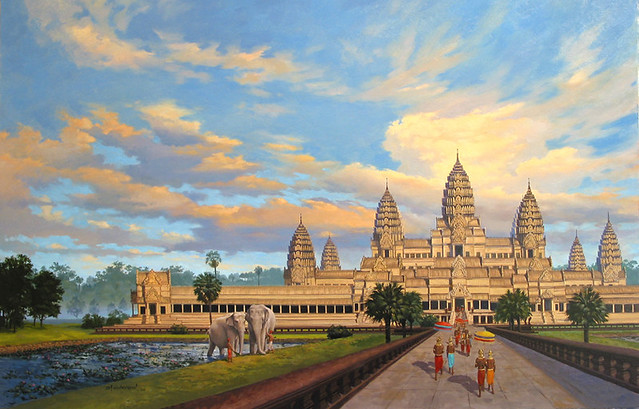
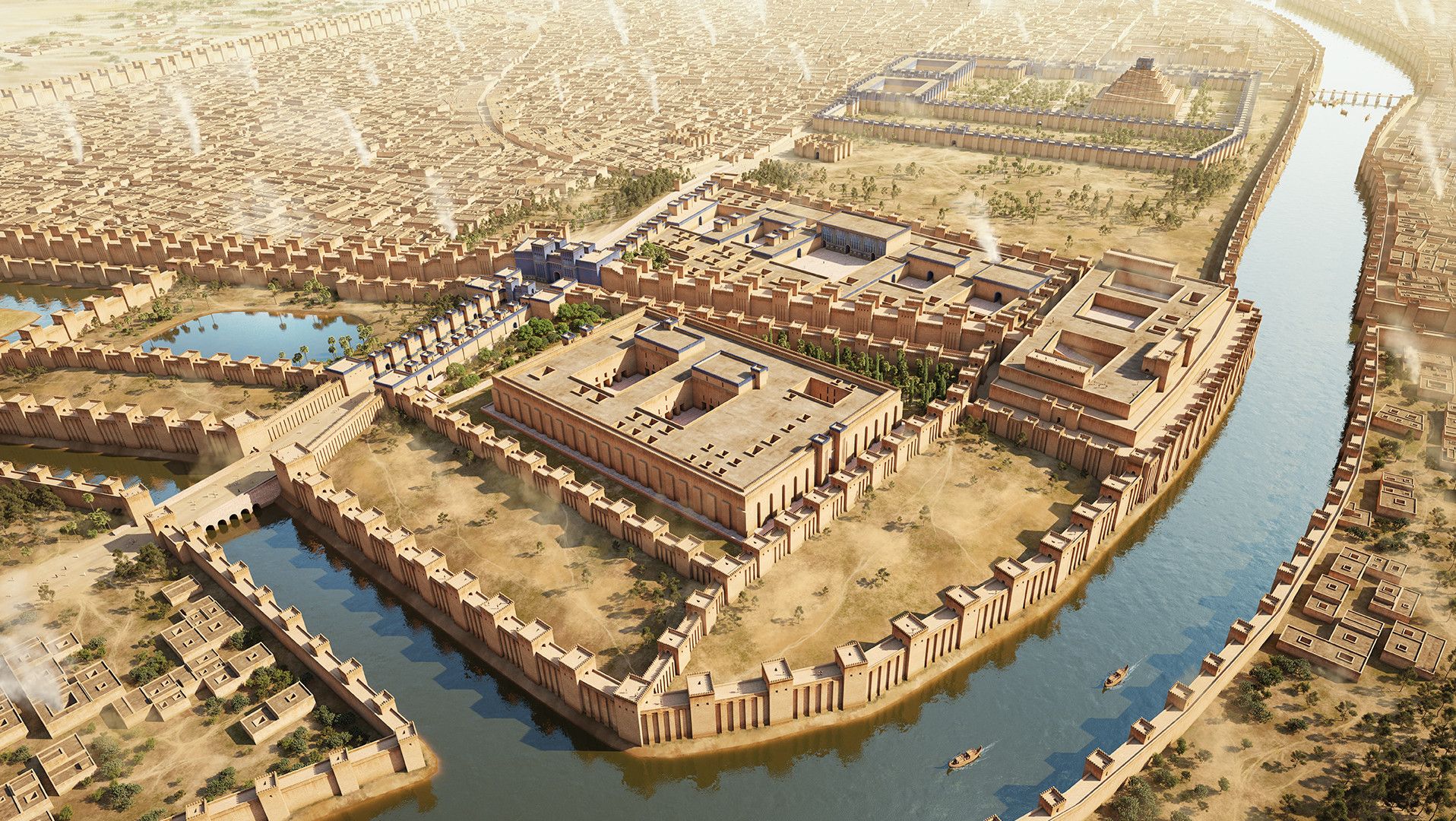
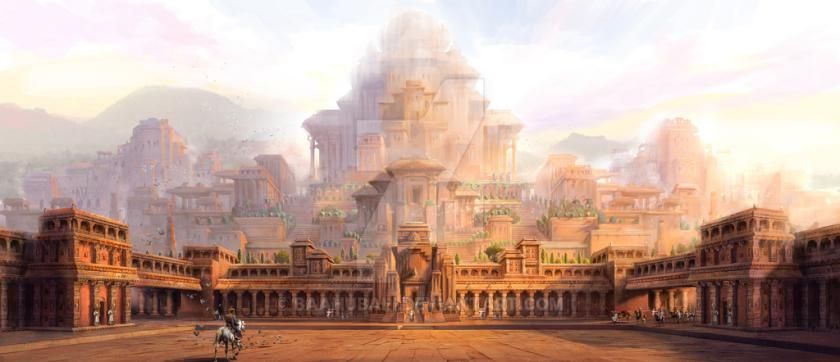
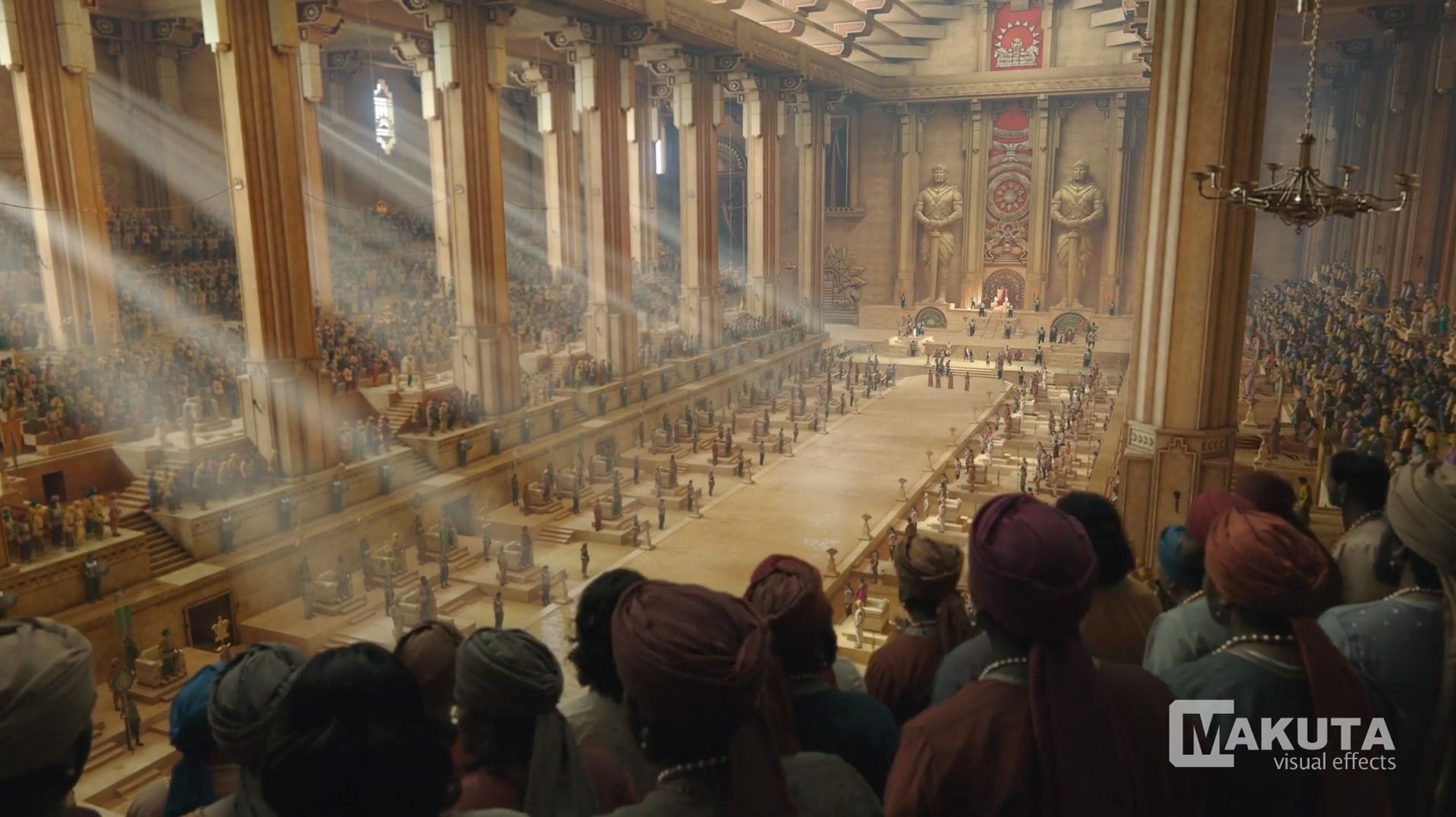
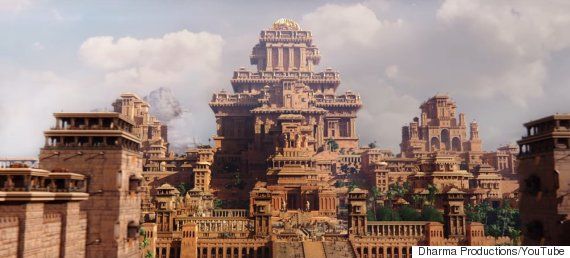
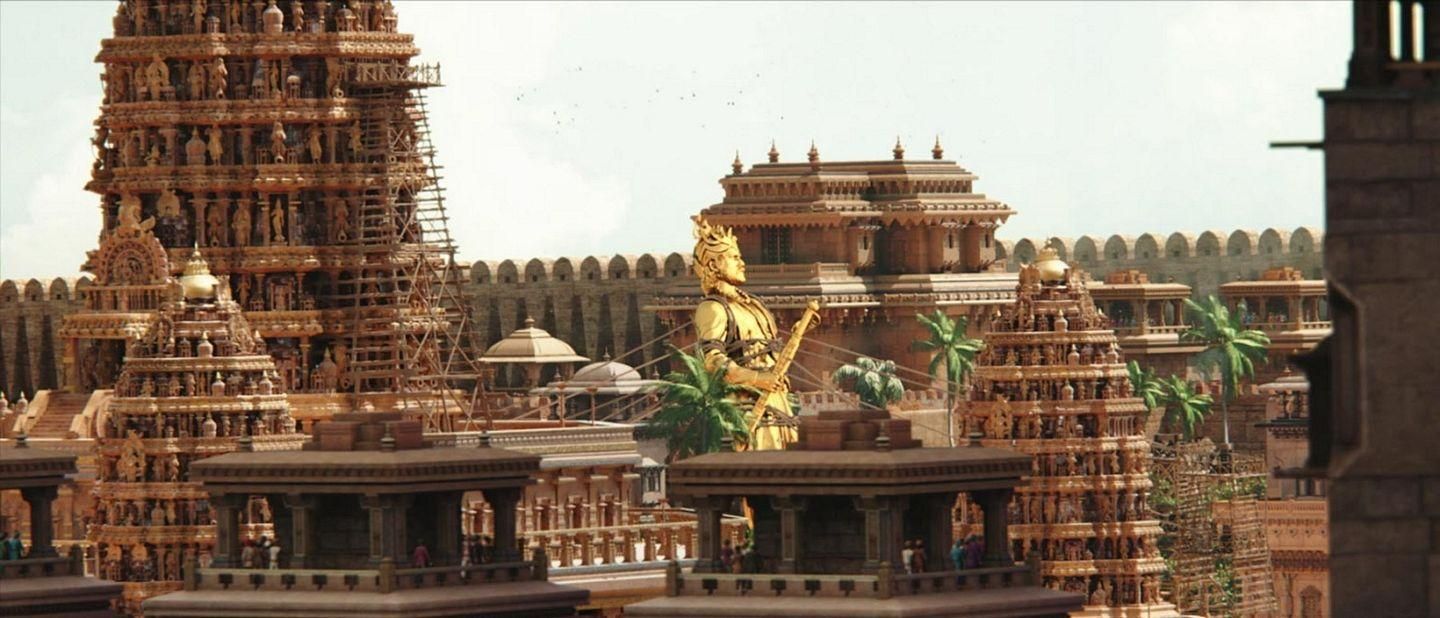
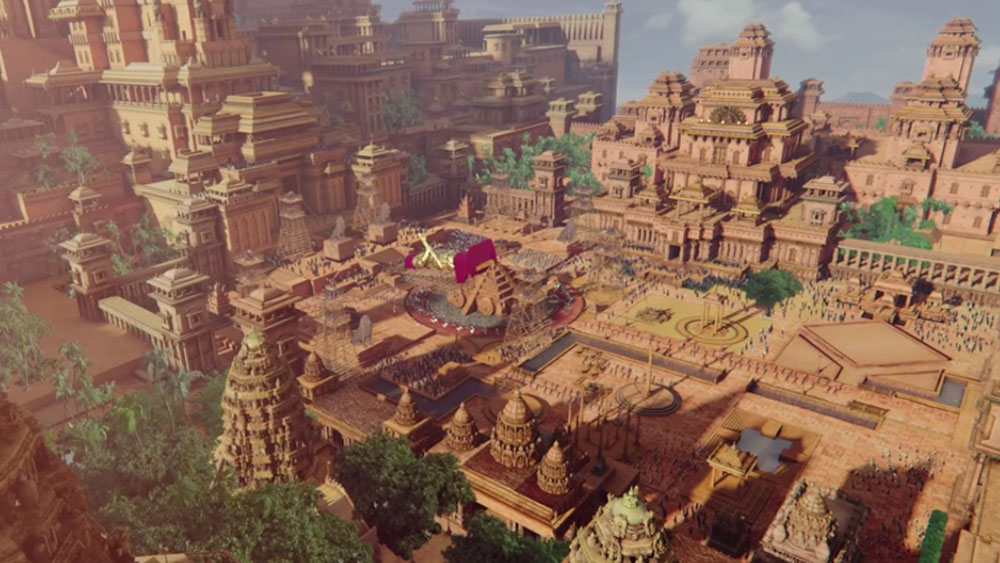
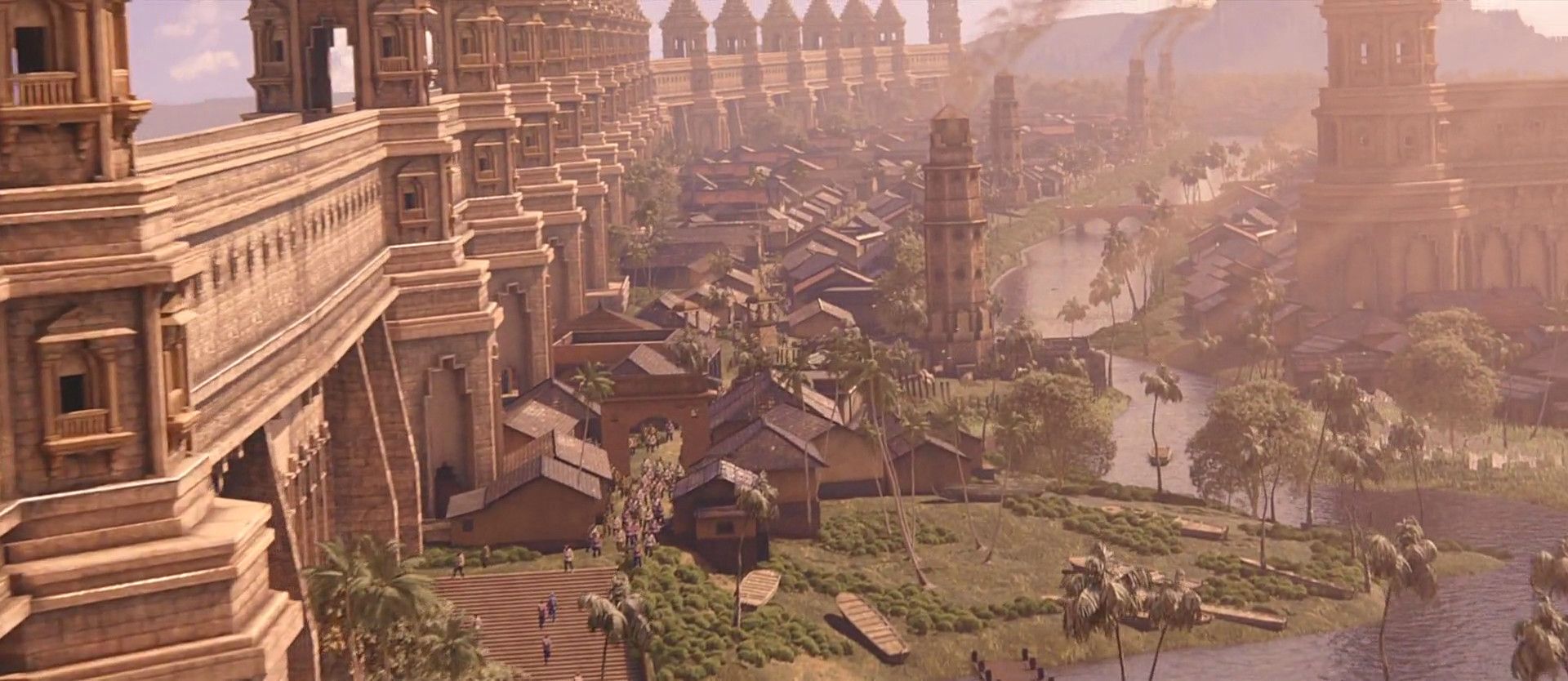
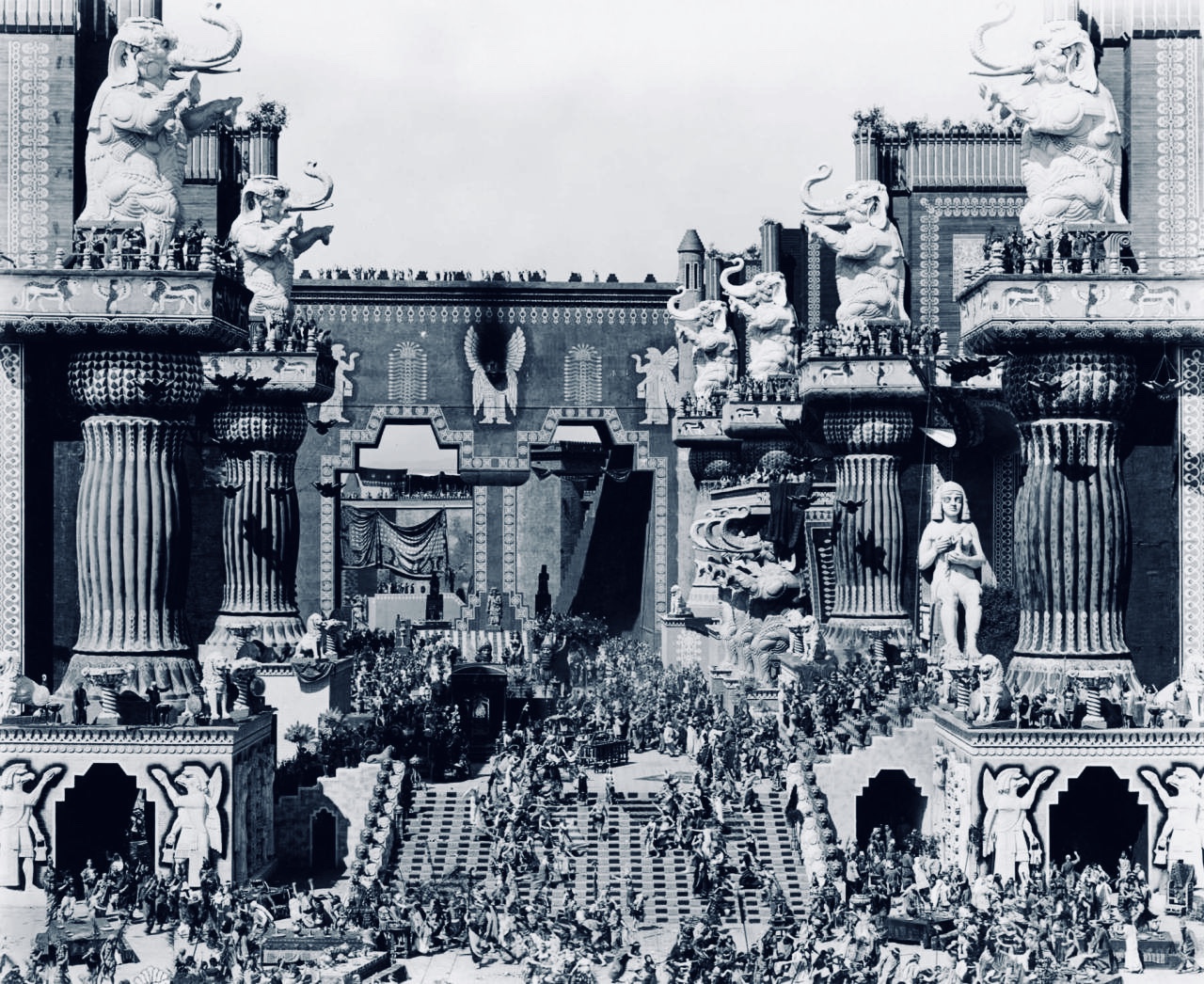
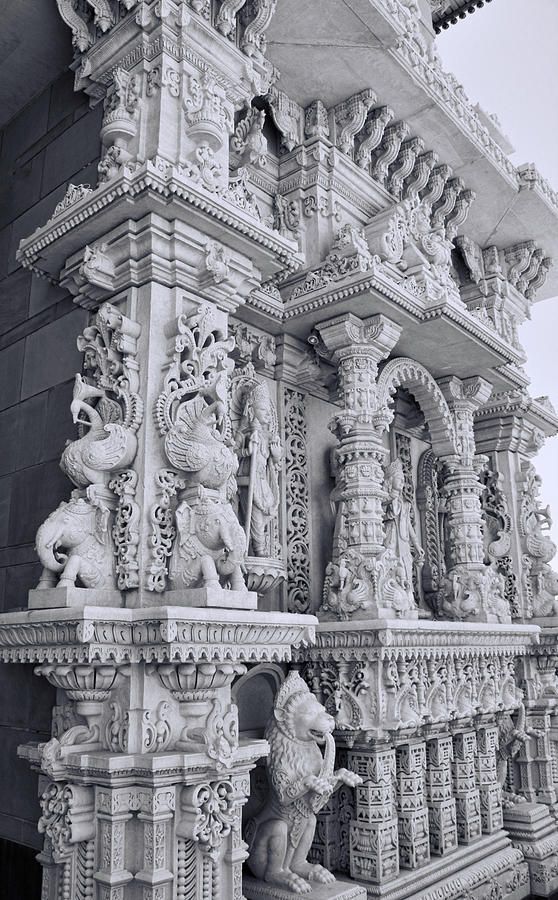
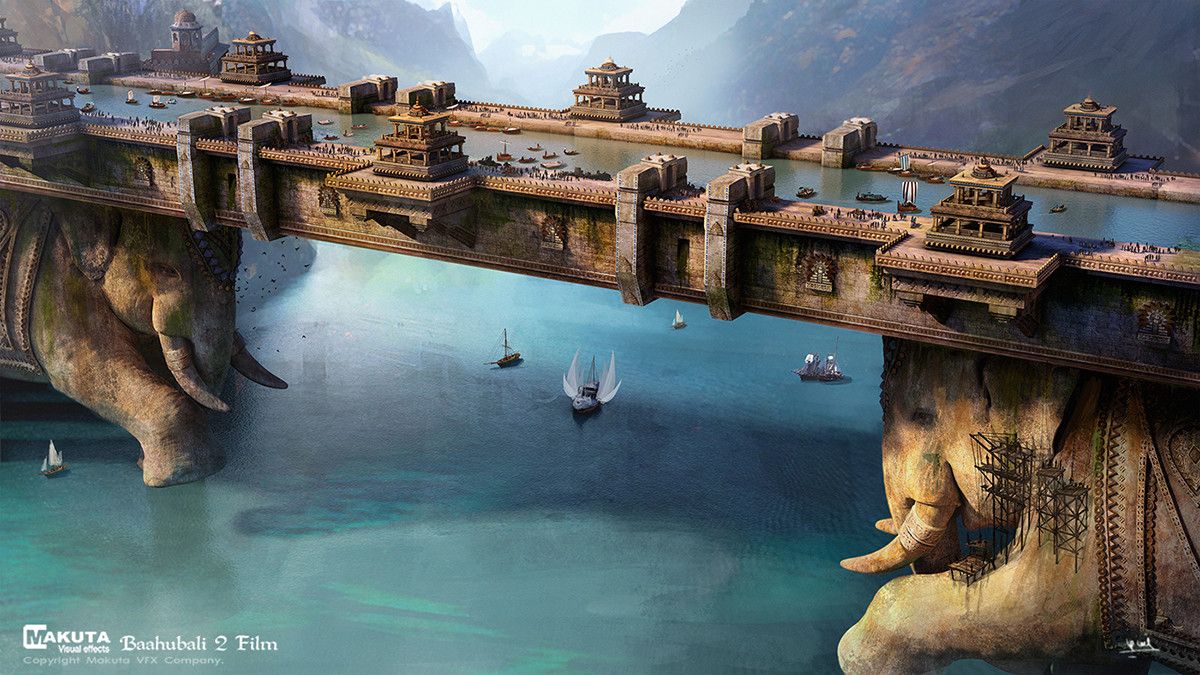
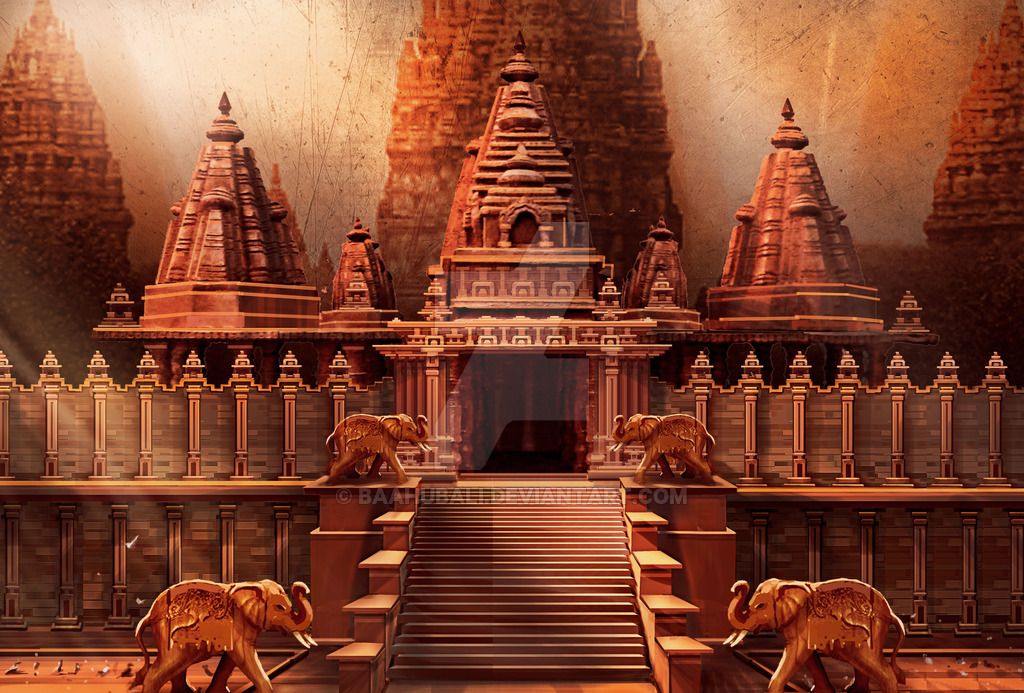
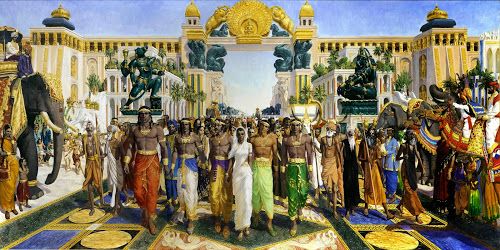
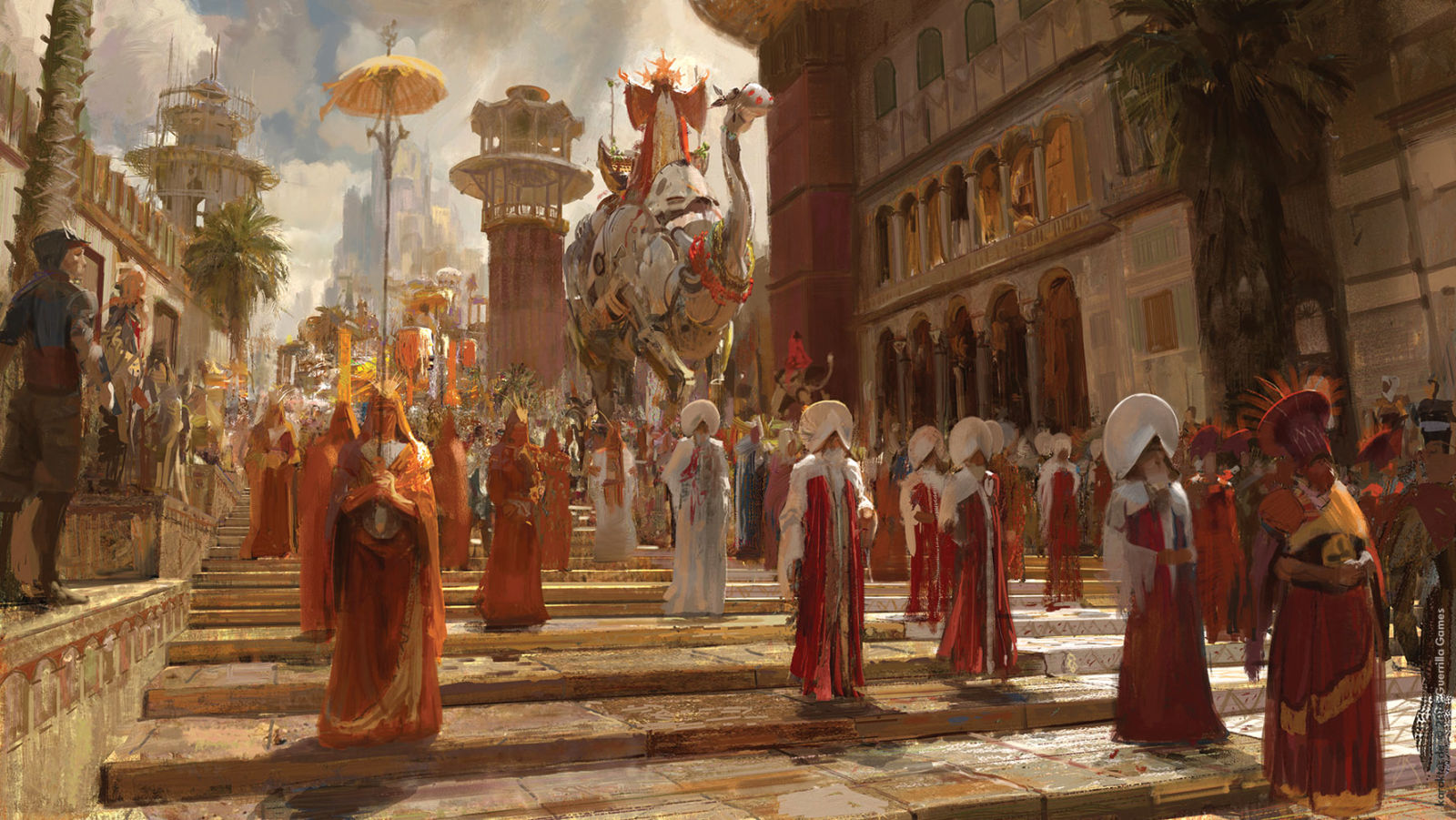
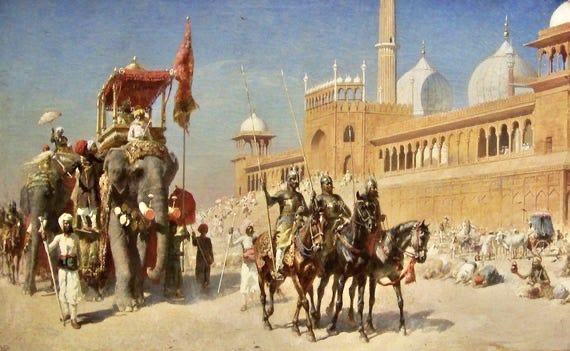
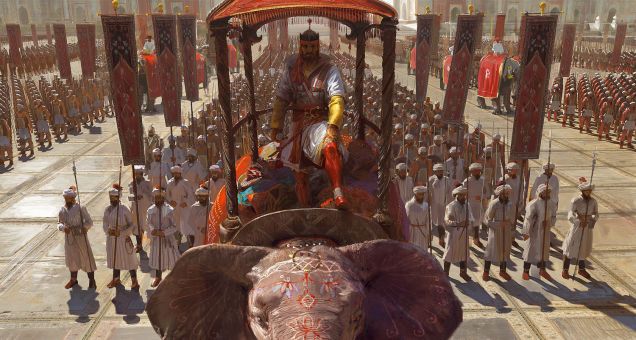
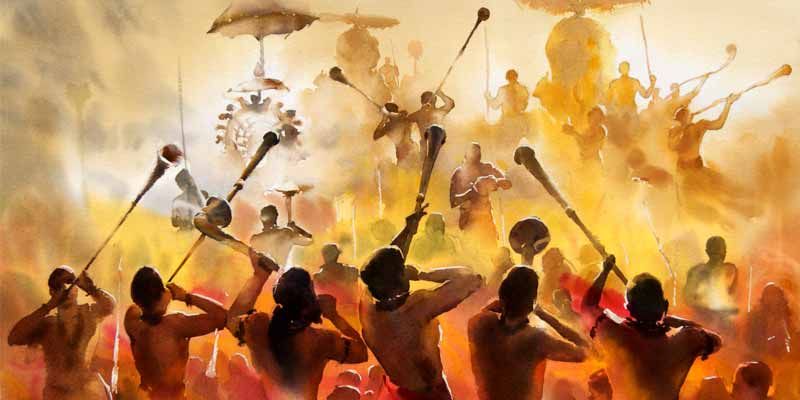
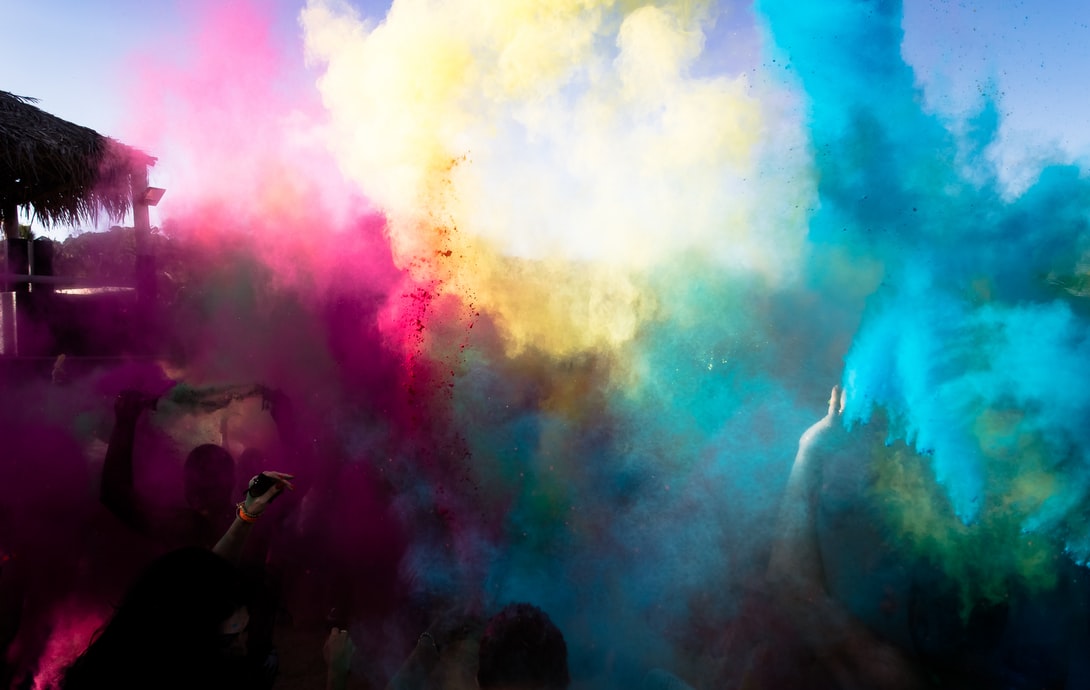
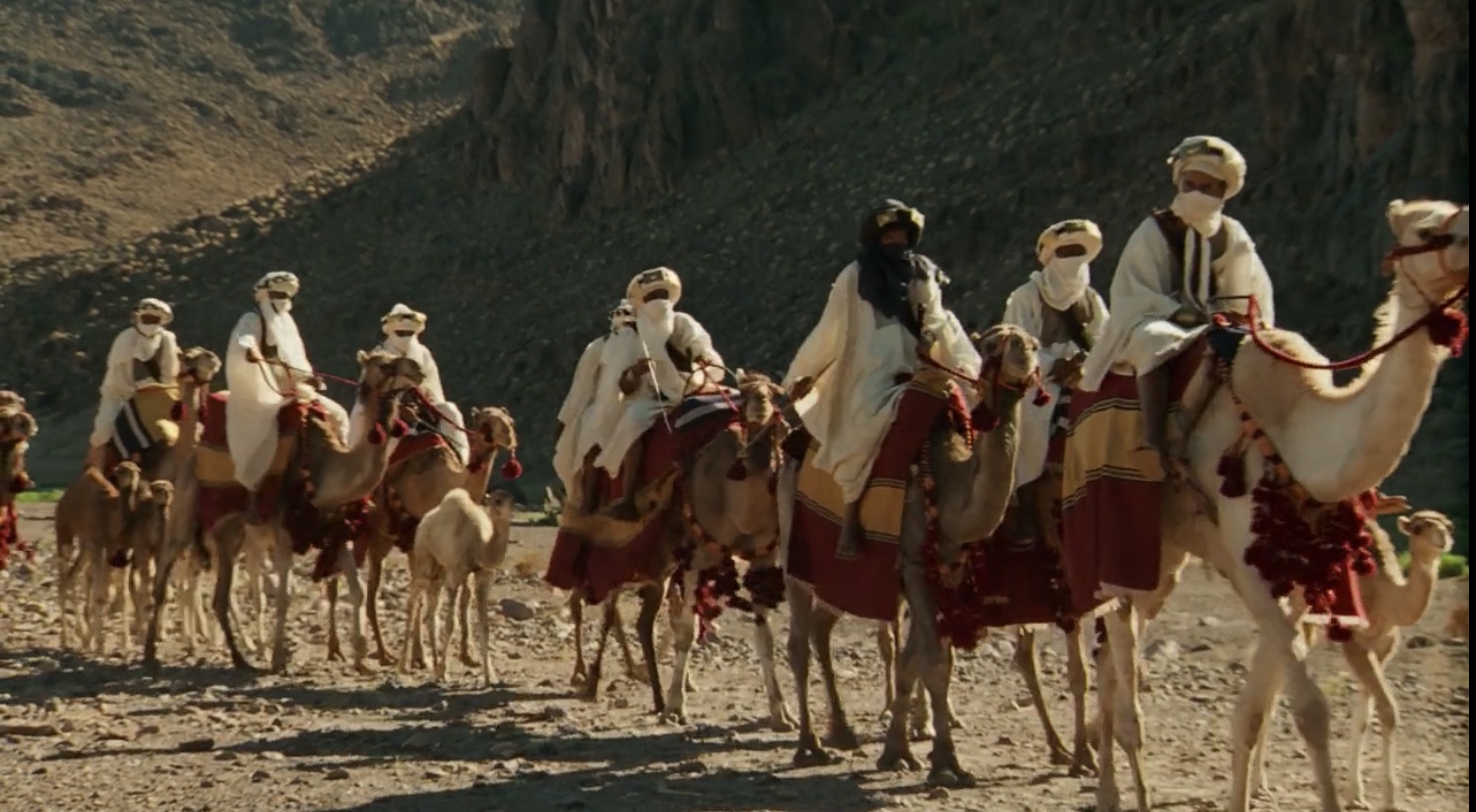
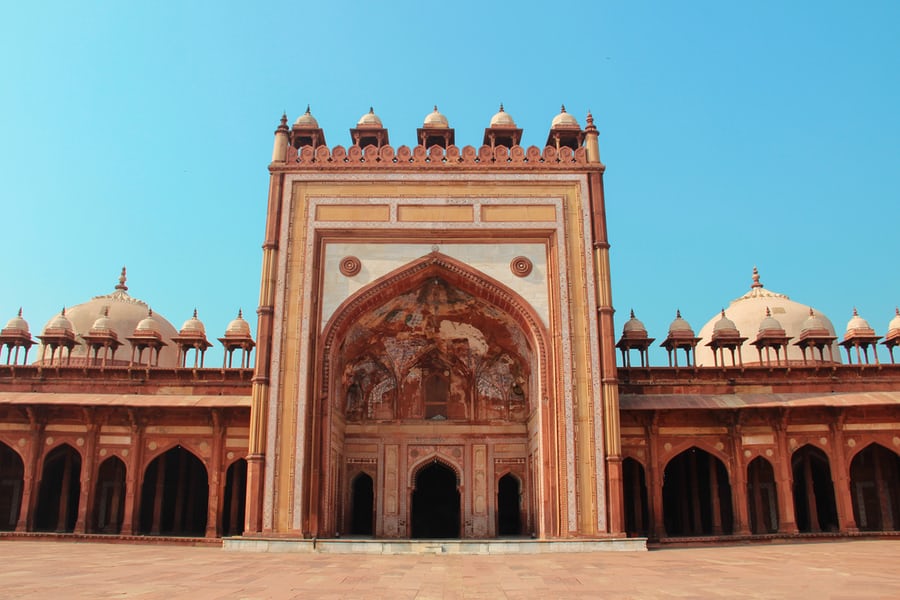
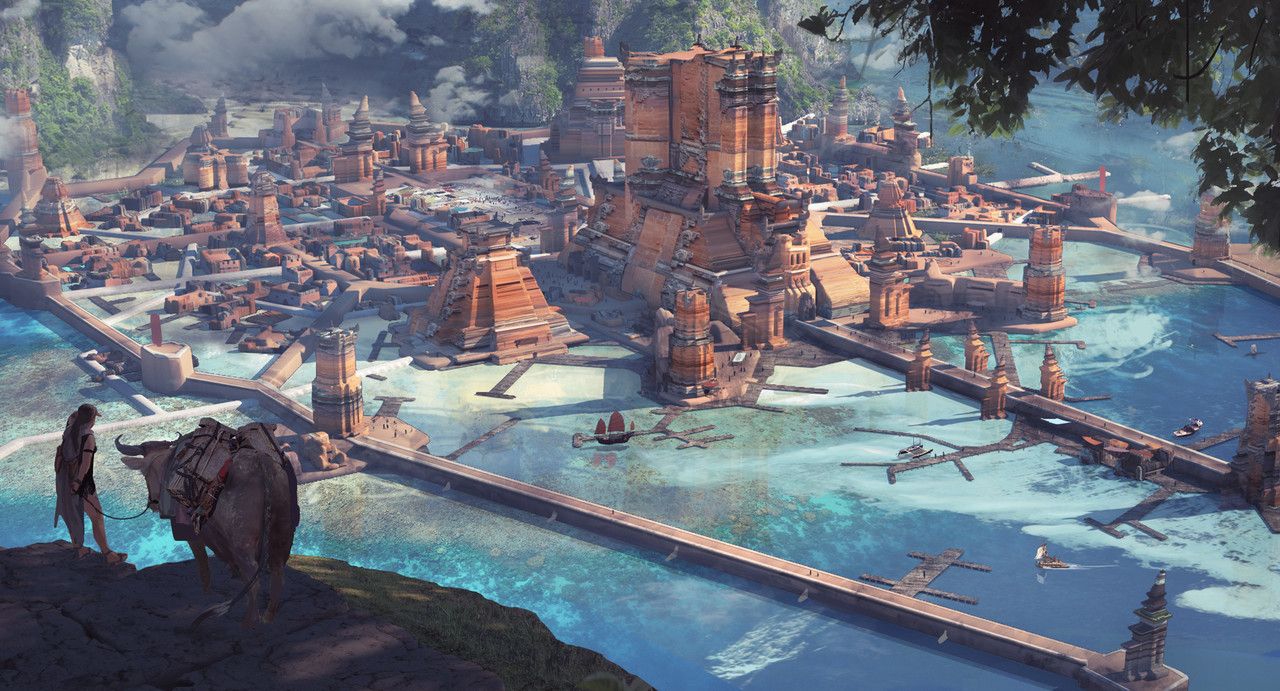
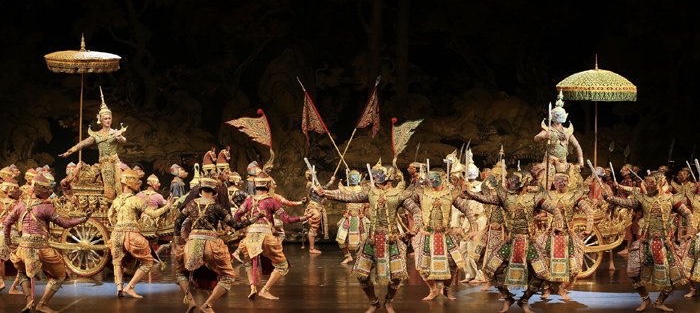
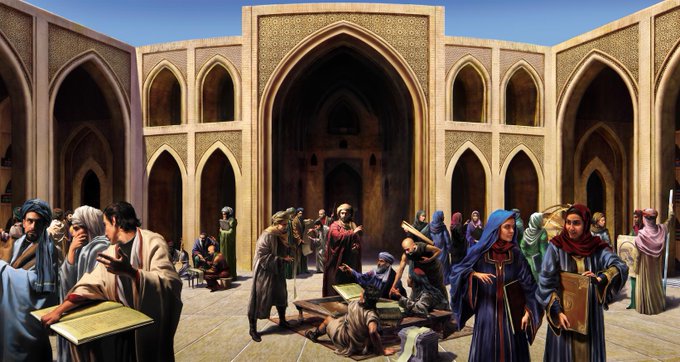
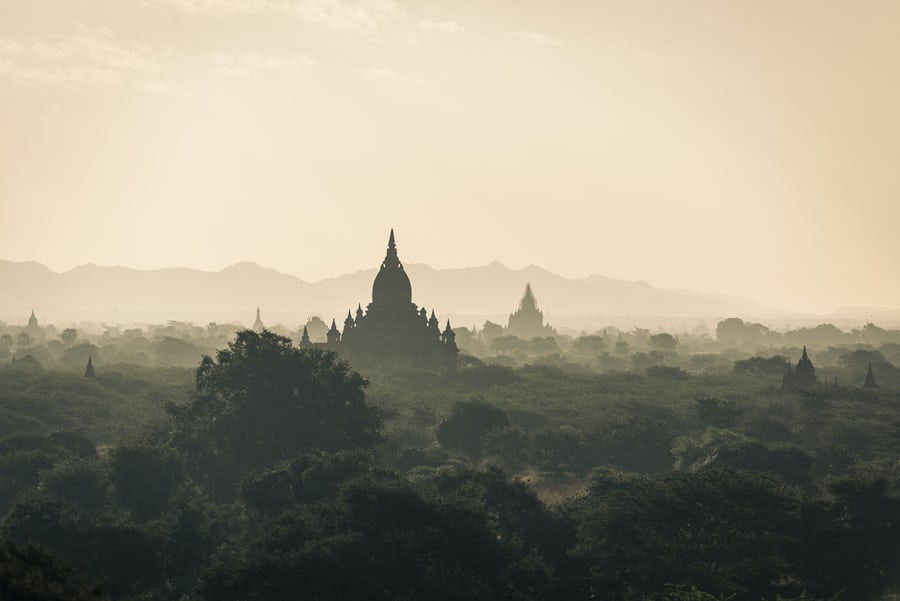

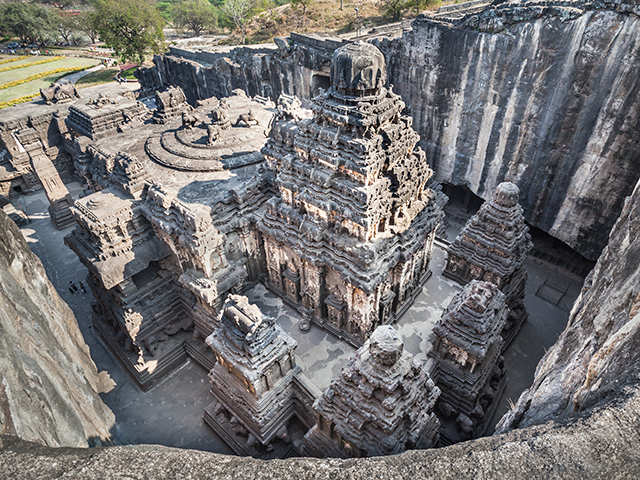
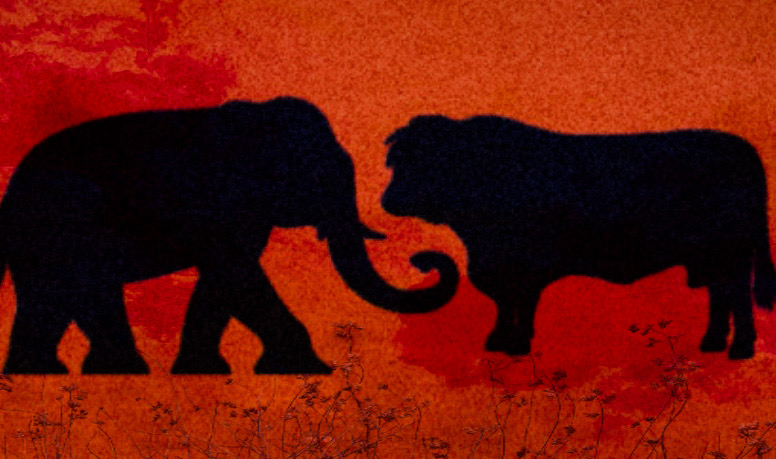
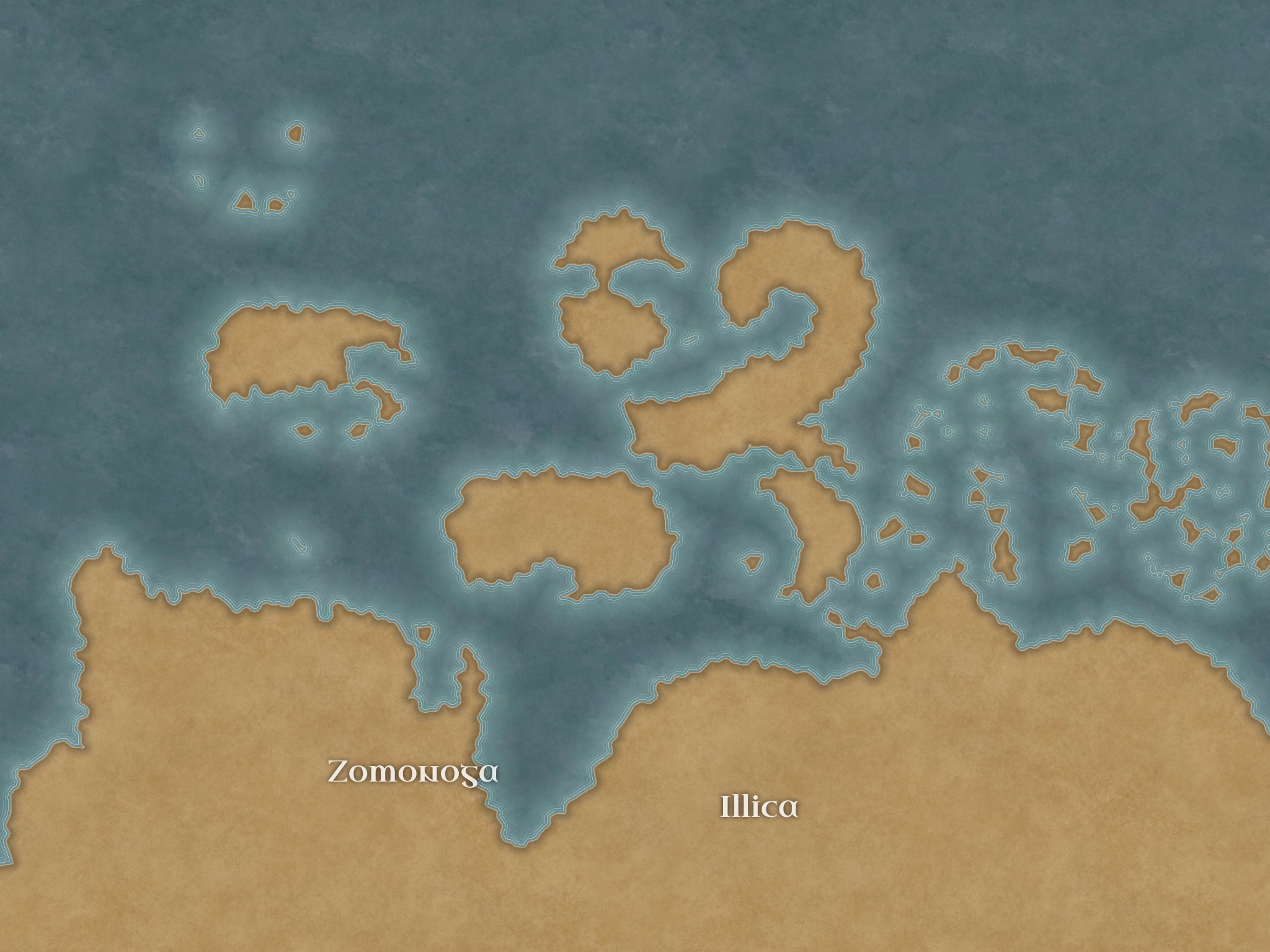
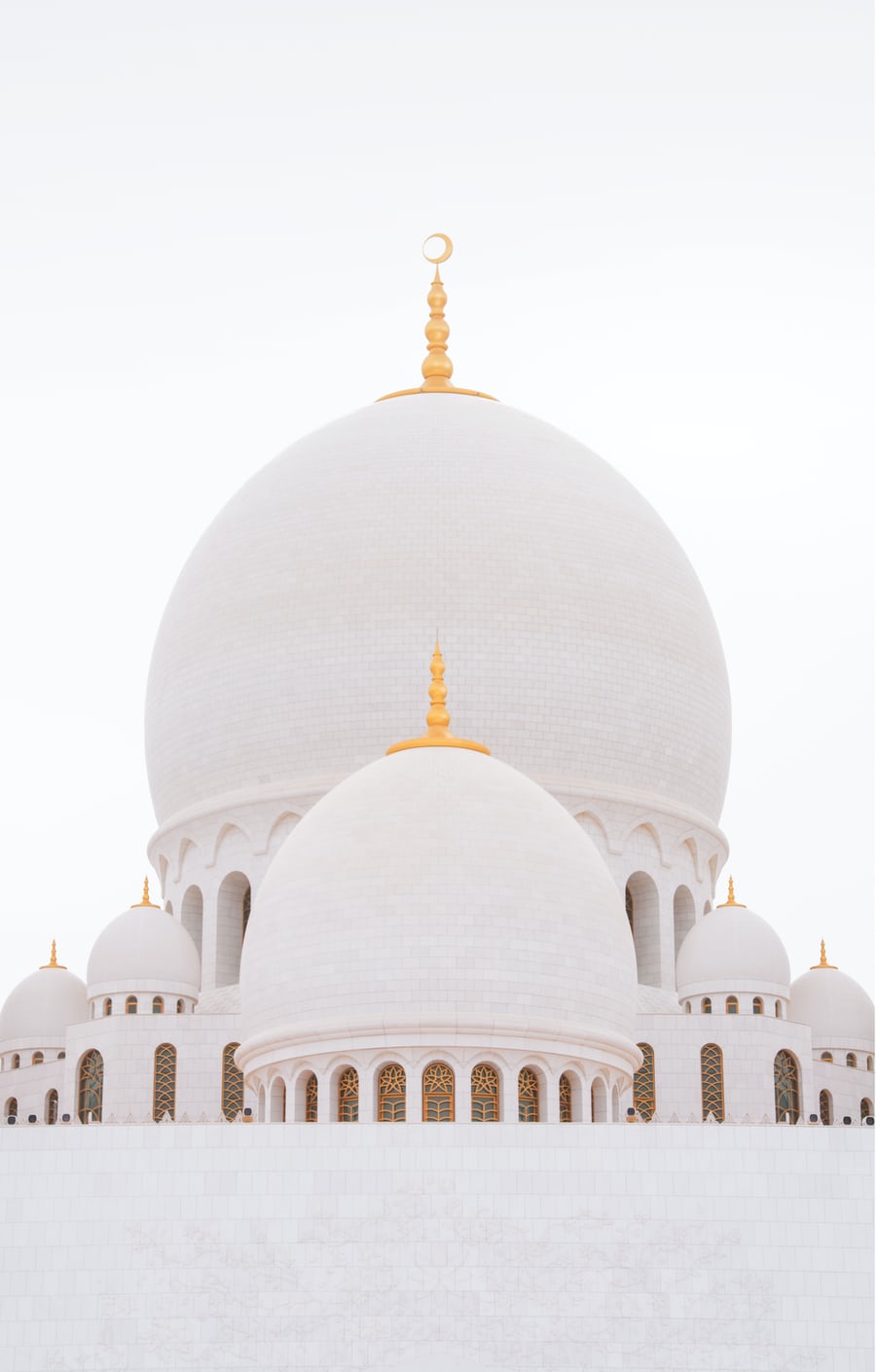
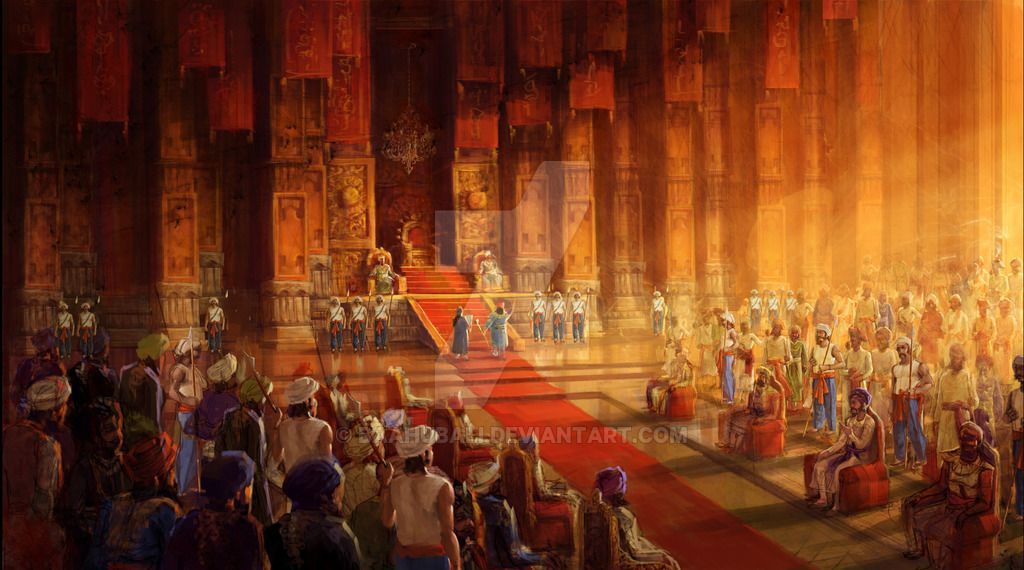
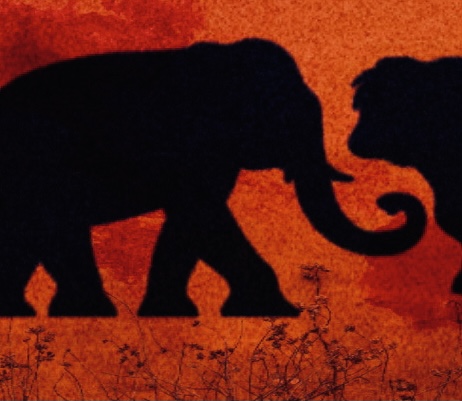
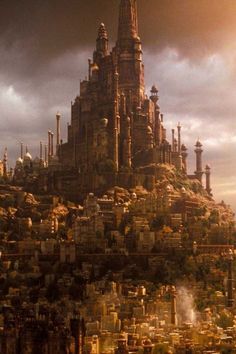
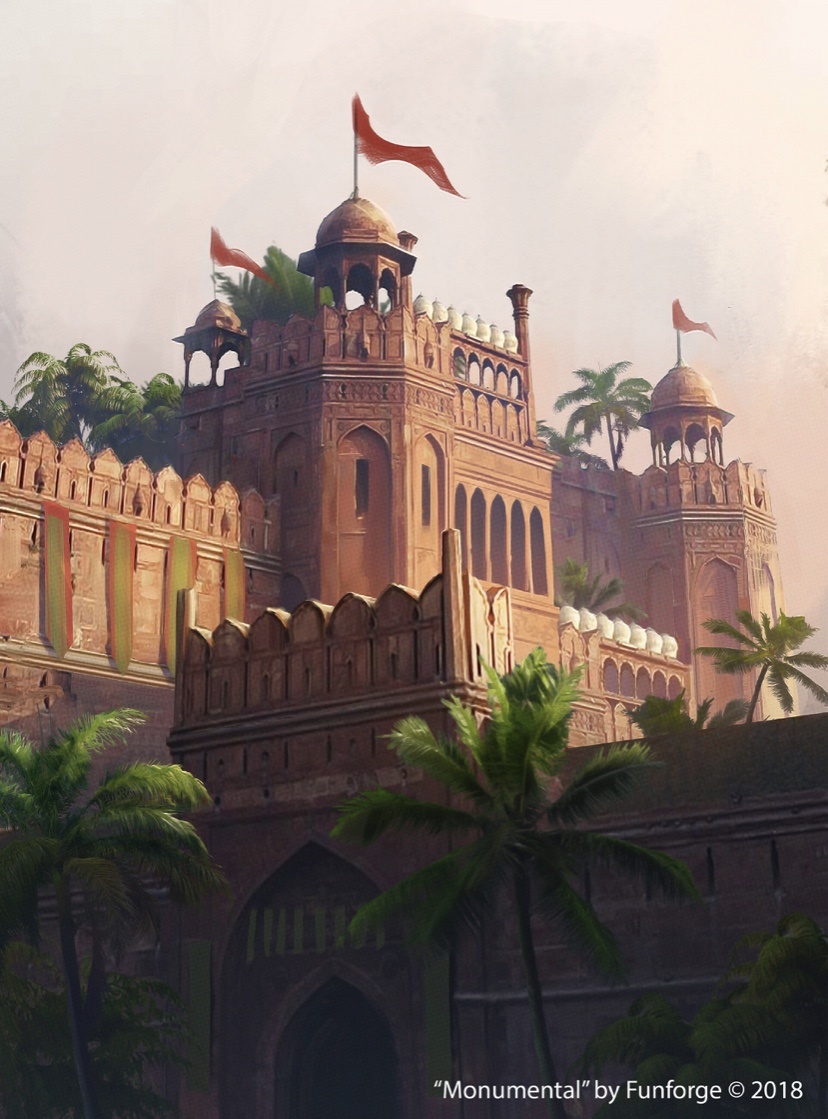
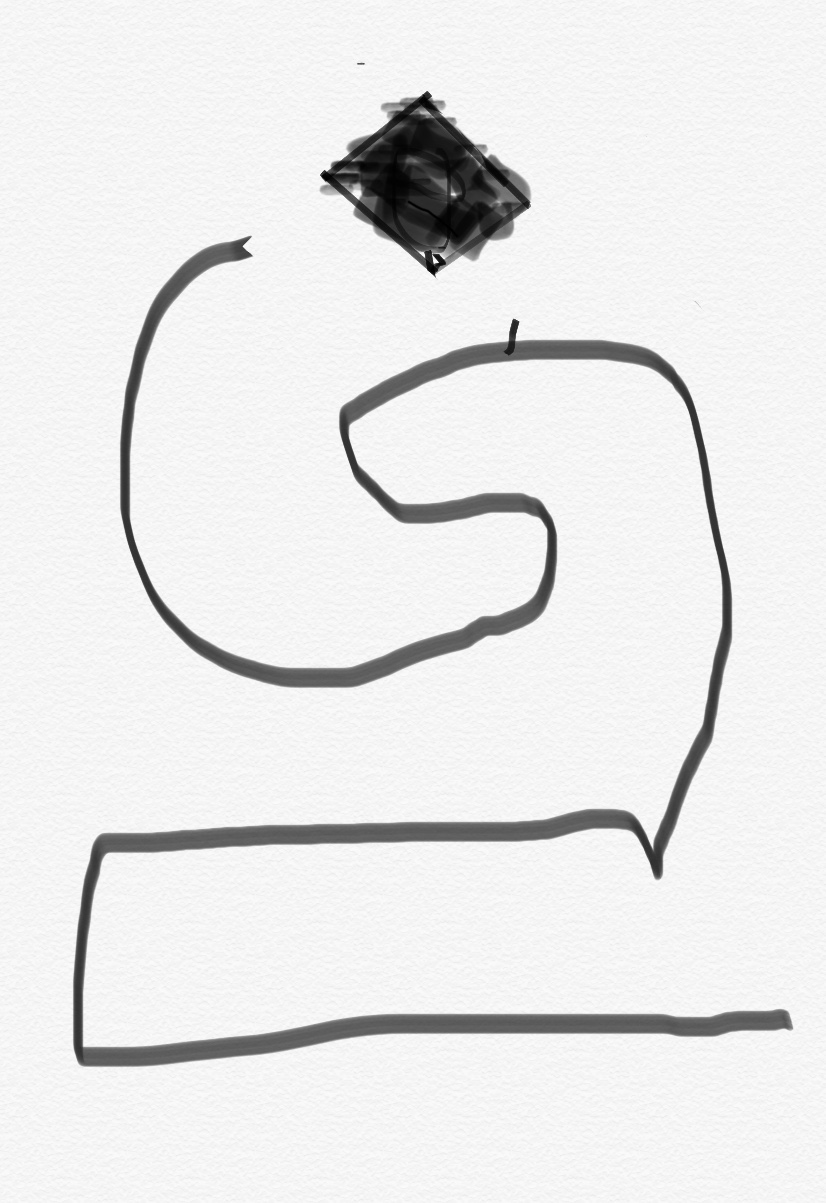
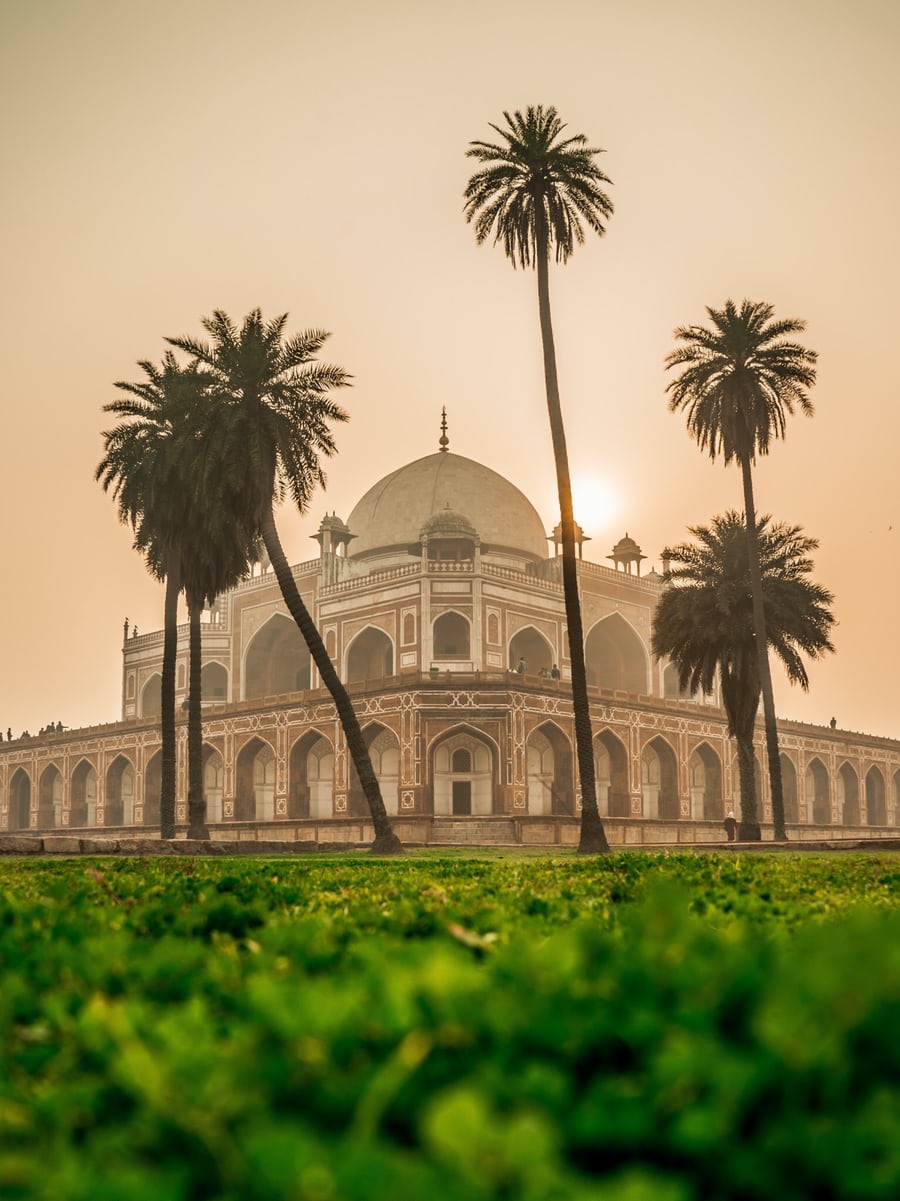
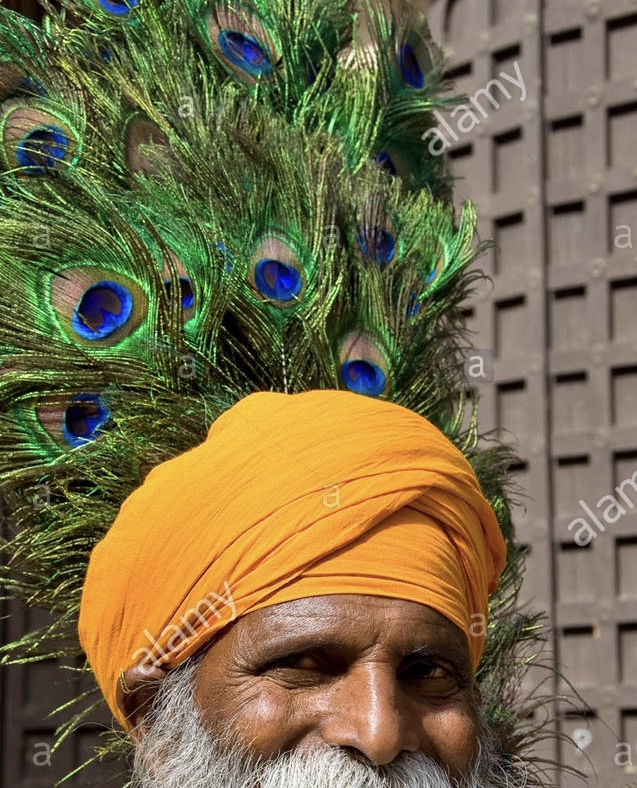
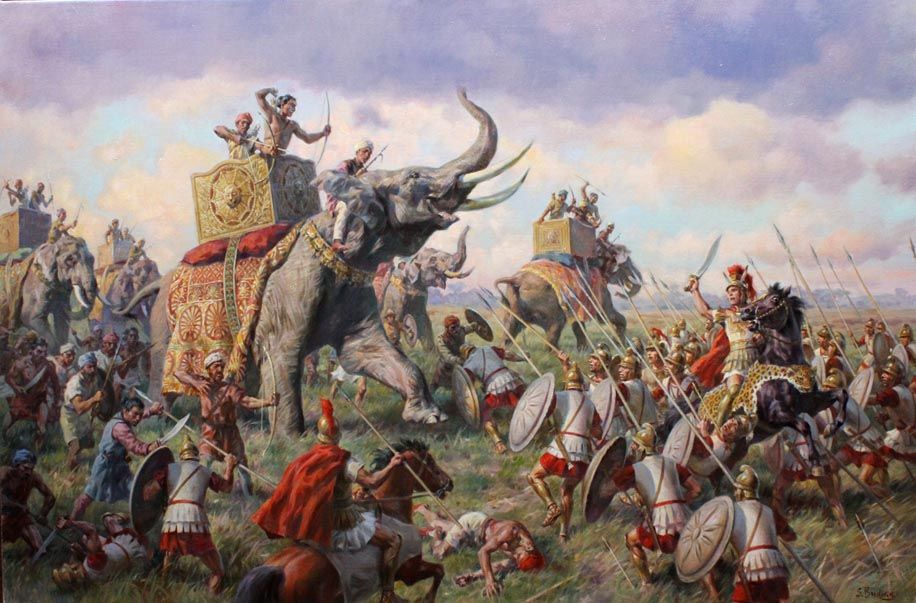
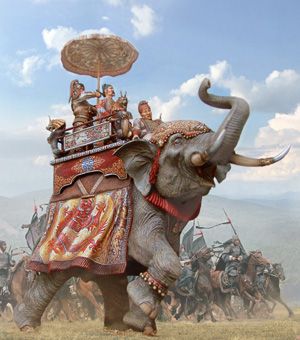
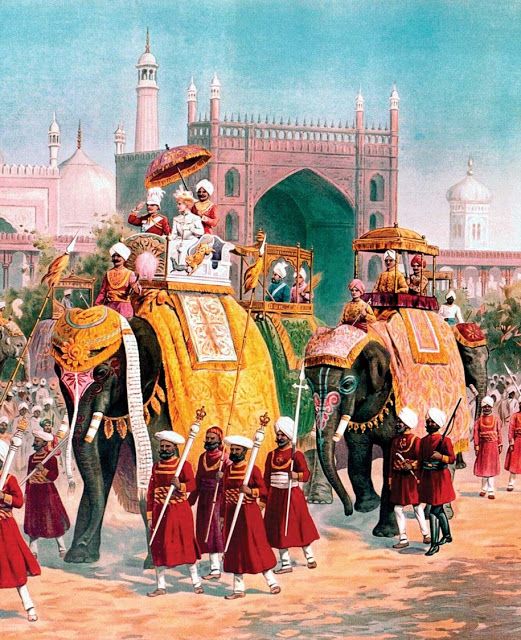
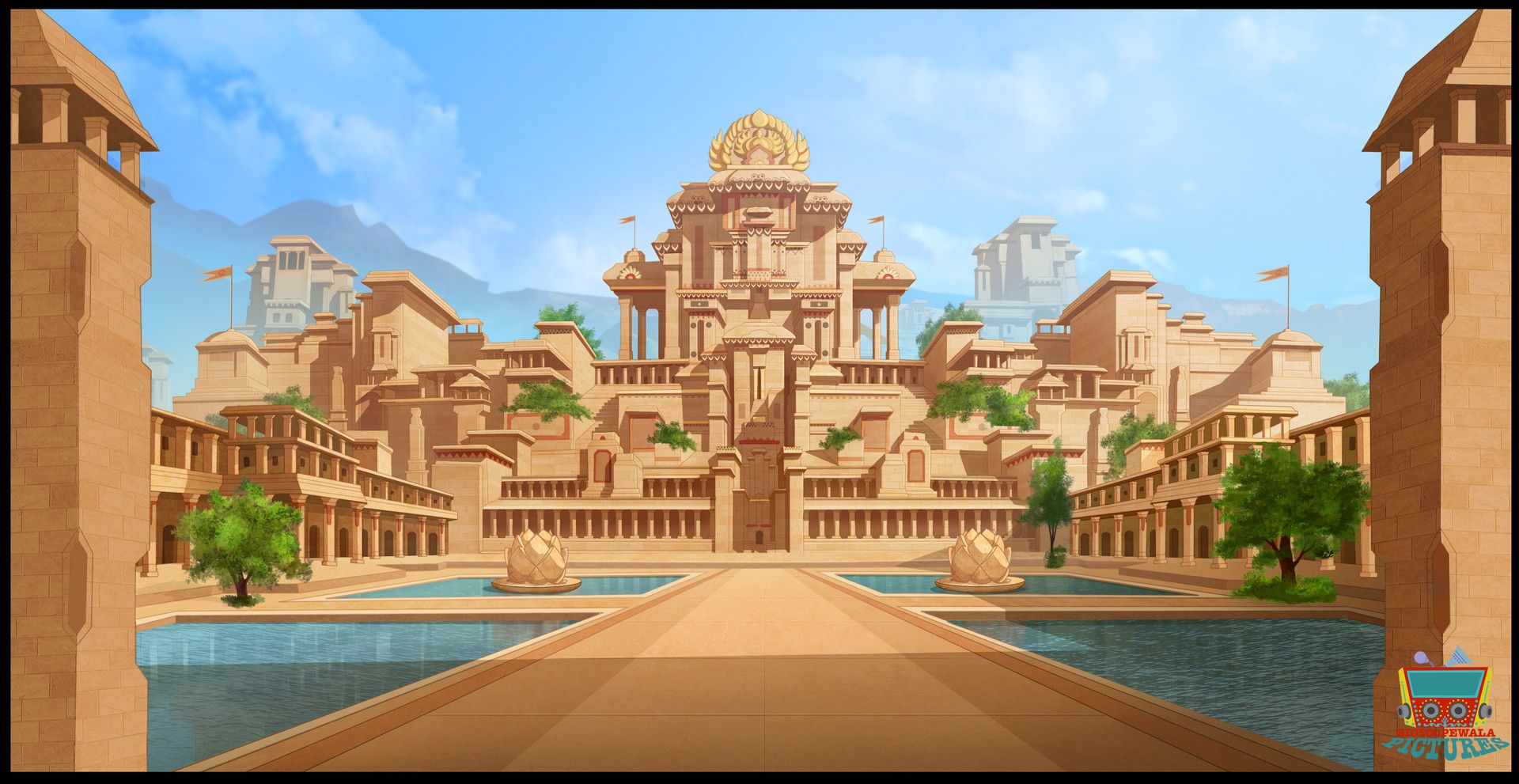
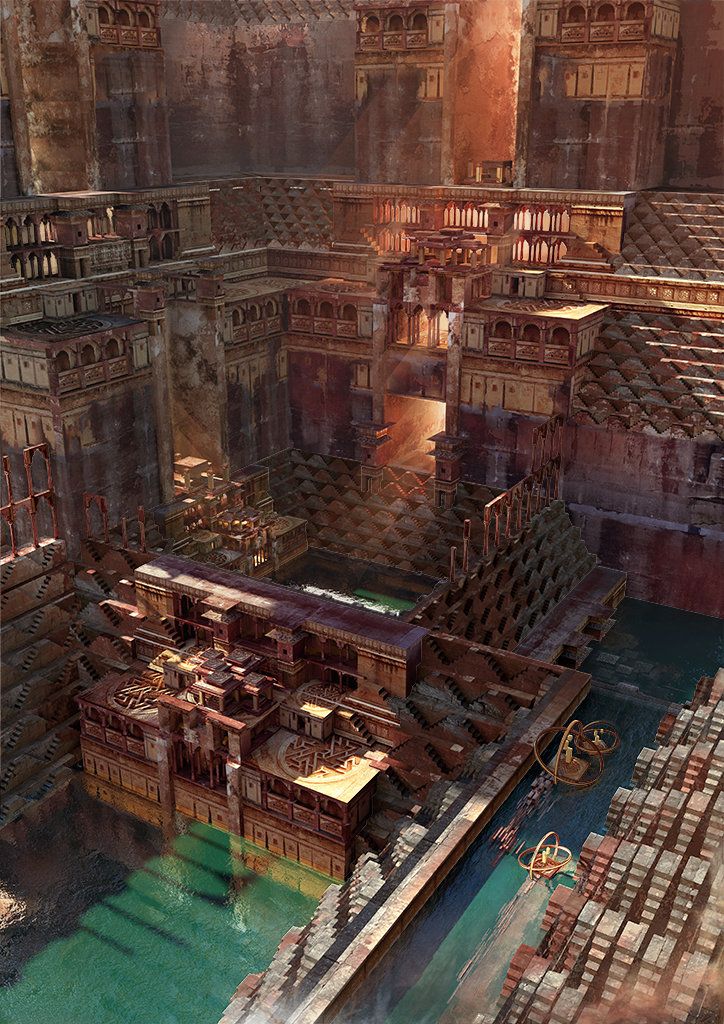
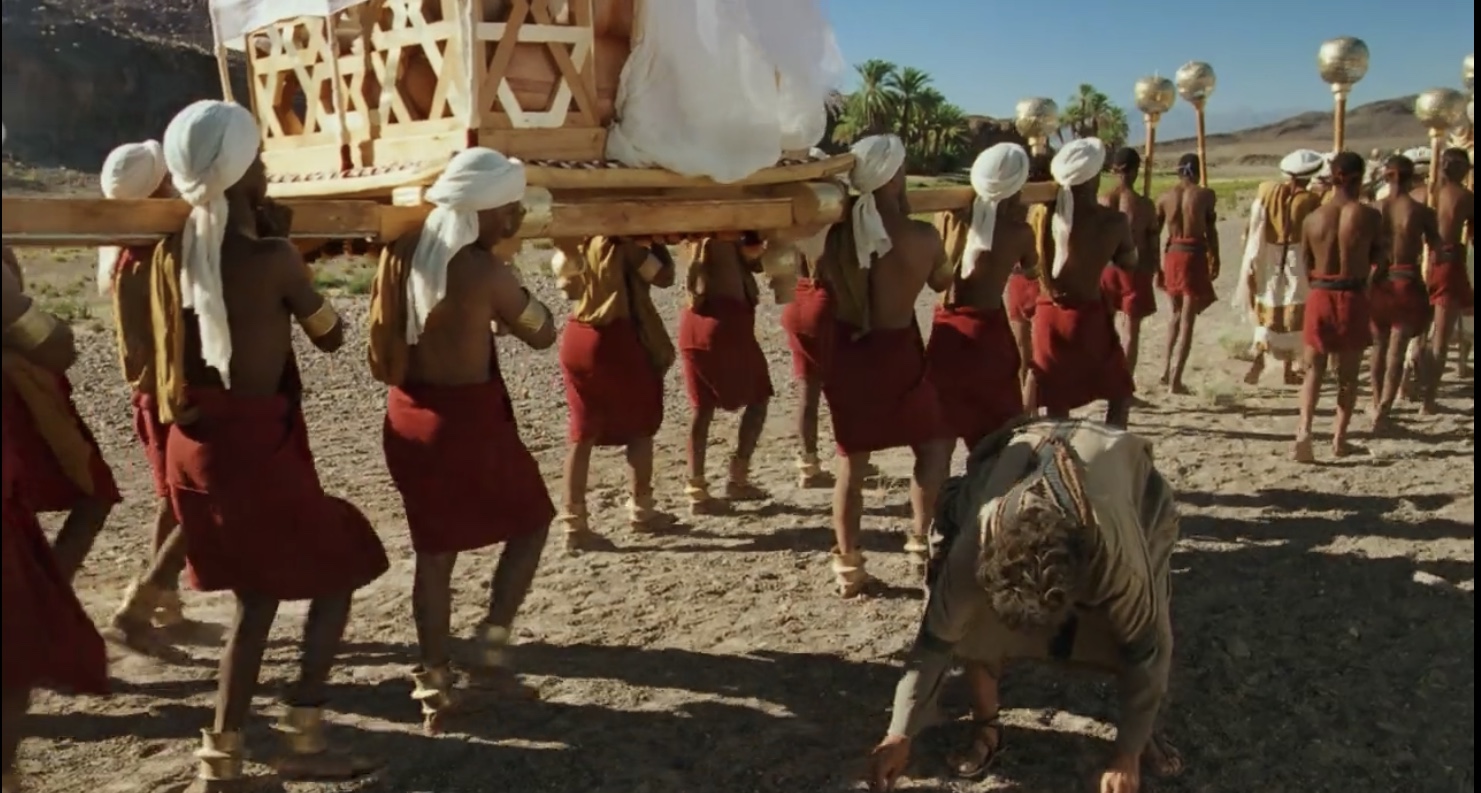
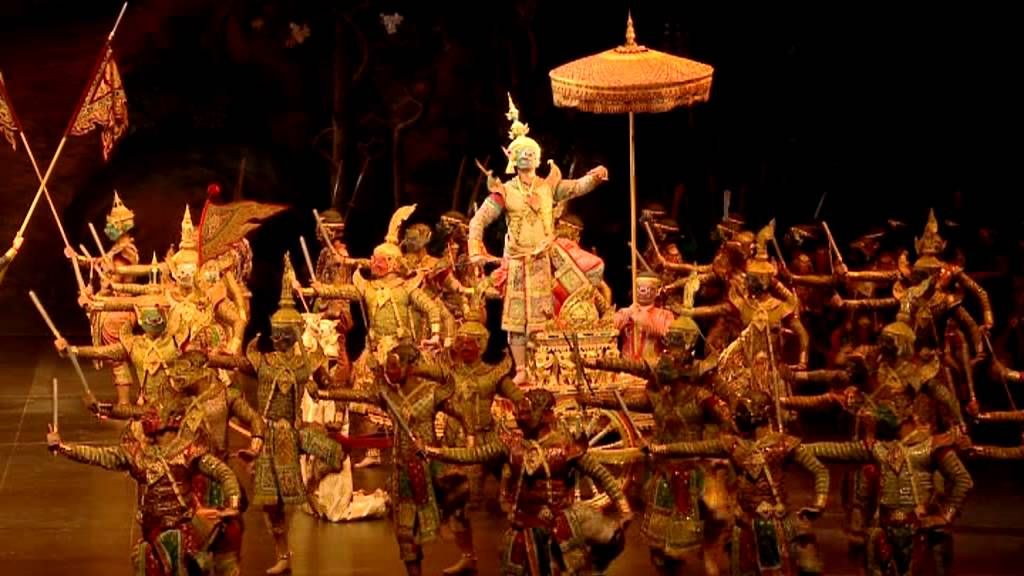







Comments